MitraStar Technology DWA0100 Media Access Gateway User Manual rev3
MitraStar Technology Corporation Media Access Gateway rev3
User Manual_rev3.PDF

SETUP & USER GUIDE DWA0100

2
SETUP & USER GUIDE DWA0100
DWA0100-20170224-0000v0.0
Copyright © 2017 Technicolor. All rights reserved.
This document contains Technicolor proprietary and confidential information. Passing on and copying of this document, use,
extraction and communication of its contents, is not permitted without written authorization from Technicolor.
Table of Contents
1 PRODUCT OVERVIEW .................................................................................................................... 4
1.1 Features ................................................................................................... 4
1.2 Hardware Overview ..................................................................................... 5
1.2.1 Front Panel ............................................................................................ 5
1.2.2 Rear Panel ............................................................................................. 7
2 INSTALLATION ................................................................................................................................ 8
2.1 Connect the Power ...................................................................................... 8
2.2 Connect Wired Devices ................................................................................. 9
2.3 Connect Wireless Devices ............................................................................. 9
2.3.1 WLAN ................................................................................................... 9
2.3.2 Wi-Fi Protected Setup (WPS) ....................................................................... 9
2.4 Connect the Broadband (DSL) ......................................................................... 9
2.4.1 Use a Splitter ........................................................................................ 10
2.5 Check the Installation ................................................................................. 10
3 CONFIGURE THE COMPUTER ..................................................................................................... 11
3.1 Windows XP .............................................................................................. 11
3.2 Windows Vista ........................................................................................... 11
3.3 Windows 7 ............................................................................................... 12
3.4 Windows 8 ............................................................................................... 12
4 ACCESS THE WIRELESS GATEWAY .......................................................................................... 13
4.1 Login ...................................................................................................... 13
4.2 The Interface ............................................................................................ 14
4.3 Using the Menu ......................................................................................... 15
4.4 Configuration Wizard .................................................................................. 15
5 TECHNICOLOR GATEWAY ........................................................................................................... 21
5.1 System Information .................................................................................... 21
5.2 System Configuration .................................................................................. 22
5.2.1 DSL Service Configuration ......................................................................... 22
5.2.2 Time Configuration ................................................................................. 22
5.2.3 Web Browsing Interception........................................................................ 23
5.3 Event Logs ............................................................................................... 23
6 BROADBAND CONNECTION ........................................................................................................ 24
6.1 DSL Connection ......................................................................................... 24
6.2 Internet Services ....................................................................................... 25
7 TOOLBOX ....................................................................................................................................... 26
7.1 Remote Assistance ..................................................................................... 26
7.1.1 Enable Remote Assistance ......................................................................... 26

3
SETUP & USER GUIDE DWA0100
DWA0100-20170224-0000v0.0
Copyright © 2017 Technicolor. All rights reserved.
This document contains Technicolor proprietary and confidential information. Passing on and copying of this document, use,
extraction and communication of its contents, is not permitted without written authorization from Technicolor.
7.1.2 Disable Remote Assistance ........................................................................ 27
7.2 Game & Application Sharing .......................................................................... 27
7.2.1 Assign a Game or Application ..................................................................... 28
7.2.2 Modify Assigned Game or Application ........................................................... 29
7.2.3 Create a New Game or Application .............................................................. 29
7.2.4 Modify a Game or Application .................................................................... 30
7.3 Parental Control ........................................................................................ 31
7.4 Firewall ................................................................................................... 32
7.4.1 Change Firewall Security Level ................................................................... 32
7.4.2 Create a New Security Level ...................................................................... 32
7.4.3 Set Filter Rules ...................................................................................... 33
7.5 Intrusion Detection .................................................................................... 34
7.6 Dynamic DNS ............................................................................................ 34
7.7 User Management ...................................................................................... 36
7.7.1 Add New User ....................................................................................... 36
7.7.2 Reset Password ...................................................................................... 37
7.7.3 Manage Users ........................................................................................ 37
7.8 Content Sharing ......................................................................................... 37
7.8.1 Setting up a Network File Server ................................................................. 38
7.8.2 Setting up the Technicolor UPnP AV Server .................................................... 39
7.8.3 Setting up an FTP Server .......................................................................... 39
7.8.4 Unmounting Your USB Device ..................................................................... 39
7.9 DMZ ........................................................................................................ 40
8 HOME NETWORK .......................................................................................................................... 41
8.1 Devices ................................................................................................... 41
8.1.1 View or Modify Device Information .............................................................. 41
8.1.2 Assign Game or Application to Device ........................................................... 42
8.1.3 Remove a Shared Game or Application.......................................................... 42
8.1.4 Assign a Public IP Address to Device ............................................................. 42
8.2 Interfaces ................................................................................................ 43
8.2.1 Local Network Interface ........................................................................... 43
8.2.2 Wireless Access Point .............................................................................. 44
9 HELP ............................................................................................................................................... 47
APPENDIX A WIRELESS CONSIDERATIONS ................................................................................. 48
APPENDIX B SAFETY INSTRUCTIONS ............................................................................................ 49
APPENDIX C SPECIFICATIONS ........................................................................................................ 52

4
SETUP & USER GUIDE DWA0100
DWA0100-20170224-0000v0.0
Copyright © 2017 Technicolor. All rights reserved.
This document contains Technicolor proprietary and confidential information. Passing on and copying of this document, use,
extraction and communication of its contents, is not permitted without written authorization from Technicolor.
1 Product Overview
Thank you for choosing Technicolor Media Access Gateway. This Wireless Gateway combines the
functionality of a VDSL2 / ADSL2 modem and Internet gateway in one. The various security features, such
as WPS, WPA2, SPI, and NAT, protect your data and privacy online. The web-based utility allows you to
configure your Wireless Gateway easily.
1.1 Features
▪ Compliant with ITU G.993.2 (VDSL2) standard
▪ Compliant with ITU G.998.4 (G.inp)
▪ Compliant with ITU G.993.5 (G.vector)
▪ Supports 8a, 8b, 8c, 8d, 12a, 12b, 17a, and 30a profiles
▪ Supports ATM and PTM modes
▪ Supports Ethernet WAN
▪ Supports 3G dongle
▪ Supports DLNA
▪ Supports Print Server
▪ Supports SAMBA
▪ Supports USB disk/USB flash
▪ Compliant with ADSL G.dmt (G.992.1), G.lite (G.992.2) standards
▪ Compliant with ADSL2 G.dmt.bis (G.992.3) and ADSL2 + G.992.4 standards
▪ Up to Up to 24Mbps downstream, 1.2Mbps upstream with ADSL2+ service
▪ IEEE 802.11b/g/n infrastructure operating modes
▪ Supports IPv4 and IPv6 protocols
▪ Supports web-based configuration
▪ Supports Command Line Interface (CLI) via Telnet
▪ Supports NAT, SPI
▪ Supports VLAN and QoS
▪ Supports firewall protection
▪ Supports up to 8 permanent virtual circuits (PVC)
▪ Supports Wi-Fi Multimedia (WMM)
▪ Supports Wi-Fi Protected Setup (WPS) for easy connection
▪ Supports wireless data encryption with 64/128-bit WEP standard
▪ Supports enhanced security for WPA-TKIP, WPA2-AES, WPA, and WPA2
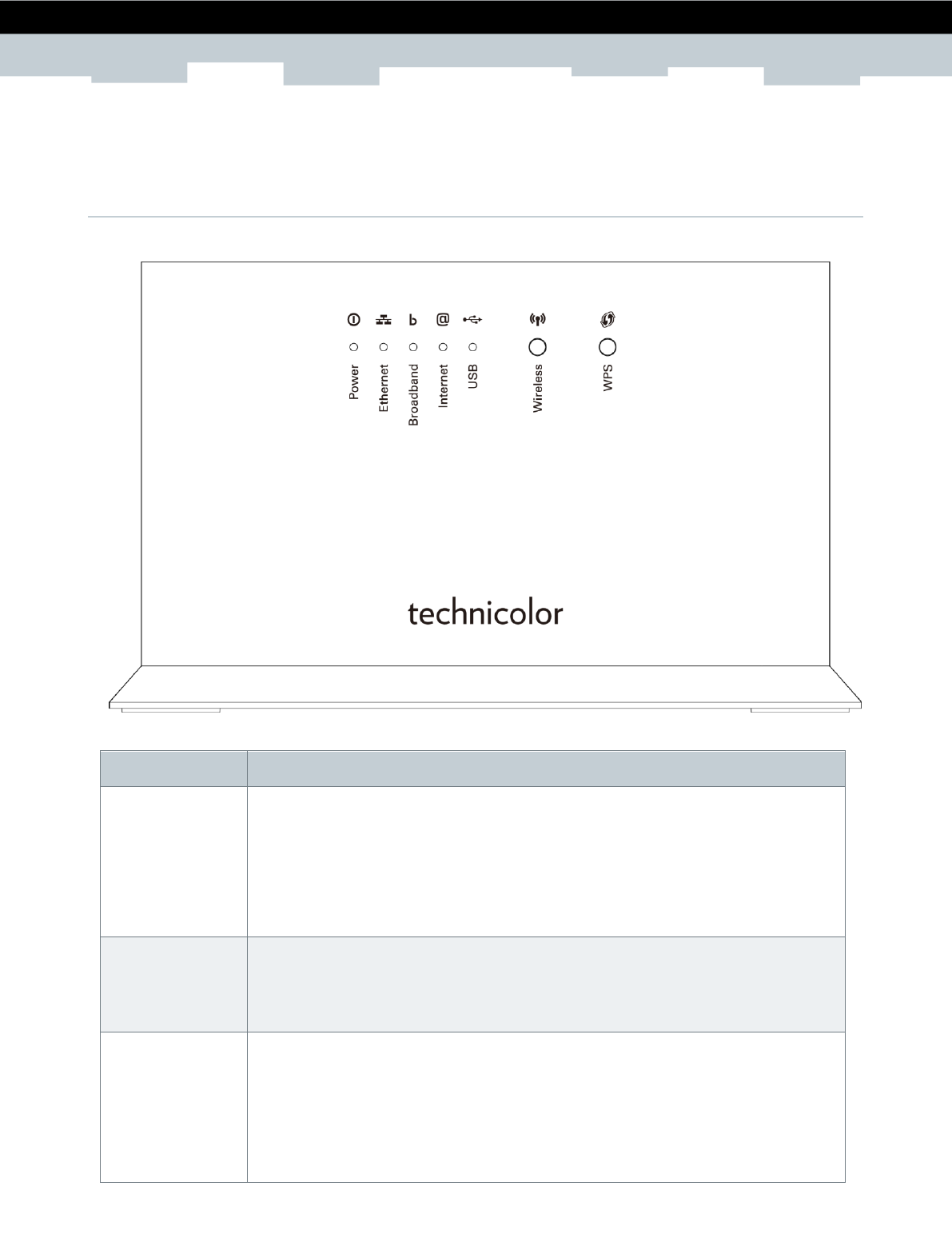
5
SETUP & USER GUIDE DWA0100
DWA0100-20170224-0000v0.0
Copyright © 2017 Technicolor. All rights reserved.
This document contains Technicolor proprietary and confidential information. Passing on and copying of this document, use,
extraction and communication of its contents, is not permitted without written authorization from Technicolor.
1.2 Hardware Overview
1.2.1 Front Panel
Label
Description
Power
Lights up when the device is powered on.
▪ Solid GREEN – Indicates normal operation.
▪ Flashing GREEN – Firmware upgrade in progress.
▪ Solid RED – Indicates malfunction.
▪ Off – The device is powered off.
Ethernet
▪ Solid GREEN – A wired connection is established.
▪ Flashing GREEN – Data transmission is in progress.
▪ Off – No wired connection detected.
Broadband
Lights up to indicate DSL connection status.
▪ Flashing GREEN (slow) – DSL line detection in progress.
▪ Flashing GREEN (fast) – Attempts to synchronize with DSL line.
▪ Solid GREEN – DSL connection is established.
▪ Off – Modem power is off.
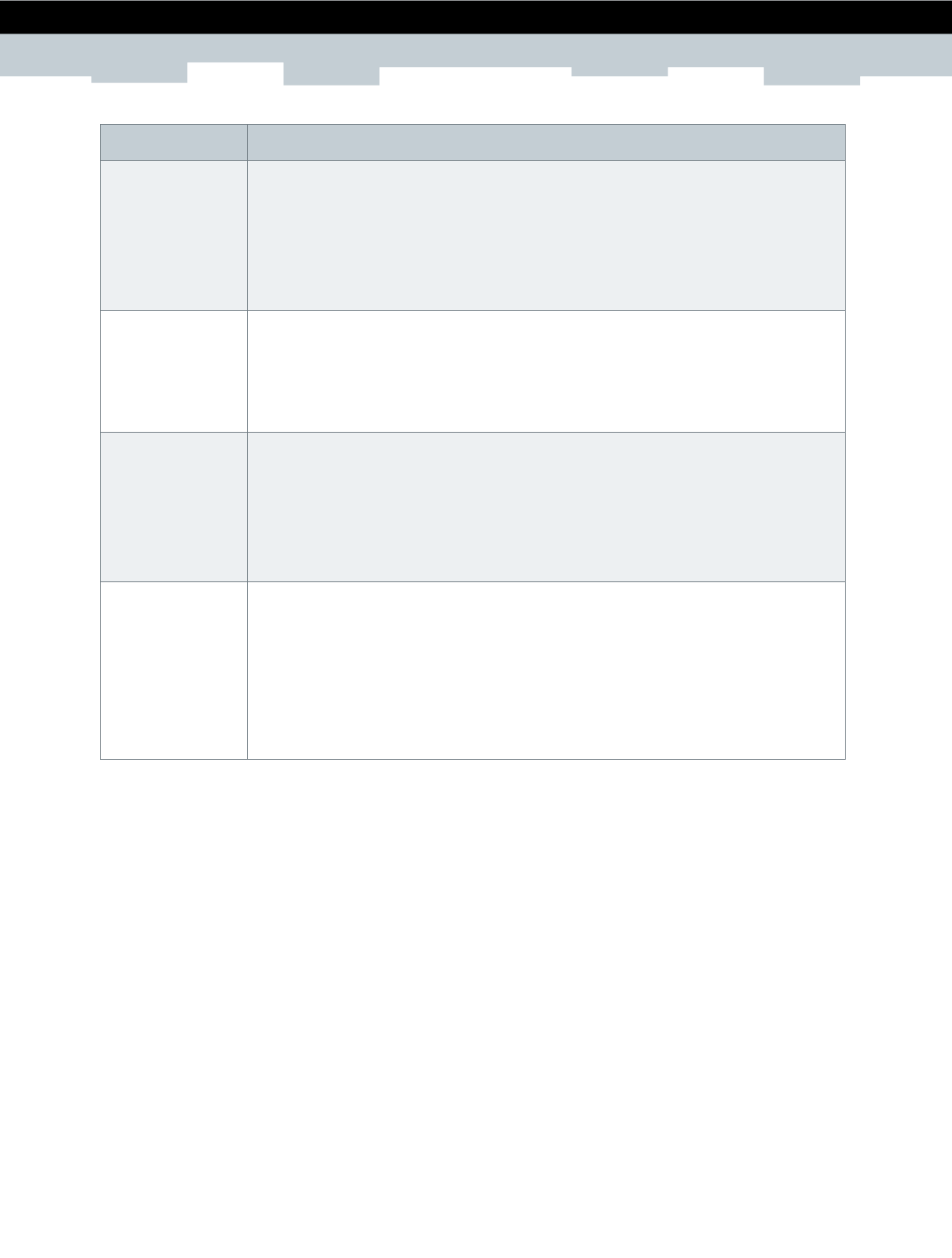
6
SETUP & USER GUIDE DWA0100
DWA0100-20170224-0000v0.0
Copyright © 2017 Technicolor. All rights reserved.
This document contains Technicolor proprietary and confidential information. Passing on and copying of this document, use,
extraction and communication of its contents, is not permitted without written authorization from Technicolor.
Label
Description
Internet
Lights up to indicate Internet connection status.
▪ Solid GREEN – Internet is connected but no activity.
▪ Flashing GREEN – Data transmission is in progress.
▪ Solid RED – Internet connection failed.
▪ Off – No internet connection.
USB
Lights up to indicate USB device connection status.
▪ Solid GREEN – A device is connected to the USB port.
▪ Blinking GREEN - Negotiation or traffic.
▪ Off – No device connected to the USB port.
Wireless
Press button 1 to 7 seconds to enable or disable WLAN.
Lights up to indicate wireless connection.
▪ Solid GREEN – Wireless connection is established.
▪ Flashing GREEN – Negotiation or data transmission is in progress.
▪ Off – Wireless connection is disabled.
WPS
Press button for more than 8 seconds to enable WPS.
Lights up to indicate the Wi-Fi Protected Setup (WPS) connection status.
▪ Solid GREEN – WPS is active.
▪ Blinking Green : WPS negotiation
▪ RED – WPS registration failed.
▪ Off – WPS is off.
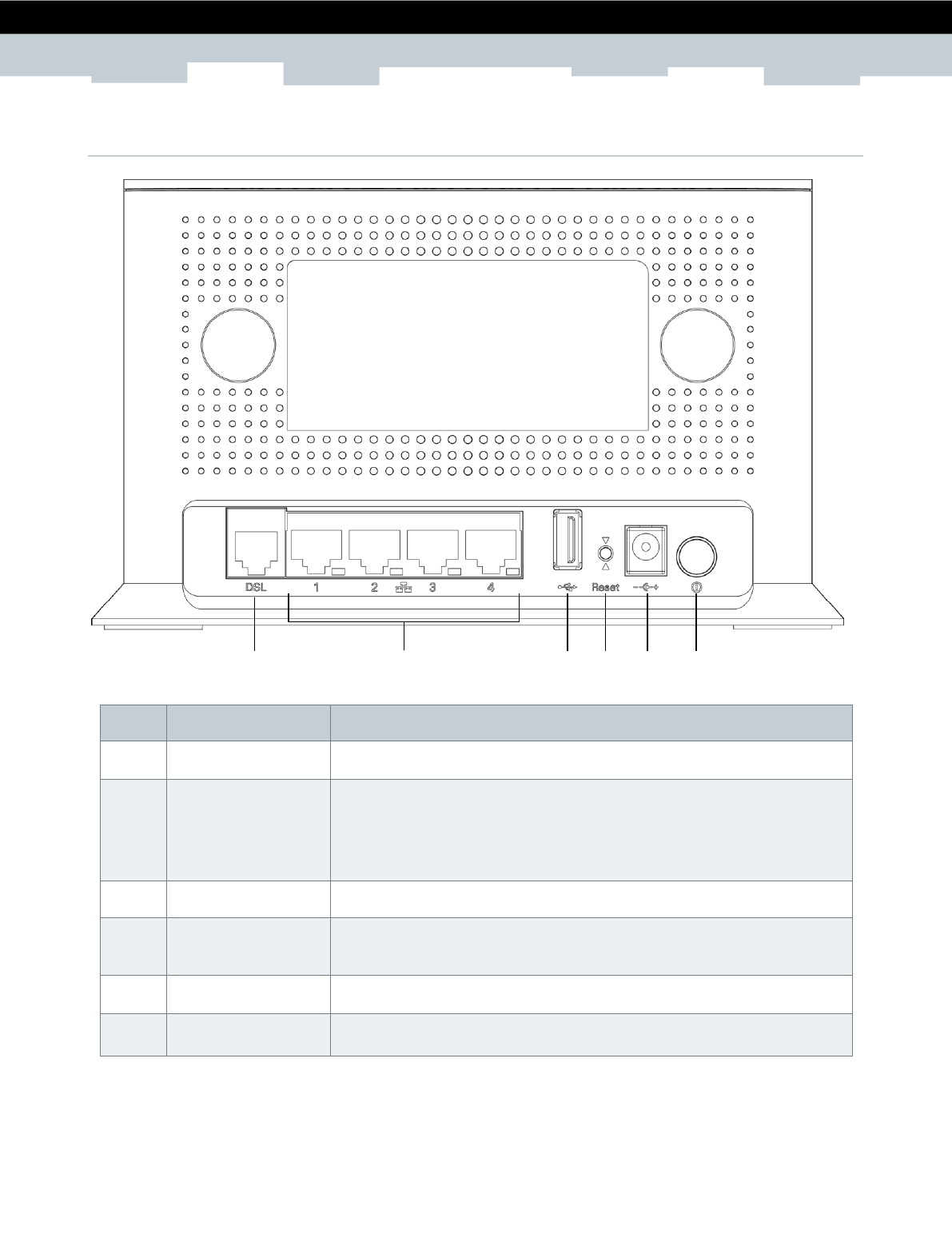
7
SETUP & USER GUIDE DWA0100
DWA0100-20170224-0000v0.0
Copyright © 2017 Technicolor. All rights reserved.
This document contains Technicolor proprietary and confidential information. Passing on and copying of this document, use,
extraction and communication of its contents, is not permitted without written authorization from Technicolor.
1.2.2 Rear Panel
No.
Ports / Buttons
Description
1
DSL port
Connects to the DSL line using the RJ-11 cable.
2
Ethernet ports and
LEDs
1, 2, 3, 4
Connects a computer and other Ethernet network devices to the
Wireless Gateway using RJ-45 cables.
The LAN LED (1, 2, 3, 4) lights up when a device is connected to the
Ethernet port (1, 2, 3, 4).
3
USB port
Connects a USB storage device.
4
Reset button
Press and hold this button for at least 10 seconds to restore your
device to its original factory default setting.
5
DC In jack
Connects to the power adapter.
6
Power button
Press to turn your device on or off.
1 2 3 4 5 6
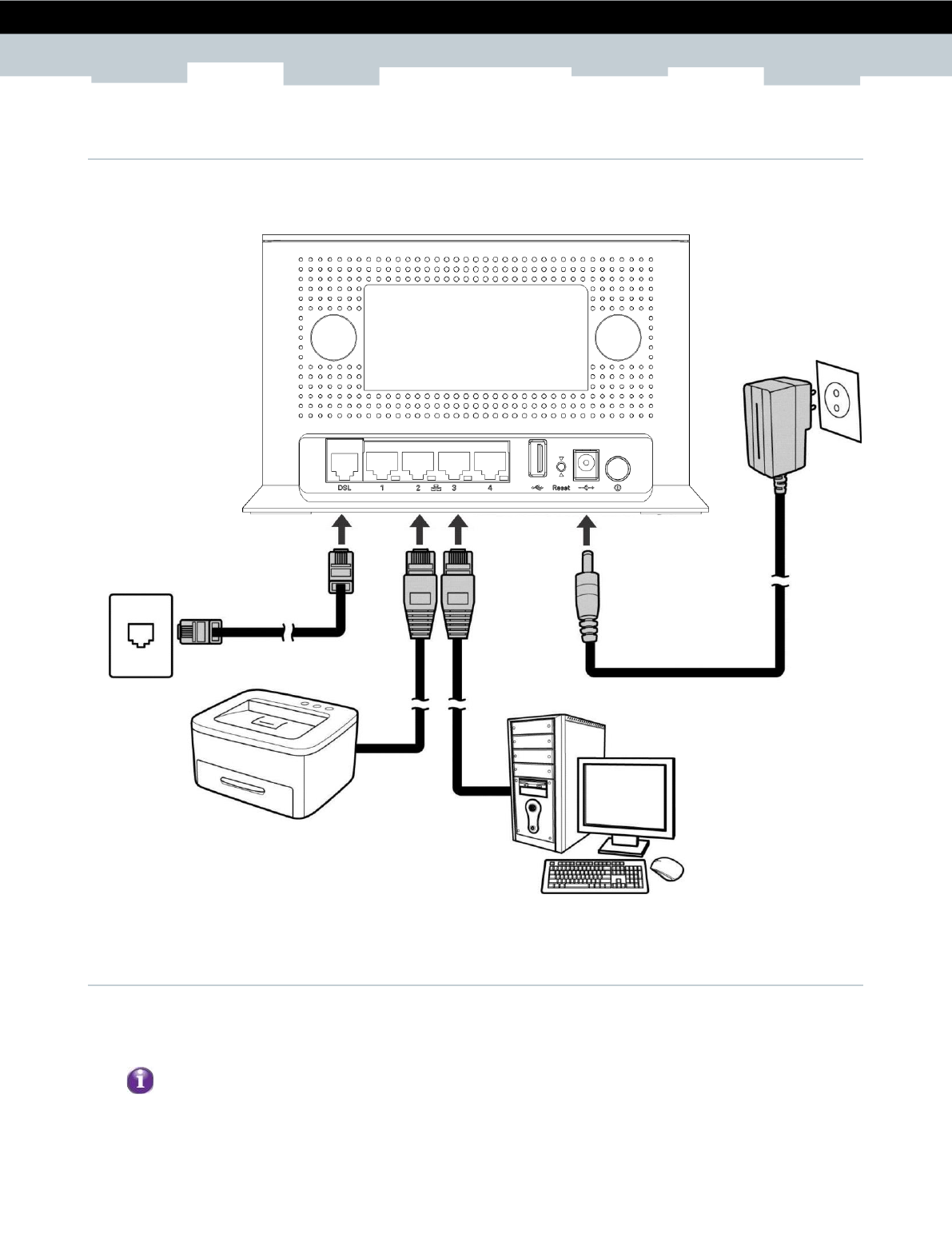
8
SETUP & USER GUIDE DWA0100
DWA0100-20170224-0000v0.0
Copyright © 2017 Technicolor. All rights reserved.
This document contains Technicolor proprietary and confidential information. Passing on and copying of this document, use,
extraction and communication of its contents, is not permitted without written authorization from Technicolor.
2 Installation
Make sure that all devices are powered off before starting installation.
Installation Diagram
2.1 Connect the Power
1 Connect the power adapter to the DC In jack of your Wireless Gateway.
2 Plug the power adapter to a wall outlet or a power strip.
▪ Use only the supplied power adapter. Using other power adapters may cause damage to the
device.
▪ Connect all devices to your Wireless Gateway before connecting the power adapter to a wall
outlet.
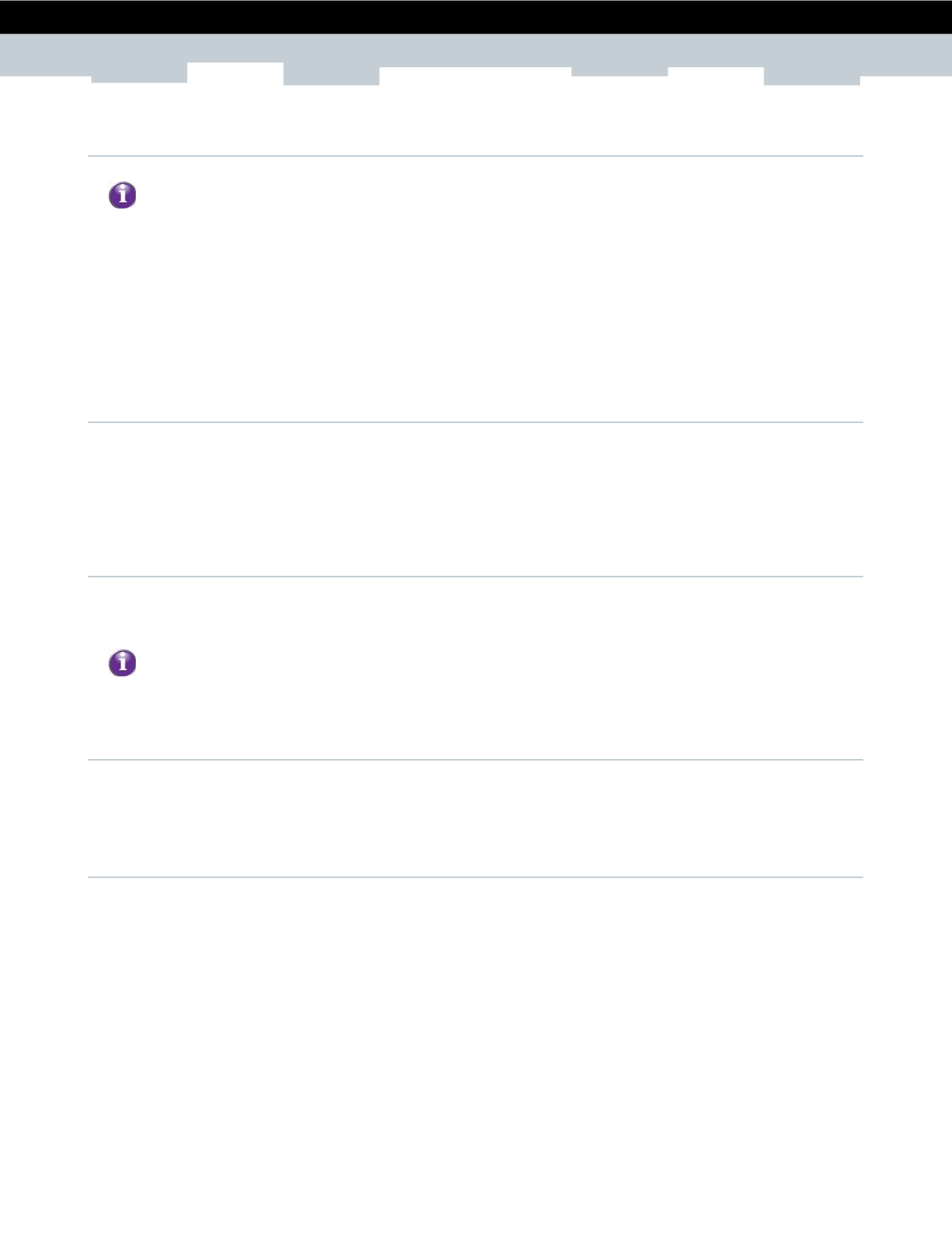
9
SETUP & USER GUIDE DWA0100
DWA0100-20170224-0000v0.0
Copyright © 2017 Technicolor. All rights reserved.
This document contains Technicolor proprietary and confidential information. Passing on and copying of this document, use,
extraction and communication of its contents, is not permitted without written authorization from Technicolor.
2.2 Connect Wired Devices
When setting up the Wireless Gateway for the first time, connect the host computer via Ethernet
connection.
1 Connect one end of the RJ-45 cable to one of the Ethernet (1, 2, 3, 4) ports of your Wireless Gateway.
2 Connect the other end of the RJ-45 cable to the Ethernet port of the computer.
3 Repeat the above steps to connect other computers to the Wireless Gateway via Ethernet connection.
4 To connect more than four computers, use a hub or switch. Connect one end of an RJ-45 cable to the
hub or switch and the other end to the computer.
2.3 Connect Wireless Devices
Before connecting wireless devices to the Wireless Gateway, configure the wireless security settings of
your Wireless Gateway (see “To Set up Security Settings on page 46”). Take note of the SSID and the
password you have set, you need the SSID and the password to connect devices to your Wireless
Gateway.
2.3.1 WLAN
From the wireless device end, search for the Wireless Gateway network name (SSID), and enter the
passphrase to connect.
The SSID and passphrase are the ones you have set in the Wireless Security Settings (see “To Set up
Security Settings on page 46”).
2.3.2 Wi-Fi Protected Setup (WPS)
Press and hold the WPS button of the Wireless Gateway for at least 8 seconds and press the WPS
button on the WPS-enabled device to start pairing.
2.4 Connect the Broadband (DSL)
1 Connect one end of the RJ-11 cable to the DSL port of your Wireless Gateway.
2 Connect the other end of the RJ-11 cable to a wall jack with DSL service.
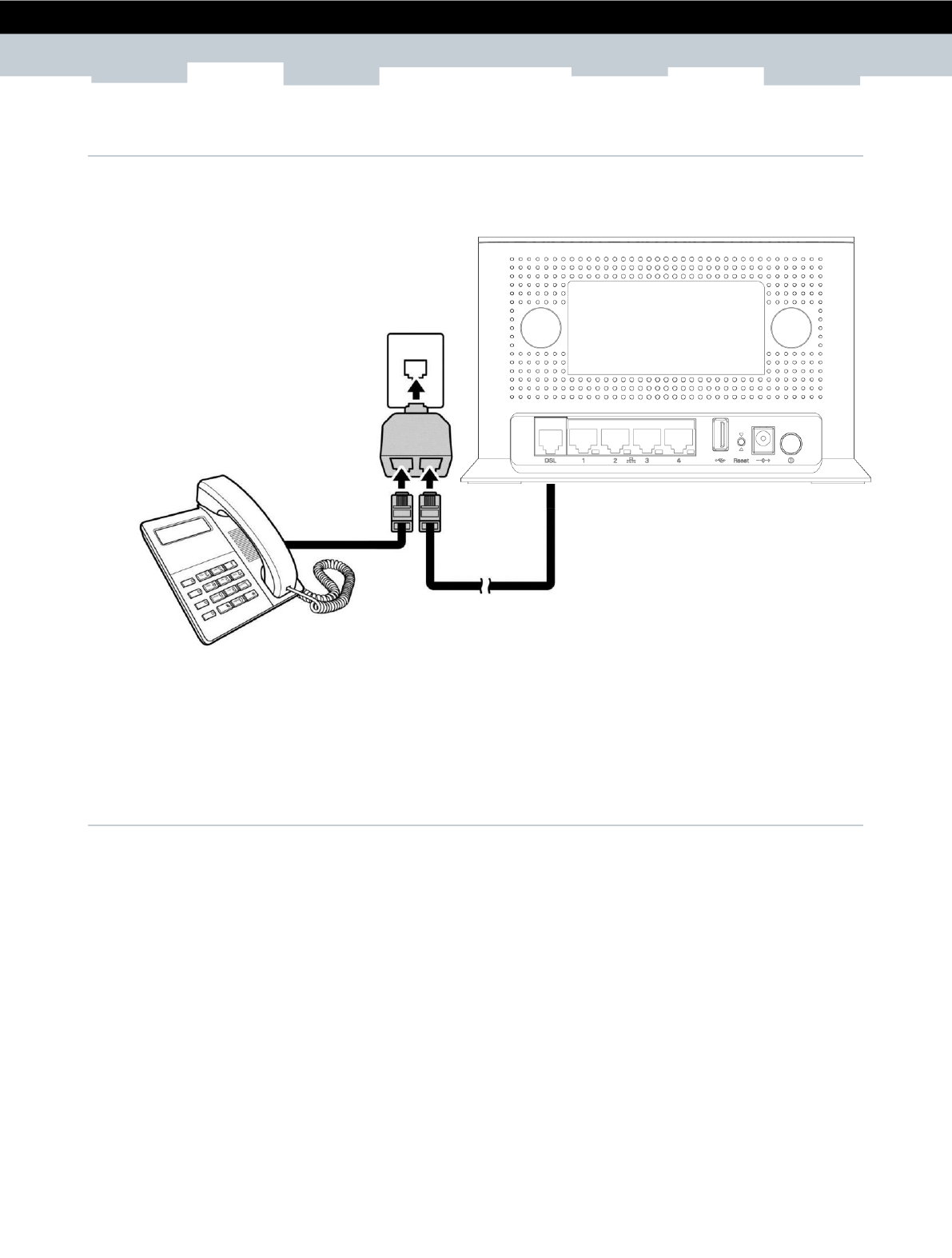
10
SETUP & USER GUIDE DWA0100
DWA0100-20170224-0000v0.0
Copyright © 2017 Technicolor. All rights reserved.
This document contains Technicolor proprietary and confidential information. Passing on and copying of this document, use,
extraction and communication of its contents, is not permitted without written authorization from Technicolor.
2.4.1 Use a Splitter
You need a splitter when connecting the Wireless Gateway to the wall jack that also connects to a
telephone.
1 Plug the splitter to the wall jack with DSL service.
2 Connect one end of the RJ-11 cable to the DSL port of your Wireless Gateway.
3 Connect the other end of the RJ-11 cable to the splitter.
4 Connect the telephone to the splitter using another RJ-11 cable.
2.5 Check the Installation
To ensure that all devices are properly connected, check the LED indicators on the front of your Wireless
Gateway. For basic installation, the following LEDs must be lit:
▪ Power LED
▪ Ethernet LED
▪ DSL LED
The lighted LED indicators vary depending on the type of connection that you make. See “Front Panel” on
page 5 for more information about the LED indicators.
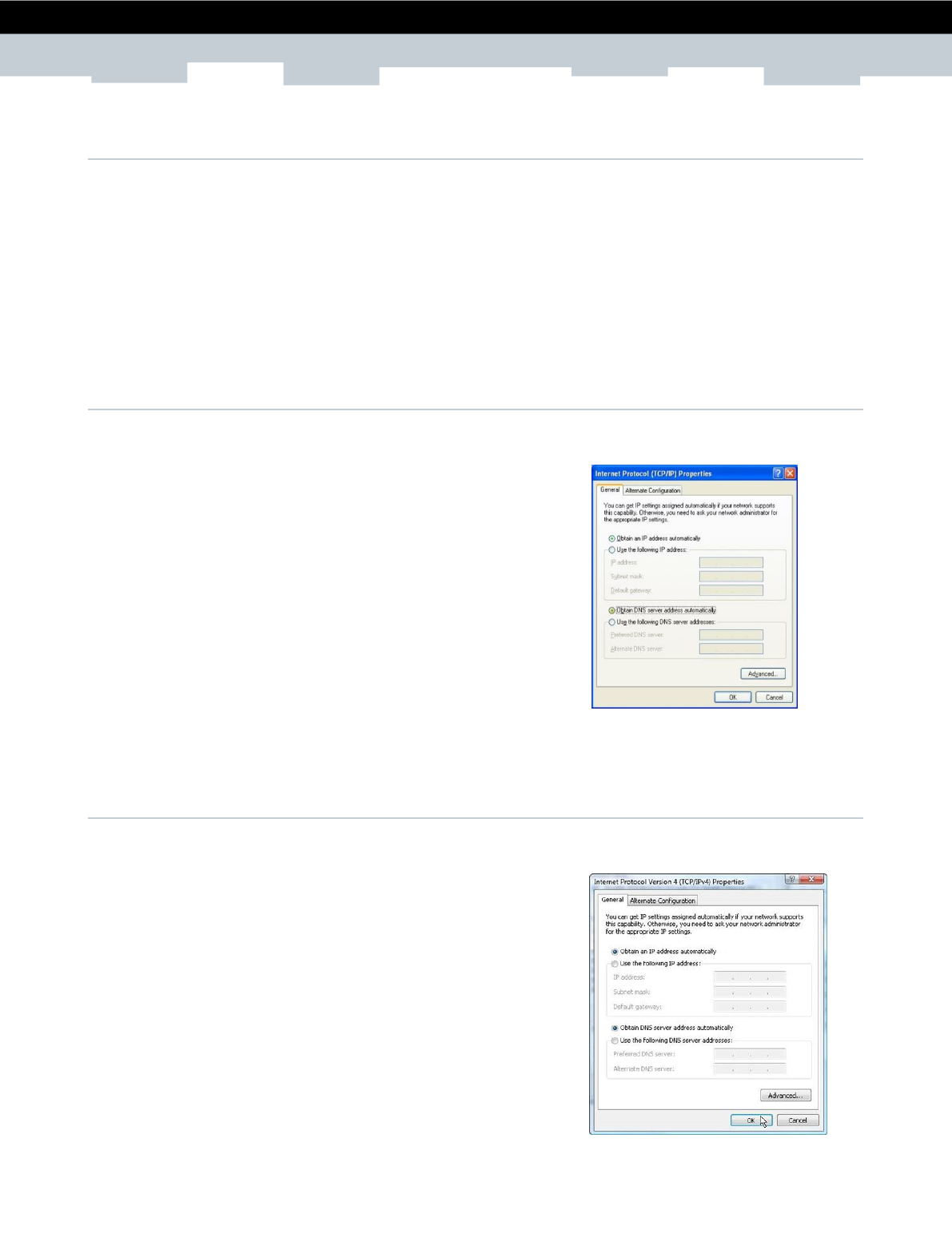
11
SETUP & USER GUIDE DWA0100
DWA0100-20170224-0000v0.0
Copyright © 2017 Technicolor. All rights reserved.
This document contains Technicolor proprietary and confidential information. Passing on and copying of this document, use,
extraction and communication of its contents, is not permitted without written authorization from Technicolor.
3 Configure the Computer
This chapter will guide you on how to configure your computer according to the operating system you are
using.
▪ Windows XP, see below.
▪ Windows Vista, see page 11.
▪ Windows 7, see page 12.
▪ Windows 8, see page 12.
3.1 Windows XP
If you are using Windows XP, follow the instructions below to configure your computer.
1 Click Start > Control Panel > Network Connections.
2 Right-click Local Area Connection, then click Properties.
3 On the network components list, make sure that Internet
Protocol (TCP/IP) is checked. If not, check it to enable the
Properties button.
4 Select Internet Protocol (TCP/IP), and then click
Properties.
5 On the General tab, select Obtain an IP Address
automatically and Obtain DNS server address
automatically.
6 Click OK.
General Page
3.2 Windows Vista
If you are using Windows Vista, follow the instructions below to configure your computer.
1 Click Start > Control Panel > Network and Internet
Connections > Network Connections.
2 Right-click Local Area Connection, then click Properties.
3 On the General tab, make sure that Internet Protocol
(TCP/IP) is checked. If not, check it to enable the
Properties button.
4 Select Internet Protocol (TCP/IP), and then click
Properties.
5 Select Obtain an IP Address automatically and Obtain
DNS server address automatically.
6 Click OK.
General Page
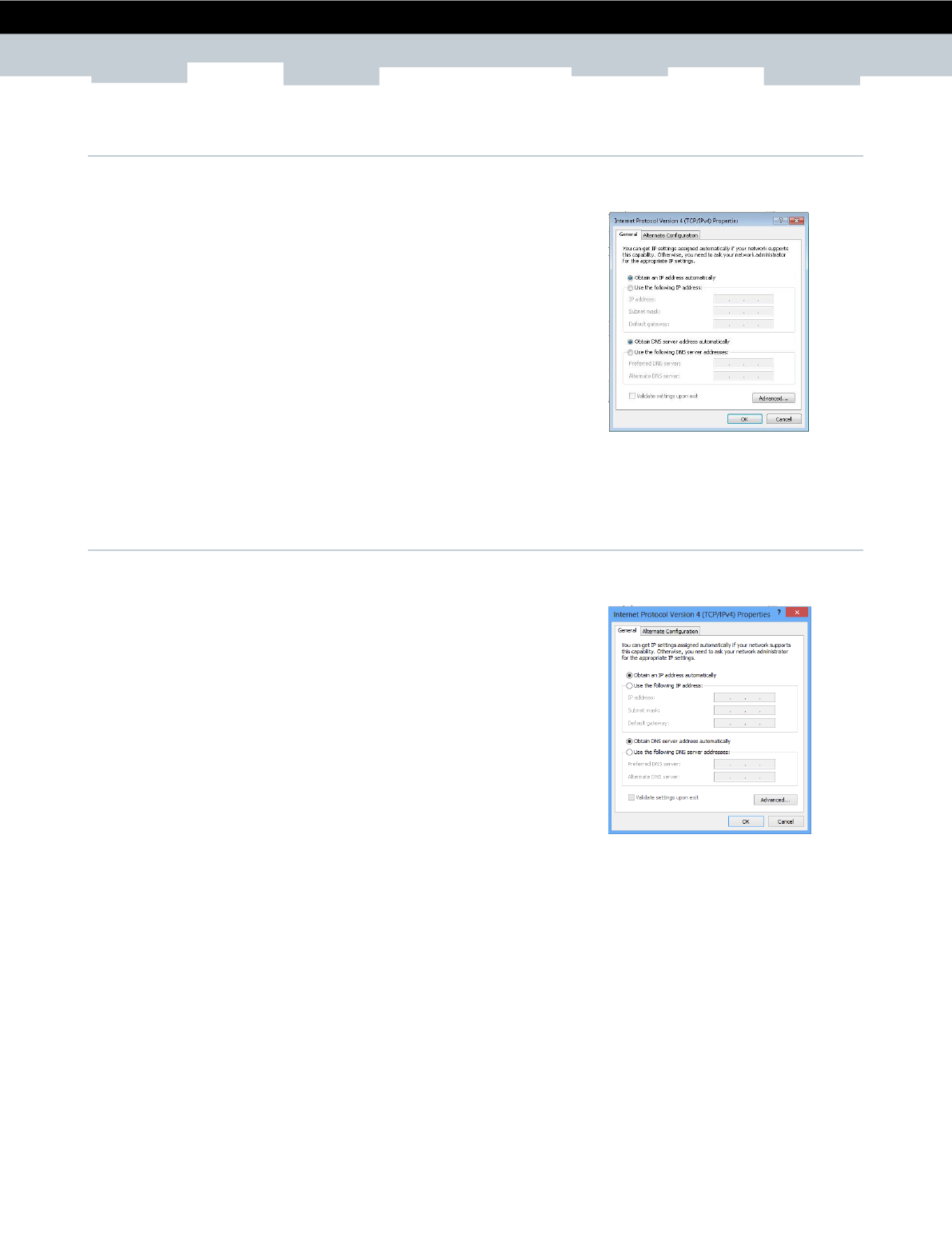
12
SETUP & USER GUIDE DWA0100
DWA0100-20170224-0000v0.0
Copyright © 2017 Technicolor. All rights reserved.
This document contains Technicolor proprietary and confidential information. Passing on and copying of this document, use,
extraction and communication of its contents, is not permitted without written authorization from Technicolor.
3.3 Windows 7
If you are using Windows 7, follow the instructions below to configure your computer.
1 Click Start > Control Panel > Network & Sharing Center.
2 Click Local Area Connection.
3 Click Properties.
4 On the network components list, make sure that Internet
Protocol (TCP/IP) is checked. If not, check it to enable the
Properties button.
5 Select Internet Protocol (TCP/IP), and then click
Properties.
6 On the General tab, select Obtain an IP Address
automatically and Obtain DNS server address automatically.
7 Click OK.
General Page
3.4 Windows 8
If you are using Windows 8, follow the instructions below to configure your computer.
1 On a PC, move the cursor to the bottom or top right corner
of the screen and click Settings. On a tablet, swipe left from
the right side of the screen and tap Settings.
2 Click Control Panel.
3 Change the display style from Category to Large icons or
Small icons.
4 Click Network and Sharing Center.
5 Click Change adapter settings.
6 Right click the Ethernet connection click Properties.
7 On the network components list, make sure that Internet
Protocol Version 4 (TCP/IPv4) is checked. If not, check it
to enable the Properties button.
8 Select Internet Protocol Version 4 (TCP/IPv4), and then
click Properties.
9 On the General tab, select Obtain an IP address
automatically and Obtain DNS server address
automatically.
10 Click OK.
General Page
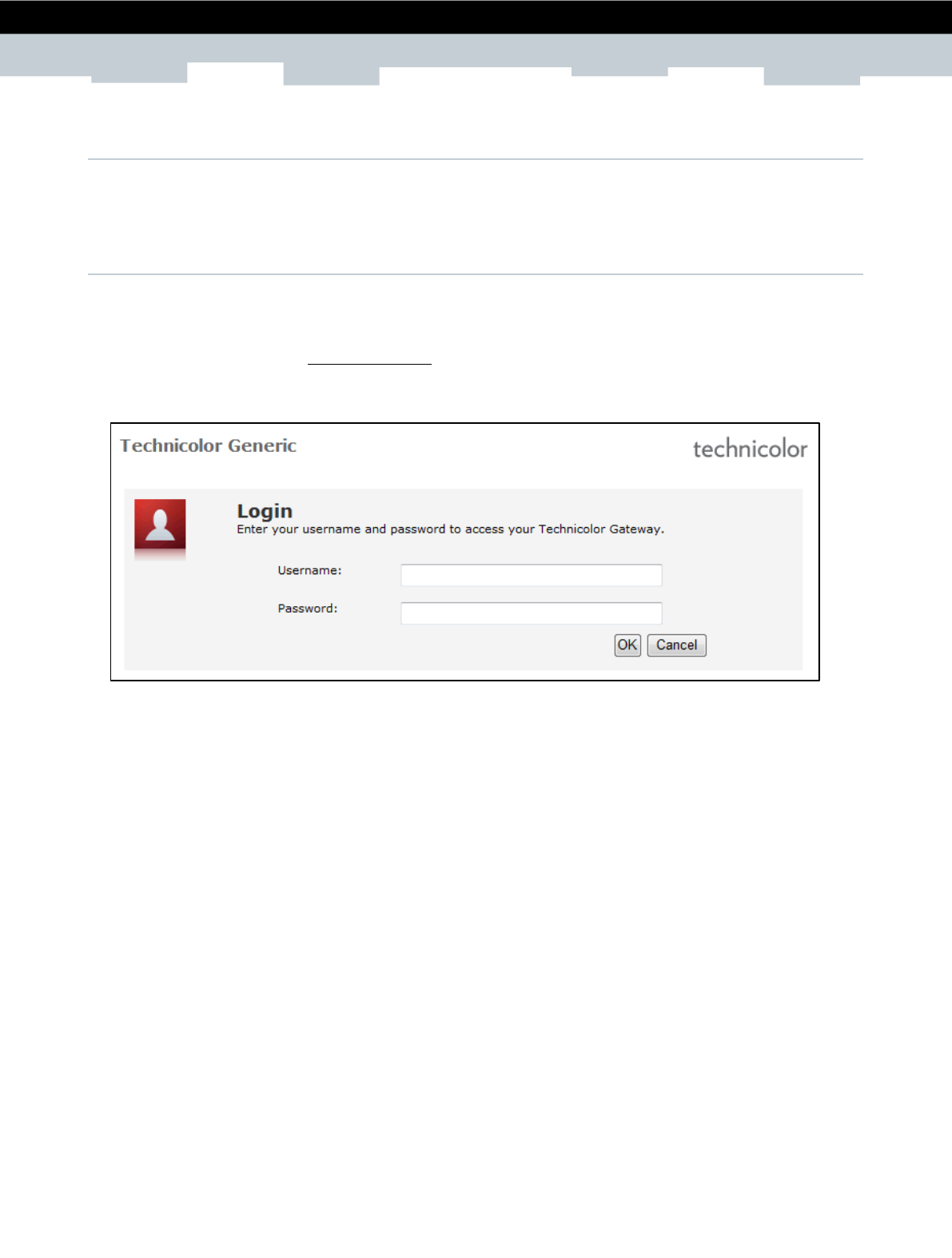
13
SETUP & USER GUIDE DWA0100
DWA0100-20170224-0000v0.0
Copyright © 2017 Technicolor. All rights reserved.
This document contains Technicolor proprietary and confidential information. Passing on and copying of this document, use,
extraction and communication of its contents, is not permitted without written authorization from Technicolor.
4 Access the Wireless Gateway
Use the Web Configurations utility to configure your Wireless Gateway.
4.1 Login
For more advanced configuration, access the Technicolor web configuration utility.
1 Launch the web browser.
2 On the address bar, type http://192.168.1.1, and then press Enter.
3 A login screen displays if you have already set the administrator password. Enter the user name
(Administrator) and the password.
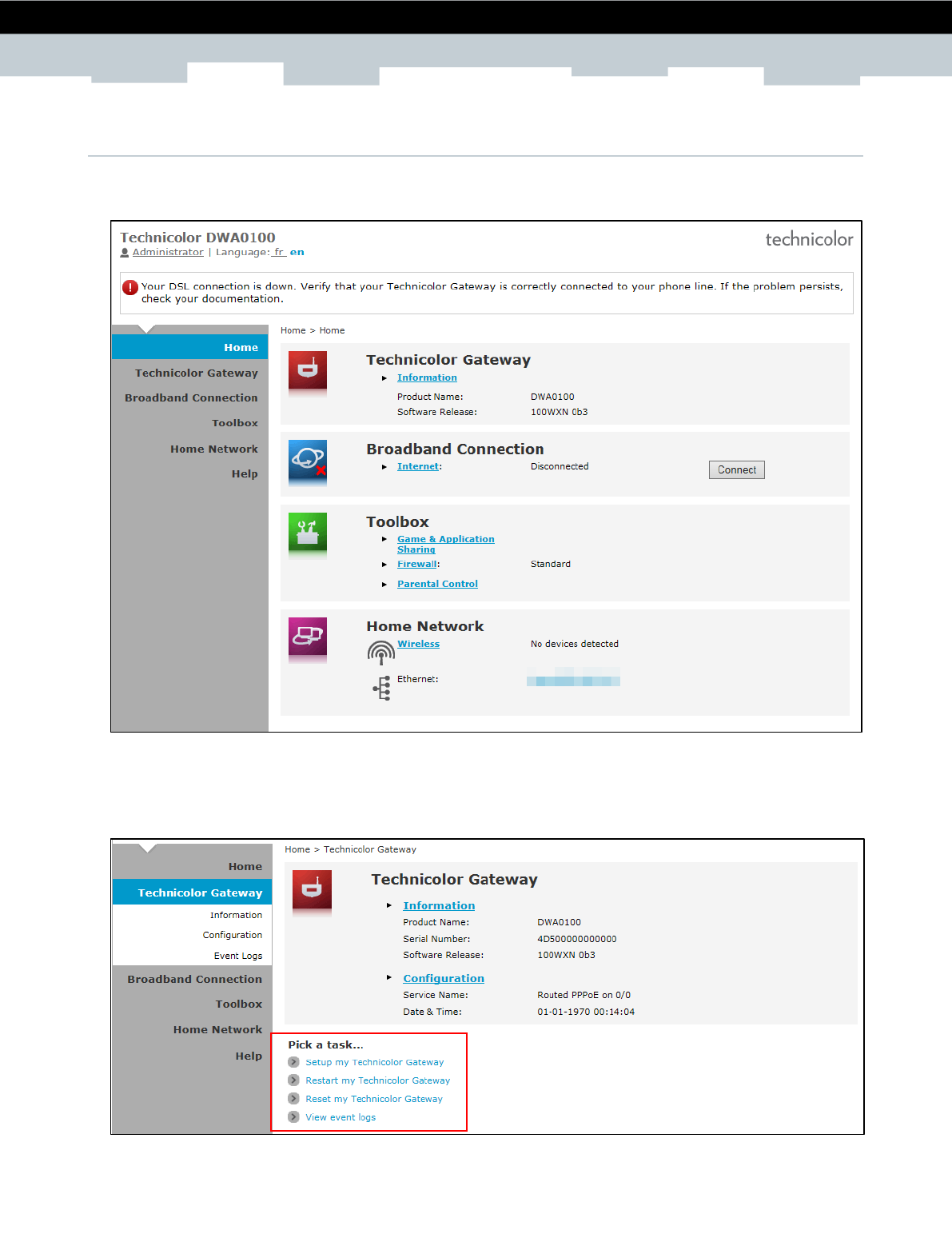
14
SETUP & USER GUIDE DWA0100
DWA0100-20170224-0000v0.0
Copyright © 2017 Technicolor. All rights reserved.
This document contains Technicolor proprietary and confidential information. Passing on and copying of this document, use,
extraction and communication of its contents, is not permitted without written authorization from Technicolor.
4.2 The Interface
Once connected, the Home screen appears. The Home screen provides quick access to the most
common functions of your Wireless Gateway. Click an option to access the function.
To quickly change passwords or switch users, click the user name on the top-left corner of the screen (in
the above example, “Administrator”).
In some screens, shortcut items are available on the bottom of the screen. Click a shortcut to access the
page. See example below.
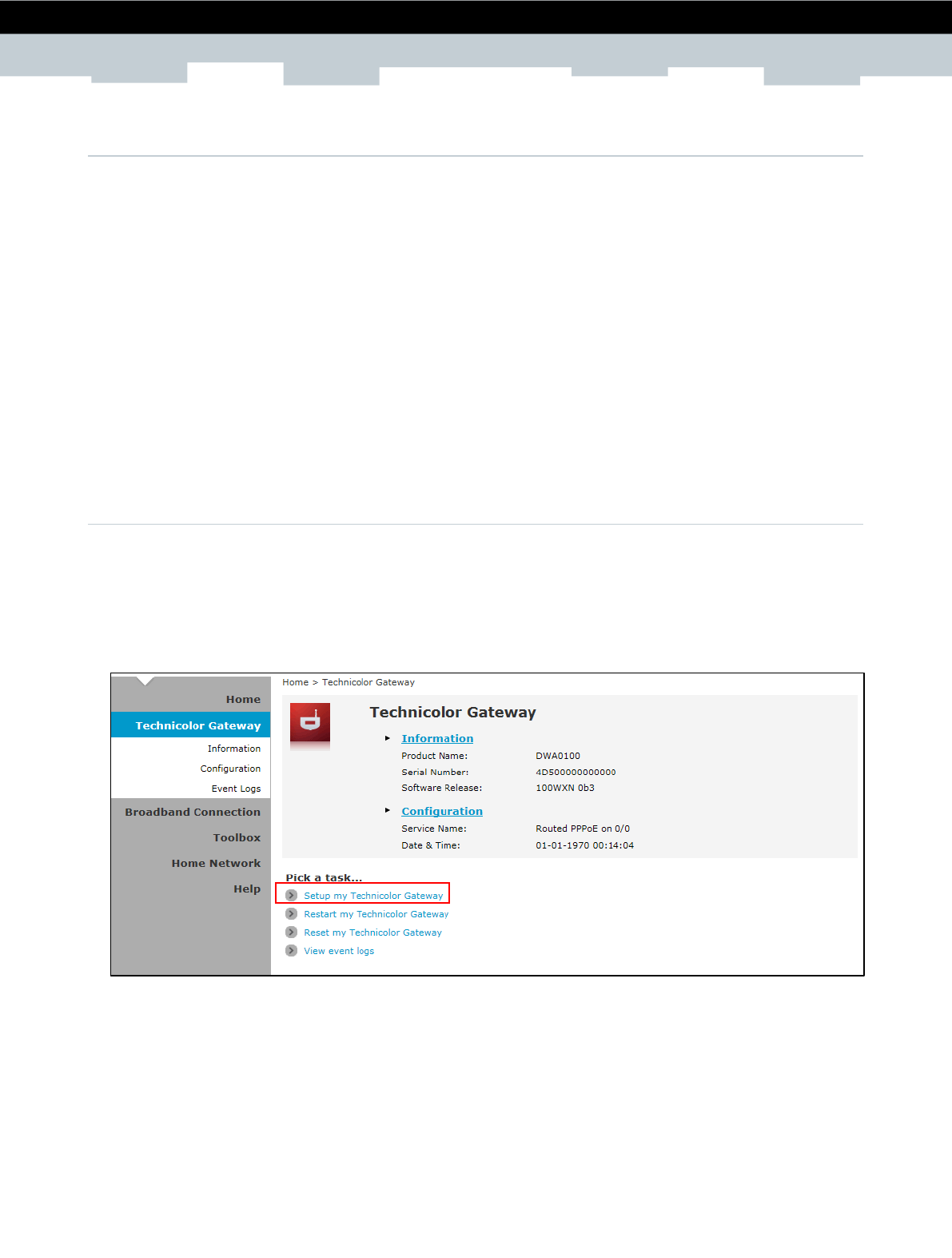
15
SETUP & USER GUIDE DWA0100
DWA0100-20170224-0000v0.0
Copyright © 2017 Technicolor. All rights reserved.
This document contains Technicolor proprietary and confidential information. Passing on and copying of this document, use,
extraction and communication of its contents, is not permitted without written authorization from Technicolor.
4.3 Using the Menu
For more advanced users, use the main menu, located on the left panel of the screen, to configure your
Wireless Gateway.
Click a menu item, then a submenu to display the page.
The following menu items are available:
▪ Home — Displays the Home screen.
▪ Technicolor Gateway — Allows you to configure your Wireless Gateway, such as system date and
time, and to view event logs.
▪ Broadband Connection — Allows you to view the DSL connection status of your Wireless Gateway
and configure a dial-up connection and establish or terminate the Internet connection.
▪ Toolbox — Allows you to configure more advanced functions, such as remote assistance, firewall,
filter, parental control services, and others.
▪ Home Network — Allows you to view the devices connected to the network of your Wireless Gateway.
4.4 Configuration Wizard
For first time users, you may want to use the wizard to set up your Wireless Gateway. Perform the
following:
1 On the main menu, click Technicolor Gateway.
2 Click the Setup my Technicolor Gateway shortcut at the bottom of the screen.
1 The Technicolor Wizard screen appears. Click Next to continue.

16
SETUP & USER GUIDE DWA0100
DWA0100-20170224-0000v0.0
Copyright © 2017 Technicolor. All rights reserved.
This document contains Technicolor proprietary and confidential information. Passing on and copying of this document, use,
extraction and communication of its contents, is not permitted without written authorization from Technicolor.
The required information on the succeeding screens must be obtained from your Internet Service
Provider (ISP).
2 Select the DSL account service: Bridge or Routed PPP. Then click Next.
3 If the ISP requires you to use a specific VLAN ID and priority for the VDSL connection, select Enable
and enter them. Click Next.

17
SETUP & USER GUIDE DWA0100
DWA0100-20170224-0000v0.0
Copyright © 2017 Technicolor. All rights reserved.
This document contains Technicolor proprietary and confidential information. Passing on and copying of this document, use,
extraction and communication of its contents, is not permitted without written authorization from Technicolor.
If you selected Routed PPP, skip to step 5.
4 If you have a DHCP server on your LAN, clear the DHCP Server check box. Otherwise, keep it
selected. Click Next to continue.
Skip to step 6.
5 The Internet Account Settings screen appears. Obtain the necessary information from your ISP.
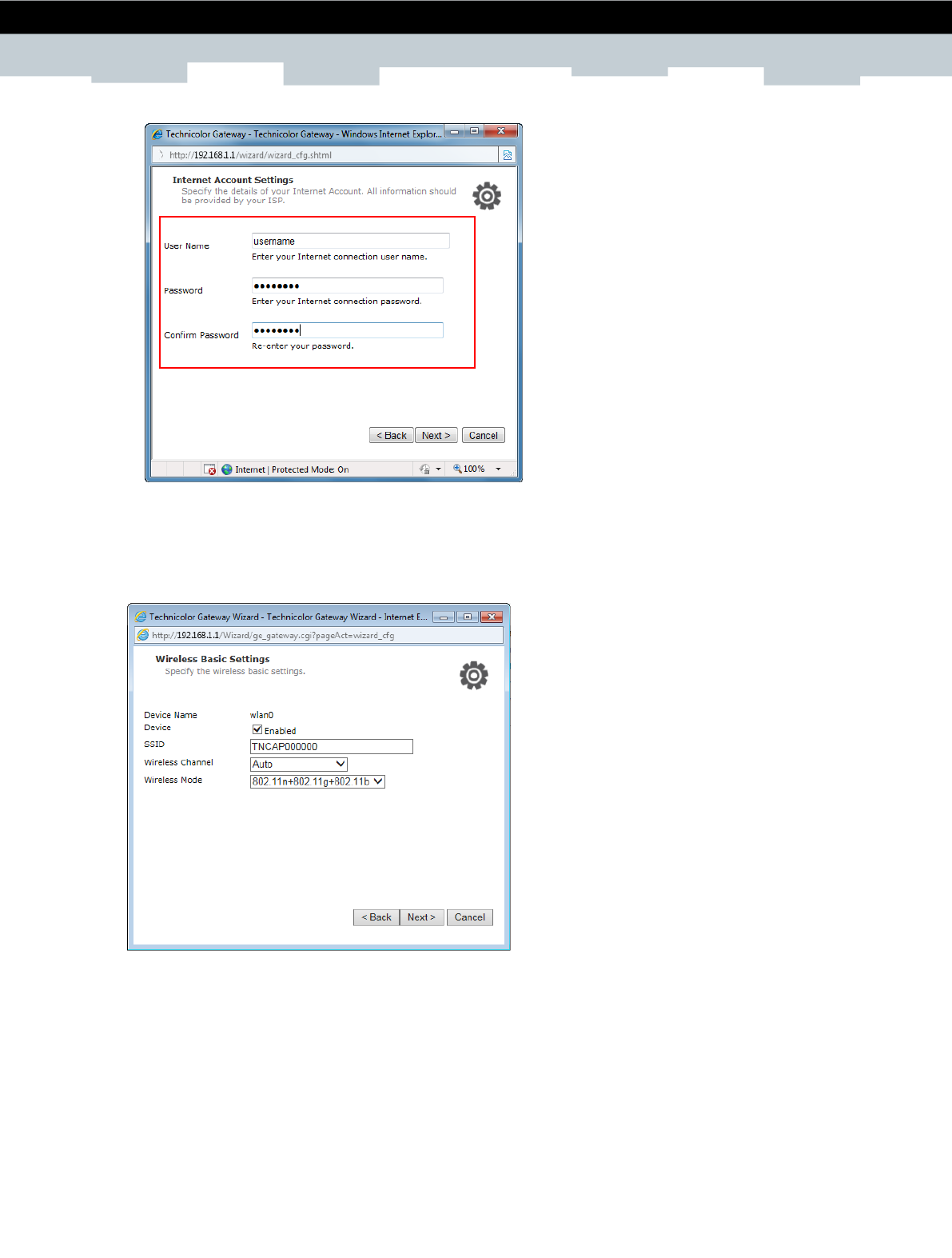
18
SETUP & USER GUIDE DWA0100
DWA0100-20170224-0000v0.0
Copyright © 2017 Technicolor. All rights reserved.
This document contains Technicolor proprietary and confidential information. Passing on and copying of this document, use,
extraction and communication of its contents, is not permitted without written authorization from Technicolor.
a Type your Internet account user name in User Name.
b Type your Internet account user name in User Name.
c Type your account password in Password and Confirm Password and click Next.
6 Enter or take note of the basic wireless settings.
a Check Enabled to enable the wireless access point.
b Enter the wireless network name (SSID) to show to wireless devices to connect to your network.
c Select a Wireless Channel manually or automatic channel selection.
d Wireless Mode — Select the types of wireless devices to allow to connect and then click Next.
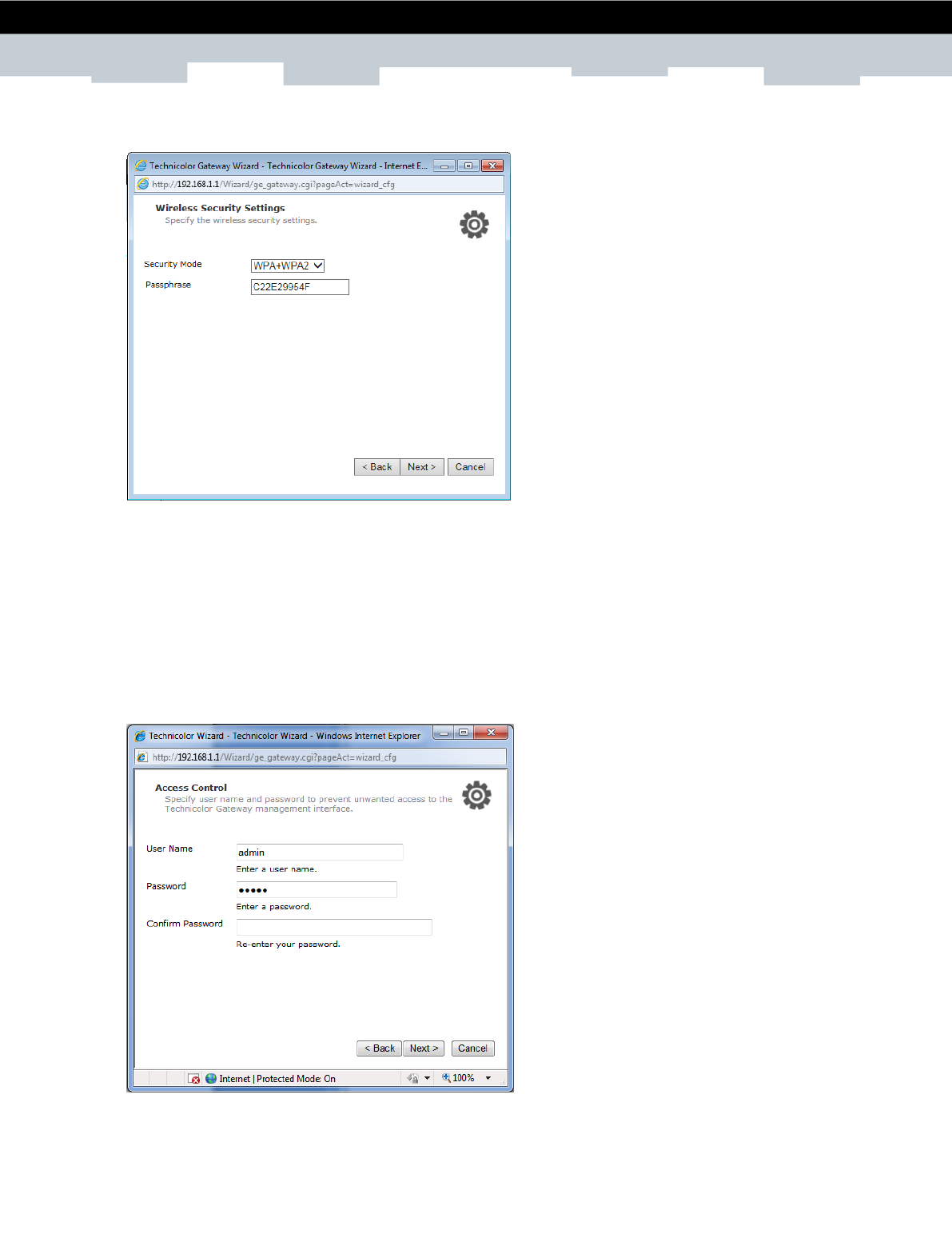
19
SETUP & USER GUIDE DWA0100
DWA0100-20170224-0000v0.0
Copyright © 2017 Technicolor. All rights reserved.
This document contains Technicolor proprietary and confidential information. Passing on and copying of this document, use,
extraction and communication of its contents, is not permitted without written authorization from Technicolor.
7 Enter or take note of the wireless security settings.
a Select the type of wireless security to use.
Select WPA2 for the strongest security. Older devices may not be able to connect.
Select WPA+WPA2 to let newer and slightly older devices connect.
Select WPA if you only have devices that support WPA.
Select WEP to use the weakest security if you have to connect old devices that do not support WPA2
or WPA. See “To Set up Security Settings on page 46” for details on the WEP encryption settings.
b Type the Phassphrase (password) users enter to connect to the wireless network and click Next.
8 Configure your user name and password and then click Next.
9 Review your Wireless Gateway settings, and then click Start to apply the settings.
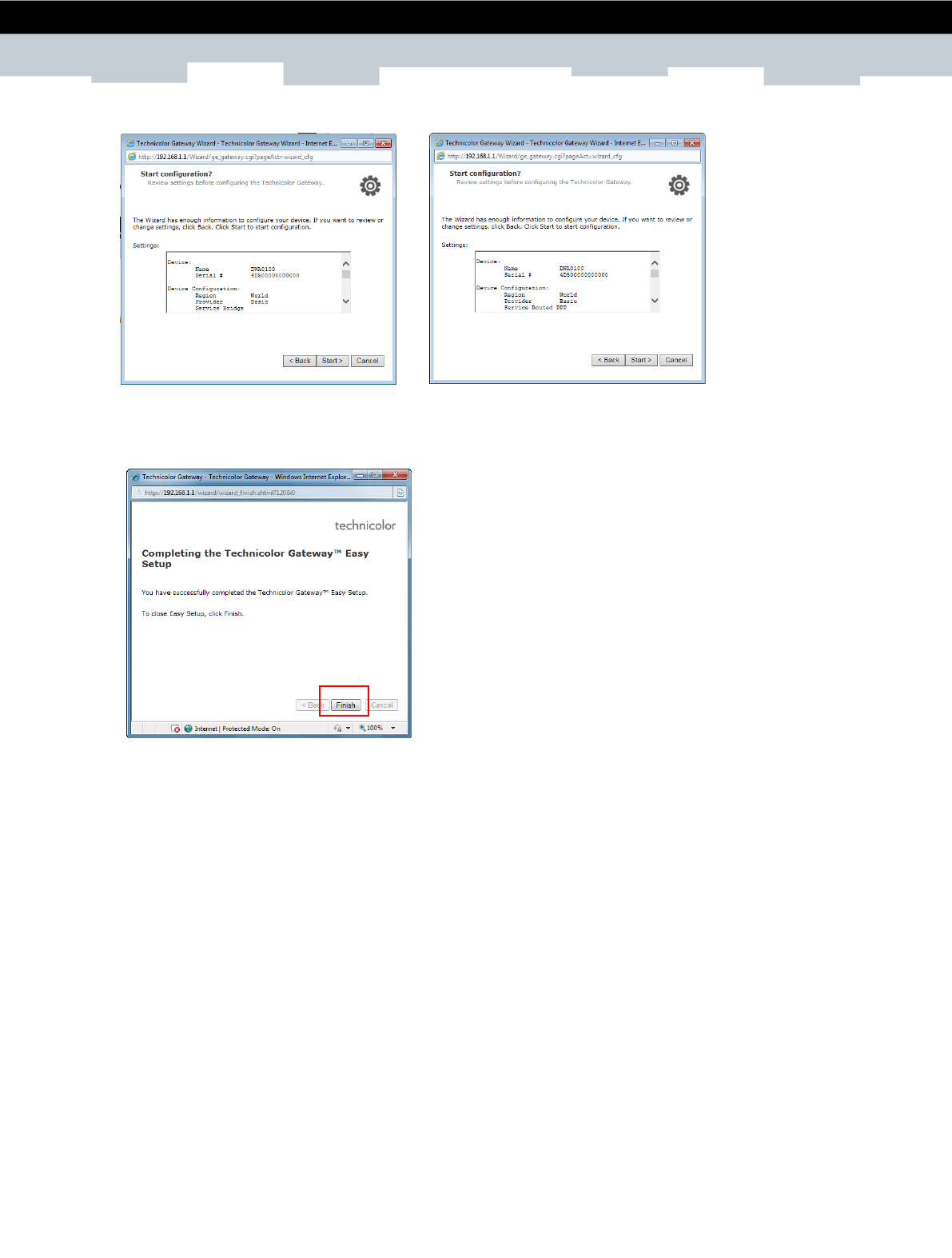
20
SETUP & USER GUIDE DWA0100
DWA0100-20170224-0000v0.0
Copyright © 2017 Technicolor. All rights reserved.
This document contains Technicolor proprietary and confidential information. Passing on and copying of this document, use,
extraction and communication of its contents, is not permitted without written authorization from Technicolor.
Bridge Connection
Routed PPP Connection
10 The configuration may take a while to finish. When complete, click Finish.
11 Close the web browser.
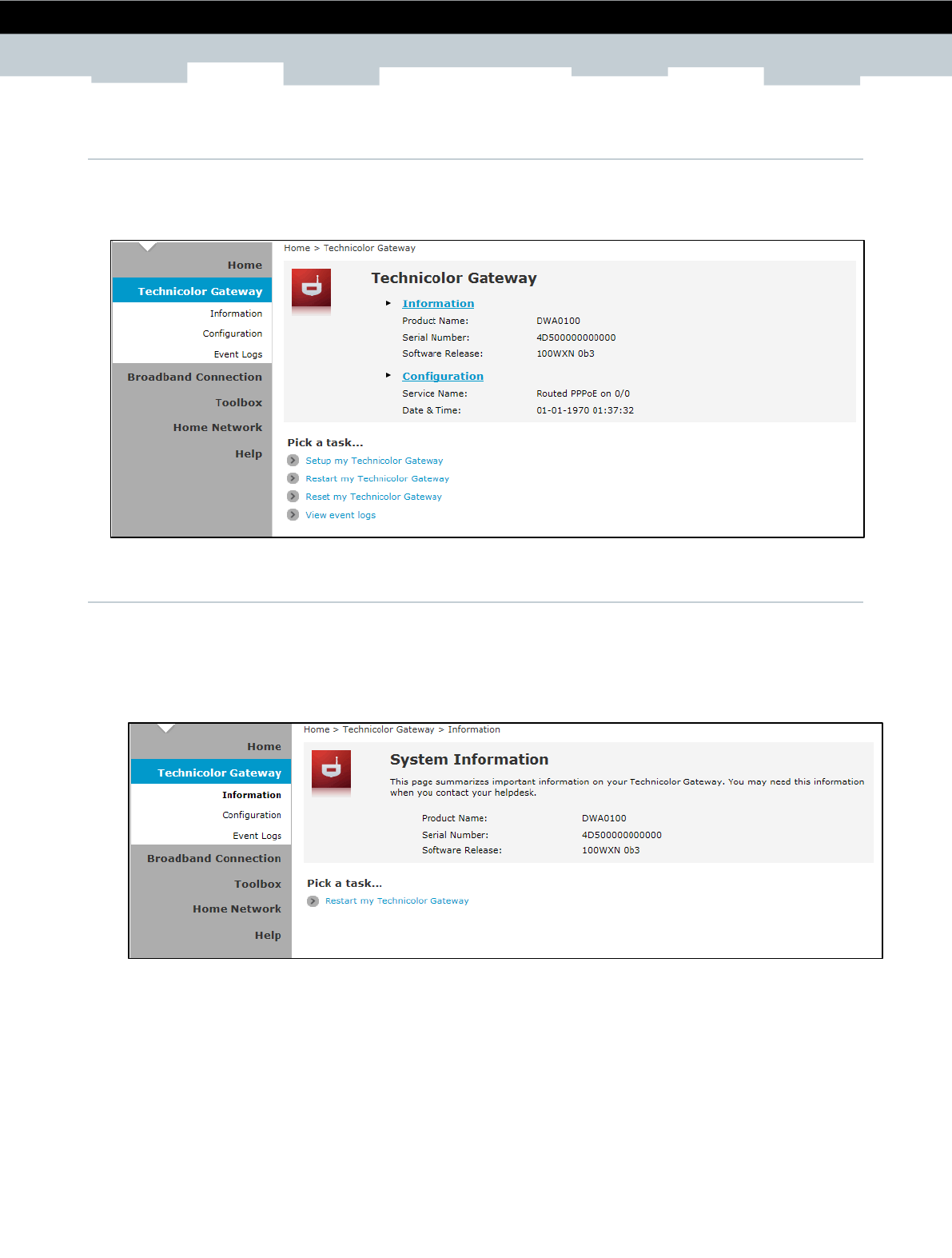
21
SETUP & USER GUIDE DWA0100
DWA0100-20170224-0000v0.0
Copyright © 2017 Technicolor. All rights reserved.
This document contains Technicolor proprietary and confidential information. Passing on and copying of this document, use,
extraction and communication of its contents, is not permitted without written authorization from Technicolor.
5 Technicolor Gateway
The Technicolor Gateway menu allows you to view the system information and configure the Wireless
Gateway. This menu is divided into three sections: Information, Configuration, and Event Logs.
5.1 System Information
The System Information page displays the product name, device serial number, and software release
information. To view the System Information page, do one of the following:
1 On the main menu, click Technicolor Gateway > Information.
2 From the Home screen, click Information.
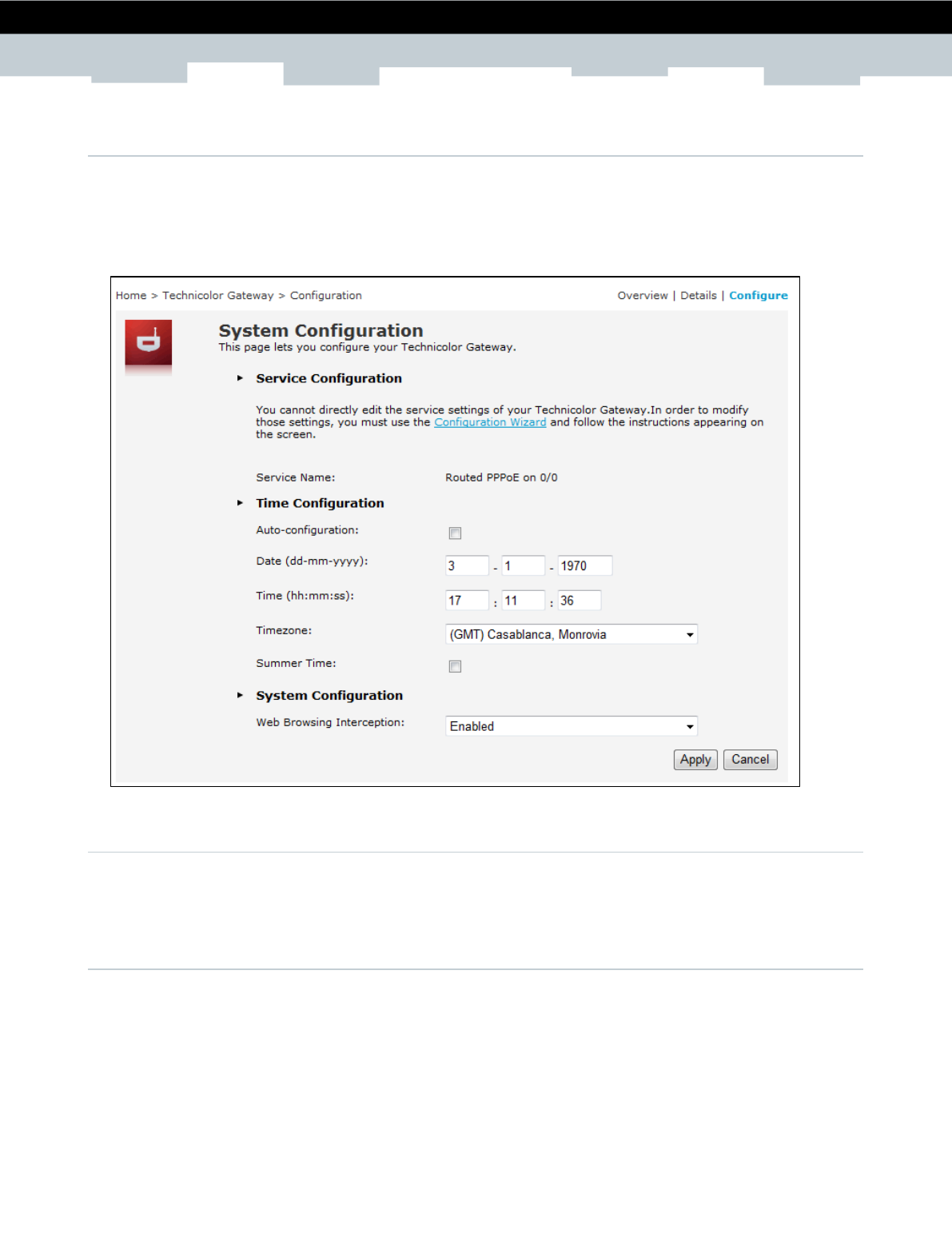
22
SETUP & USER GUIDE DWA0100
DWA0100-20170224-0000v0.0
Copyright © 2017 Technicolor. All rights reserved.
This document contains Technicolor proprietary and confidential information. Passing on and copying of this document, use,
extraction and communication of its contents, is not permitted without written authorization from Technicolor.
5.2 System Configuration
The System Configuration page allows you to configure the Internet service and the system date and
time, and enable web browsing interception.
To view the System Configuration page, click Technicolor Gateway > Configuration.
To modify the system configuration, click Configure.
5.2.1 DSL Service Configuration
To modify the DSL service configuration, click Configuration Wizard and then follow the instructions on
the screen. See “Configuration Wizard on page 15”.
5.2.2 Time Configuration
To modify the time configuration, do the one of following:
Manual Configuration
To manually set the date and time, enter the date and time values in the corresponding fields. Select a
Timezone or enable Summer Time for applicable areas.
Auto Configuration
To synchronize the date and time with a time server, do the following:
1 Check the Auto-configuration box.
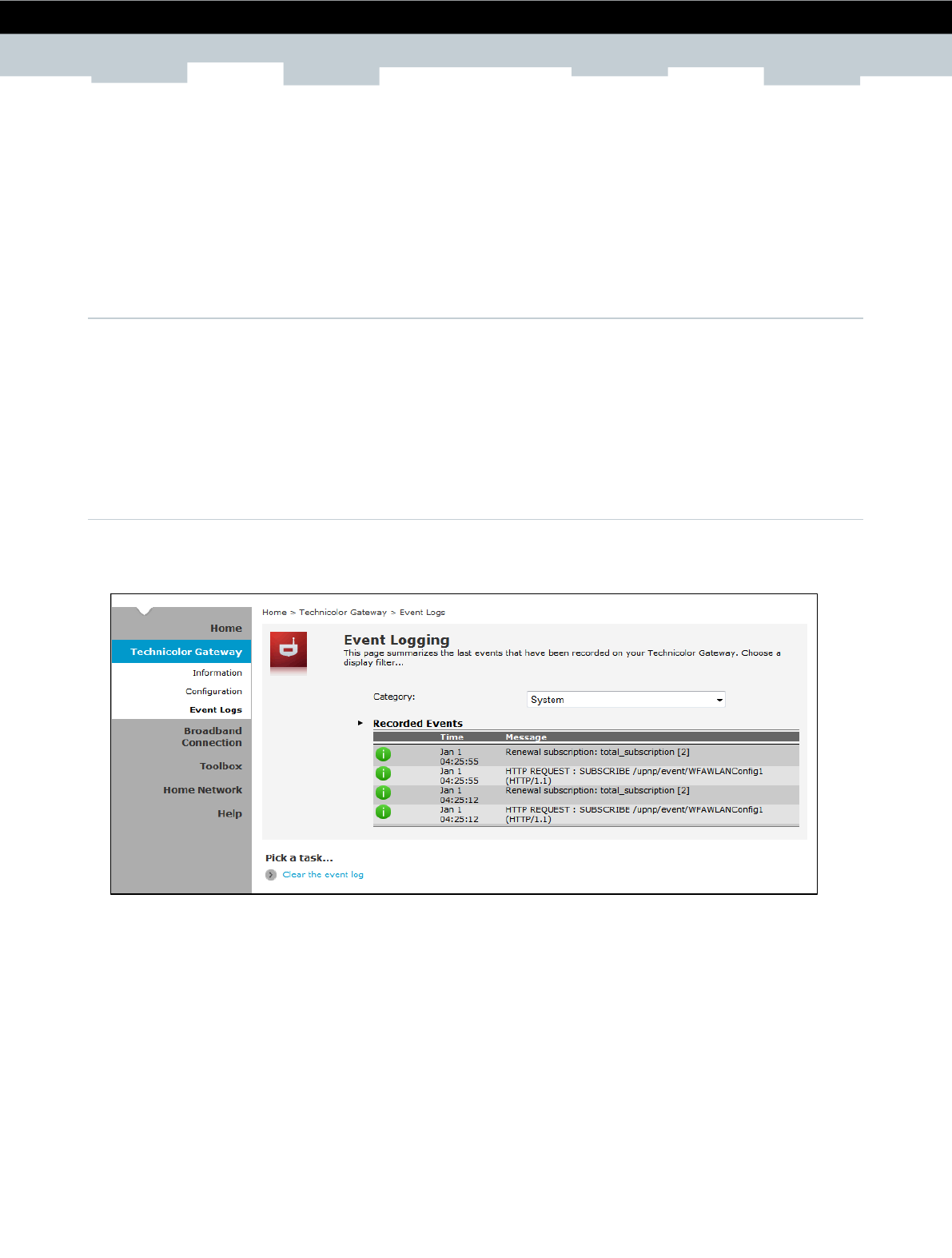
23
SETUP & USER GUIDE DWA0100
DWA0100-20170224-0000v0.0
Copyright © 2017 Technicolor. All rights reserved.
This document contains Technicolor proprietary and confidential information. Passing on and copying of this document, use,
extraction and communication of its contents, is not permitted without written authorization from Technicolor.
2 Enter the values of the applicable items in your location:
Timezone — Enter the time zone in your location.
Summer Time — Check if summer time is applicable in your location.
3 Enter the time server to sync the Wireless Gateway with. You can type up to five timer servers.
4 Click Apply to save changes.
5.2.3 Web Browsing Interception
5 On the Web Browsing Interception box, select one of the following:
Enabled (default) — To enable web browsing interception.
Disabled — To disable web browsing interception. When disabled, address based filtering is also
disabled.
6 Click Apply to save changes.
5.3 Event Logs
The Event Logs page allows you to view and clear system logs.
To access the Event Logs page, click Technicolor Gateway > Event Logs.
You can filter the list by selecting a category from the drop-down lists.
The log is automatically refreshed every 10 seconds.
To clear the log, click Clear the event log on the bottom of the page.
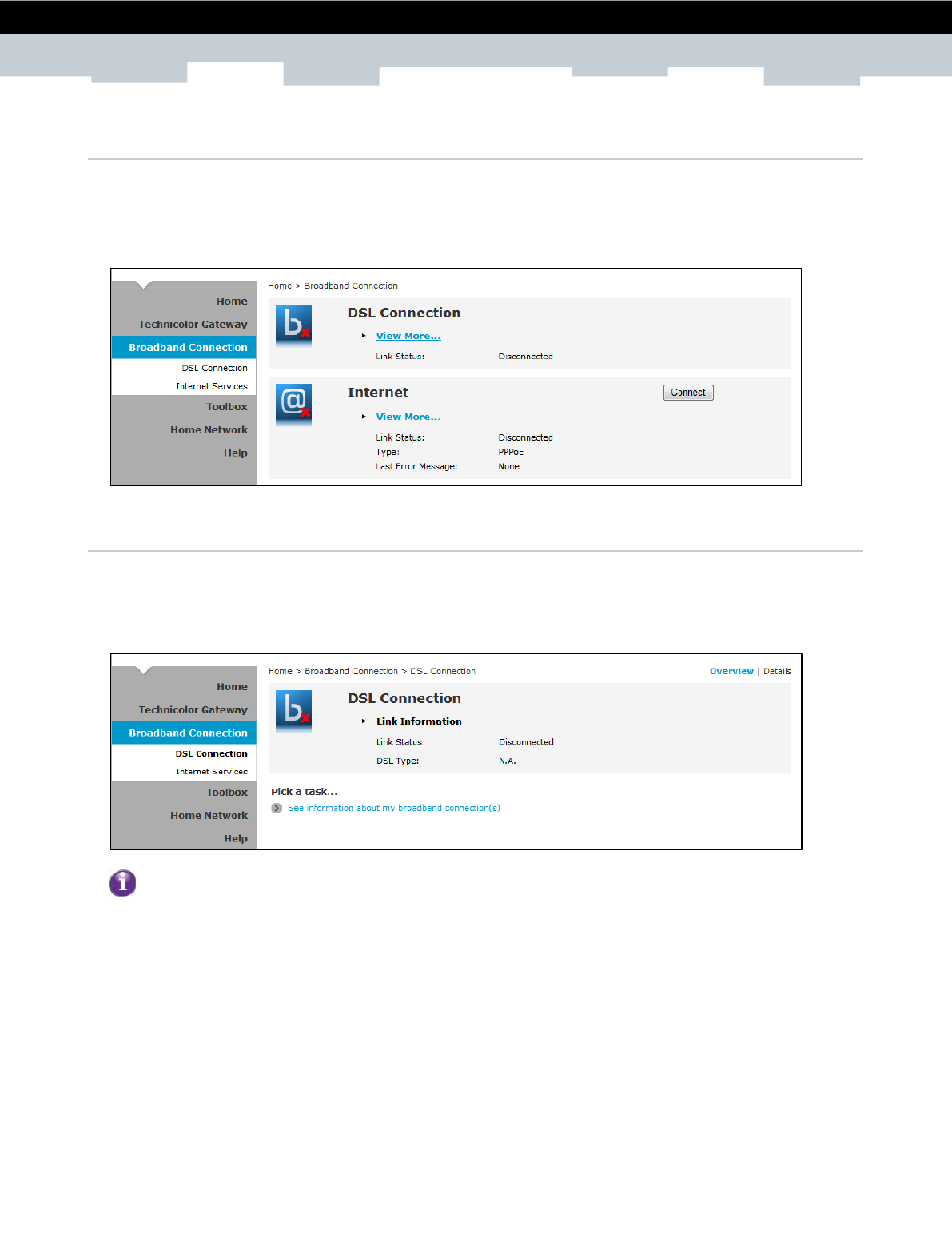
24
SETUP & USER GUIDE DWA0100
DWA0100-20170224-0000v0.0
Copyright © 2017 Technicolor. All rights reserved.
This document contains Technicolor proprietary and confidential information. Passing on and copying of this document, use,
extraction and communication of its contents, is not permitted without written authorization from Technicolor.
6 Broadband Connection
The Broadband Connection menu allows you to view and modify the Internet service configuration of
your Wireless Gateway. This menu is divided into two sections: DSL Connection and Internet Services.
To view the Broadband Connection page, click Broadband Connection.
6.1 DSL Connection
To view the DSL connection status, do one of the following:
▪ On the Broadband Connection page, click View more under DSL Connection.
▪ On the main menu, click Broadband Connection > DSL Connection.
DSL connection cannot be modified from this point. To modify the DSL connection, see “5.2.1 DSL
Service Configuration on page 22”.
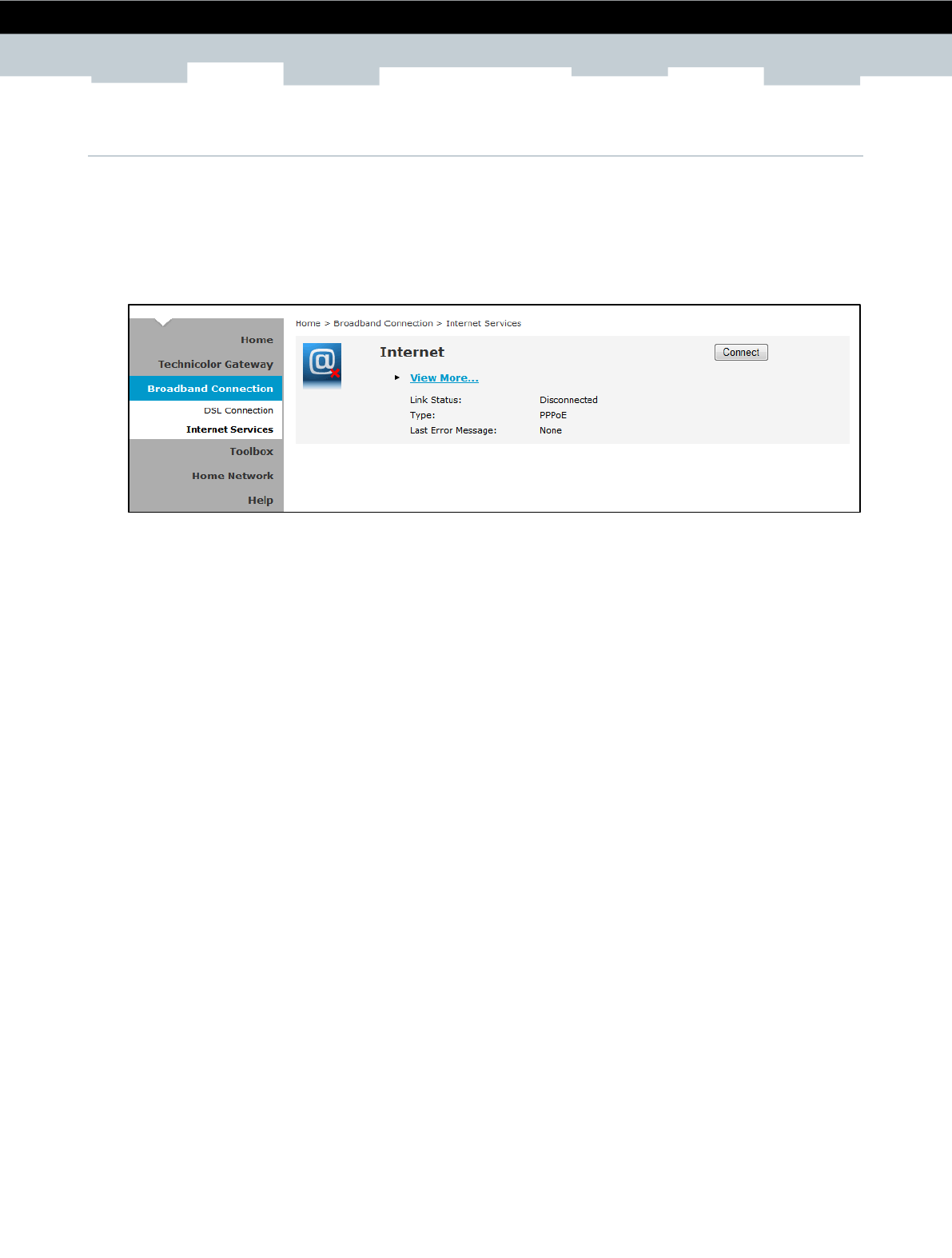
25
SETUP & USER GUIDE DWA0100
DWA0100-20170224-0000v0.0
Copyright © 2017 Technicolor. All rights reserved.
This document contains Technicolor proprietary and confidential information. Passing on and copying of this document, use,
extraction and communication of its contents, is not permitted without written authorization from Technicolor.
6.2 Internet Services
Use the Internet Services page to configure the settings and connect to the Internet. To view the Internet
page, do one of the following:
▪ From the Home screen, click Internet
▪ On the Broadband Connection page, click View more under Internet.
▪ On the main menu, click Broadband Connection > Internet Services > View More
To connect to the Internet, click Connect.
To modify the account username and password, re-type the information on the corresponding boxes,
and then click Connect.
To view more connection details, click Details on the upper corner of the page.
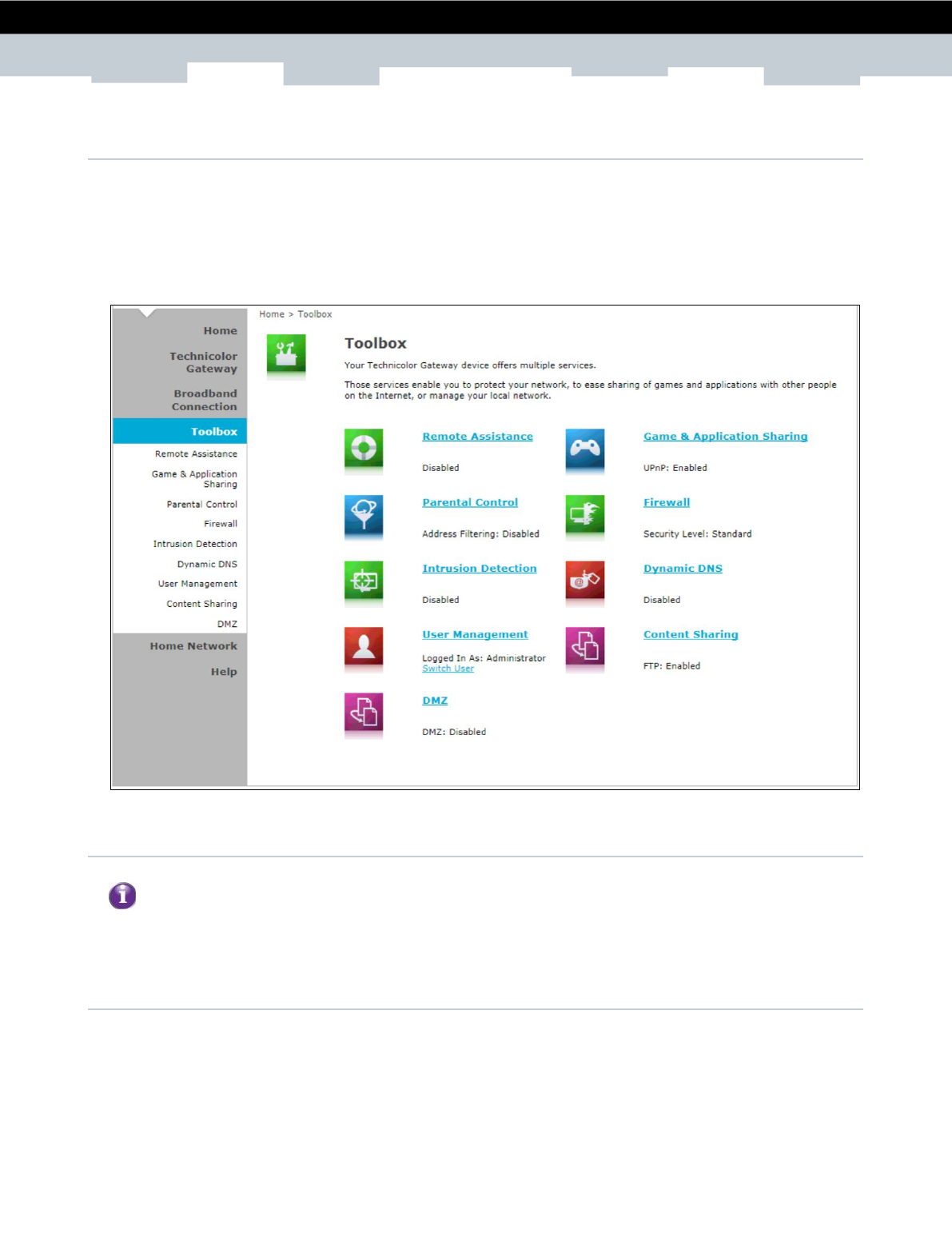
26
SETUP & USER GUIDE DWA0100
DWA0100-20170224-0000v0.0
Copyright © 2017 Technicolor. All rights reserved.
This document contains Technicolor proprietary and confidential information. Passing on and copying of this document, use,
extraction and communication of its contents, is not permitted without written authorization from Technicolor.
7 Toolbox
The Toolbox menu allows you to protect your network, share games and applications with other people
on the Internet, and manage your local network. This menu is divided into nine sections: Remote
Assistance, Game & Application Sharing, Parental Control, Firewall, Intrusion Detection, Dynamic
DNS, User Management, Content Sharing, and DMZ.
To view the Toolbox page, click Toolbox on the main menu.
7.1 Remote Assistance
To enable remote assistance, you must be connected to the Internet.
The Remote Assistance page allows you to make your Wireless Gateway remotely accessible.
7.1.1 Enable Remote Assistance
1 Select the remote assistance Mode:
Permanent Mode — Once remote assistance is enabled, the remote session only ends when users
disable this feature or when the Wireless Gateway is restarted.
2 Enter the URL address to use to remotely access your Wireless Gateway.
3 Take note of the automatically generated User Name and Password that will be used to access your
Wireless Gateway remotely. If desired, modify the password.
4 Check Enable Remote Assistance to enable this function.
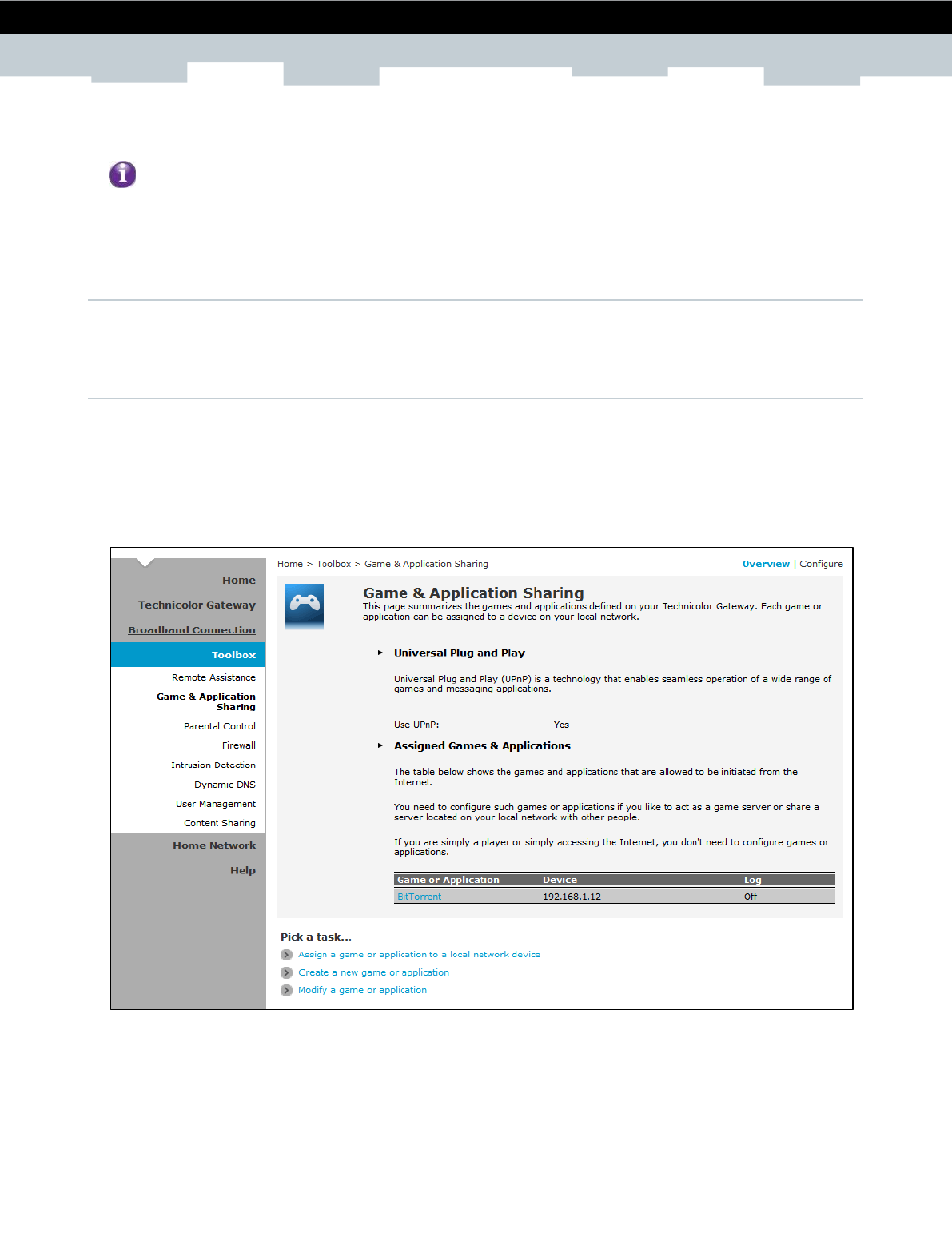
27
SETUP & USER GUIDE DWA0100
DWA0100-20170224-0000v0.0
Copyright © 2017 Technicolor. All rights reserved.
This document contains Technicolor proprietary and confidential information. Passing on and copying of this document, use,
extraction and communication of its contents, is not permitted without written authorization from Technicolor.
5 Click Apply to save changes.
▪ Only one remote session is allowed at a time.
▪ The Wireless Gateway also supports dynamic DNS host names for remote access. See "7.6
Dynamic DNS" on page 34.
7.1.2 Disable Remote Assistance
Click Disable Remote Assistance to disable this function.
7.2 Game & Application Sharing
The Game & Application Sharing page allows you to create new games and applications and assign
games or applications to the network devices.
To view the Game & Application Sharing page, do one of the following:
▪ From the Home screen, click Game & Application Sharing under Toolbox.
▪ On the main menu, click Toolbox > Game & Application Sharing.
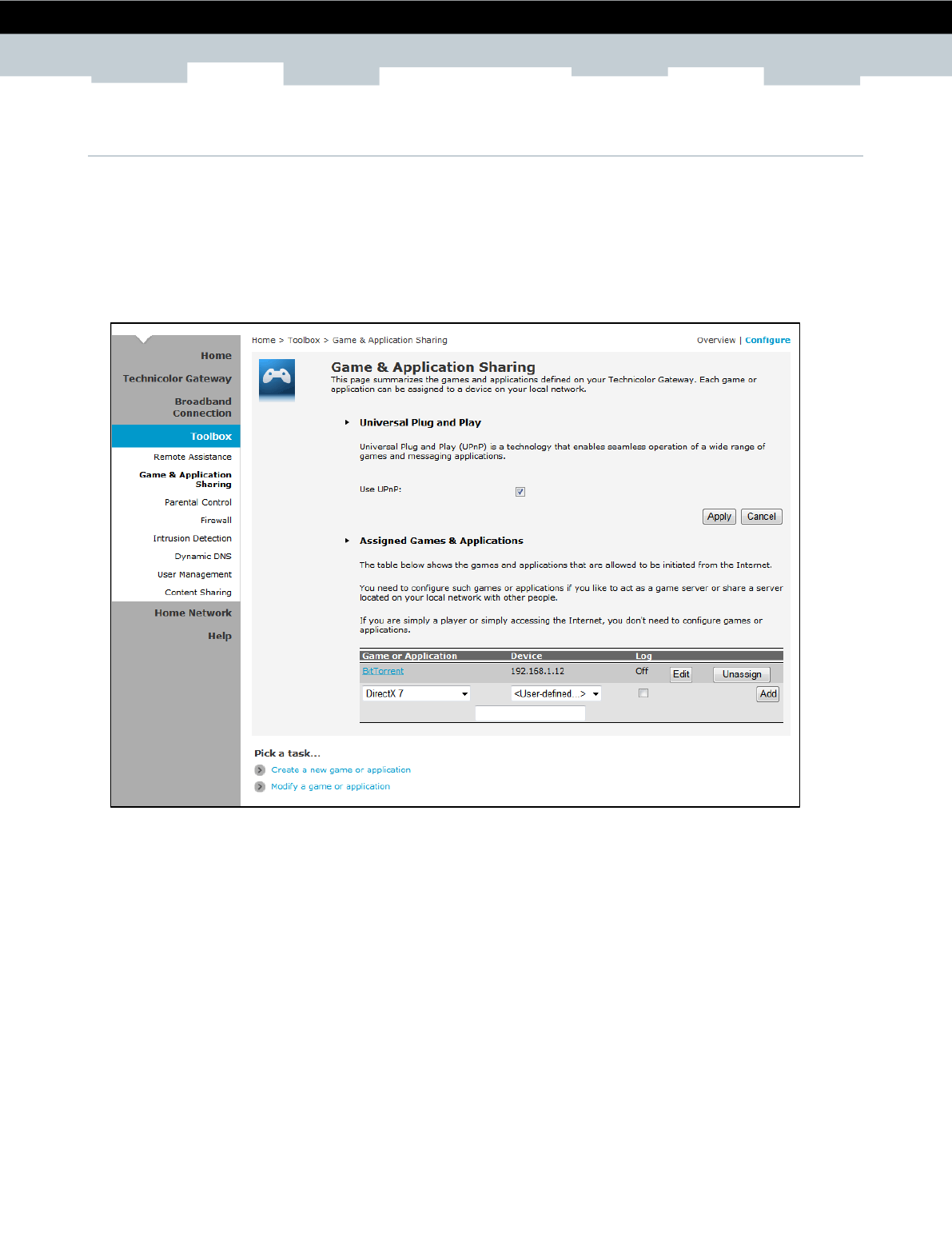
28
SETUP & USER GUIDE DWA0100
DWA0100-20170224-0000v0.0
Copyright © 2017 Technicolor. All rights reserved.
This document contains Technicolor proprietary and confidential information. Passing on and copying of this document, use,
extraction and communication of its contents, is not permitted without written authorization from Technicolor.
7.2.1 Assign a Game or Application
Your Wireless Gateway comes with predefined games and applications. Each game or application can be
assigned to a network device.
1 To assign a game or application, do one of the following:
Click Configure on the upper-right corner of the screen.
Click the Assign a game or application to a local network device shortcut at the bottom of the
screen.
2 To enable Universal Plug and Play (UPnP) function, check the Use UPnP box and then click Apply.
3 On the Assigned Games & Applications table, select a game or application on the Game or
Application field.
4 On the Device field, select the network device to assign the game or application to.
5 To log access, check the Log box.
6 Click Add to add the assigned entry to the table.
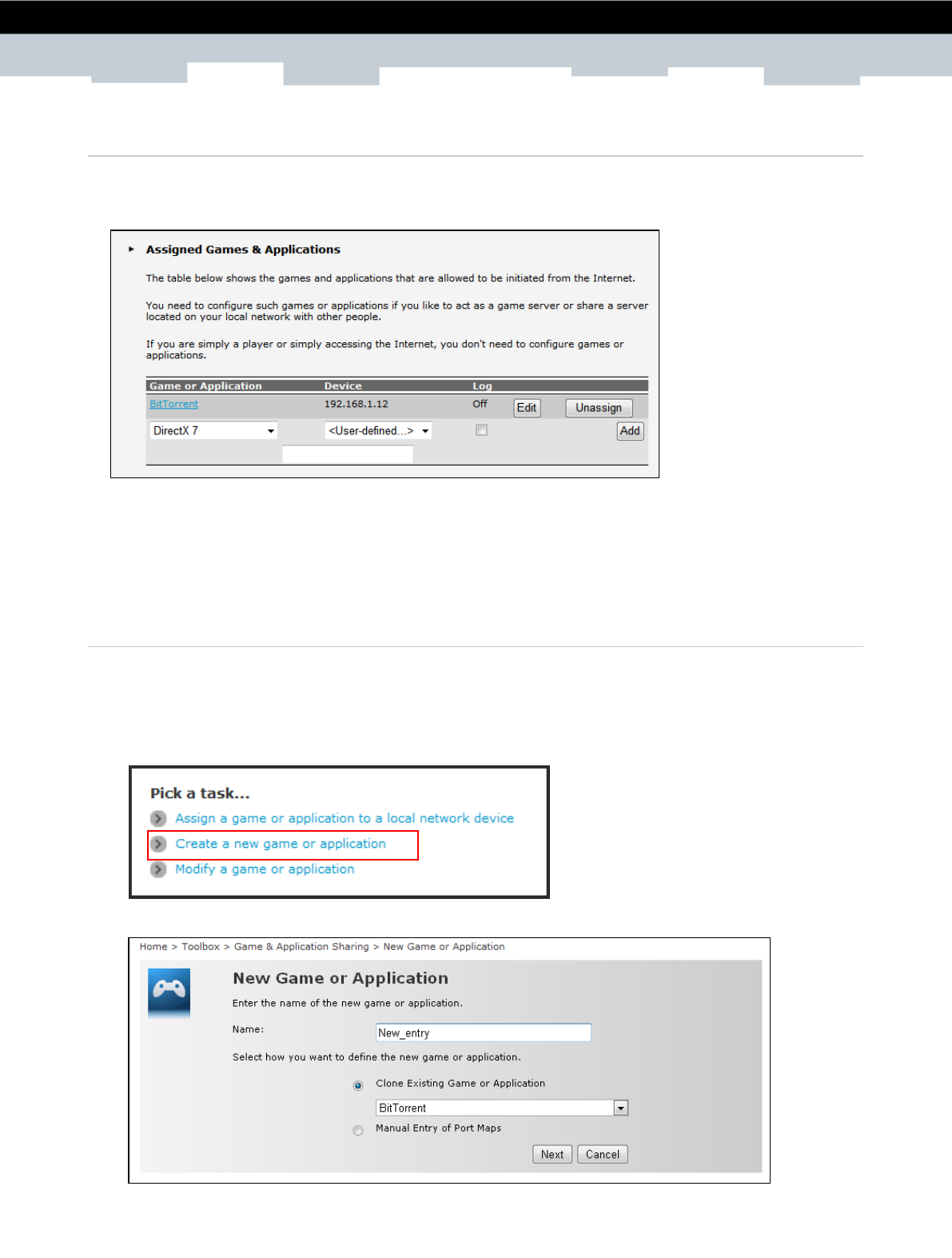
29
SETUP & USER GUIDE DWA0100
DWA0100-20170224-0000v0.0
Copyright © 2017 Technicolor. All rights reserved.
This document contains Technicolor proprietary and confidential information. Passing on and copying of this document, use,
extraction and communication of its contents, is not permitted without written authorization from Technicolor.
7.2.2 Modify Assigned Game or Application
1 On the main menu, click Toolbox > Game & Application Sharing.
2 From the Game & Application page, click Configure on the upper-right corner of the screen.
3 On the Assigned Games & Applications table, click the Edit button of the game or application you
want to modify.
4 Modify the necessary info.
5 Click Apply to save changes.
7.2.3 Create a New Game or Application
If the game or application is not included in the predefined list, you need to create the game or application.
1 On the main menu, click Toolbox > Game & Application Sharing.
2 From the Game & Application page, click the Create a new game or application shortcut at the
bottom of the screen.
3 On Name, type the name of the game or application.
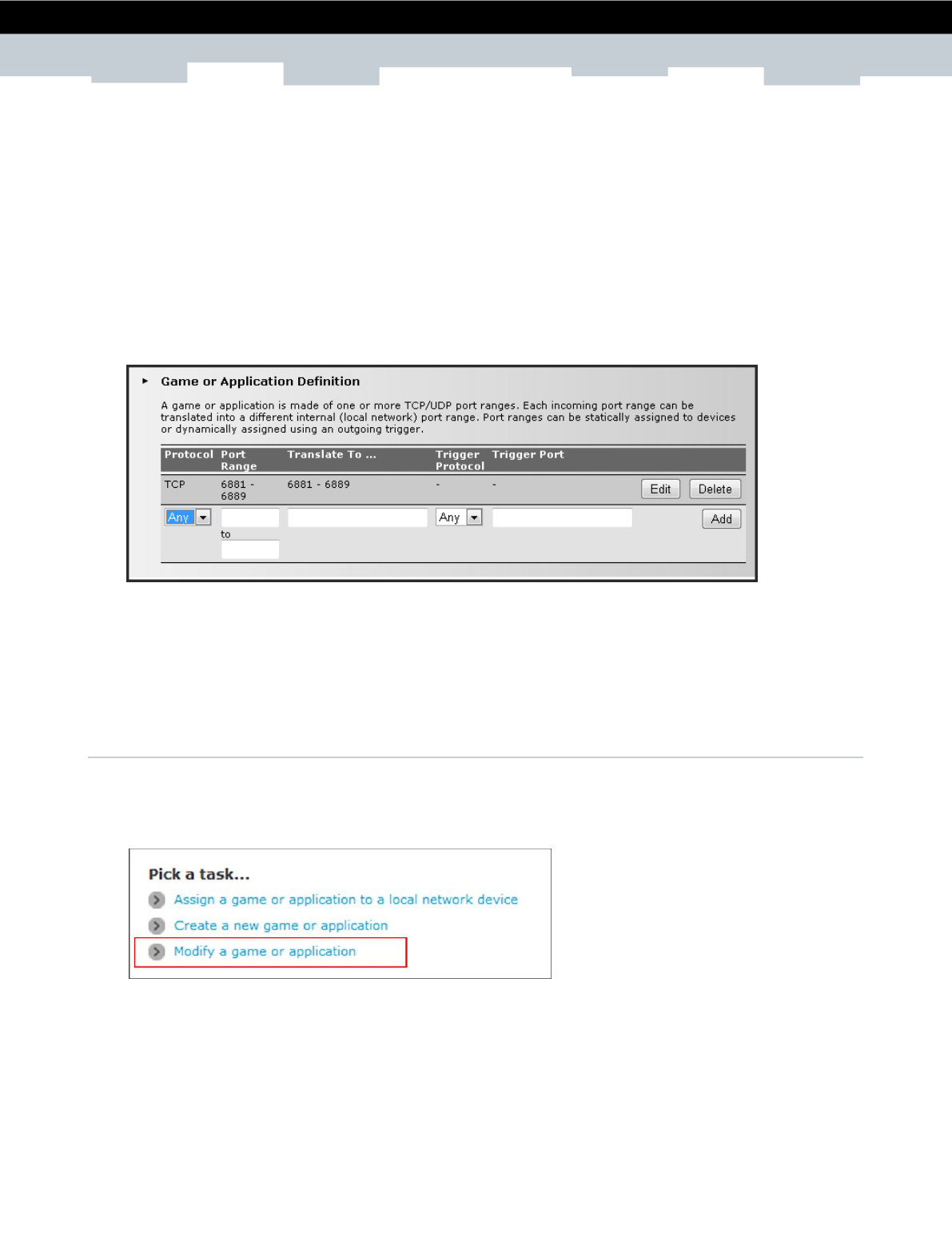
30
SETUP & USER GUIDE DWA0100
DWA0100-20170224-0000v0.0
Copyright © 2017 Technicolor. All rights reserved.
This document contains Technicolor proprietary and confidential information. Passing on and copying of this document, use,
extraction and communication of its contents, is not permitted without written authorization from Technicolor.
4 Select how you want to define the new game or application:
Clone Exiting Game or Application — Select an existing game or application to clone its protocol
and TCP/UDP port range settings.
Manual Entry of Port Maps — To manually select the protocol and enter the port range of the new
game or application.
5 Click Next to continue.
6 If Clone Exiting Game or Application is selected on step 4, skip to step 8.
7 If Manual Entry of Port Maps is selected on step 4, configure the parameters of the Game or
Application Definition table. A preset incoming port range is set by the Wireless Gateway. You may
add, edit, or delete this range. To add a TCP/UDP port range, do the following:
a Select the protocol.
b Enter the incoming port range and the outgoing trigger port.
c Click Add to save the settings.
8 Creating of game or application is complete.
7.2.4 Modify a Game or Application
1 On the main menu, click Toolbox > Game & Application Sharing.
2 From the Game & Application page, click the Modify a game or application shortcut at the bottom of
the screen.
3 The list of games and applications appear. Click the Edit button of the game or application you want to
modify.
4 Modify the necessary information.
5 Click Apply to save changes.
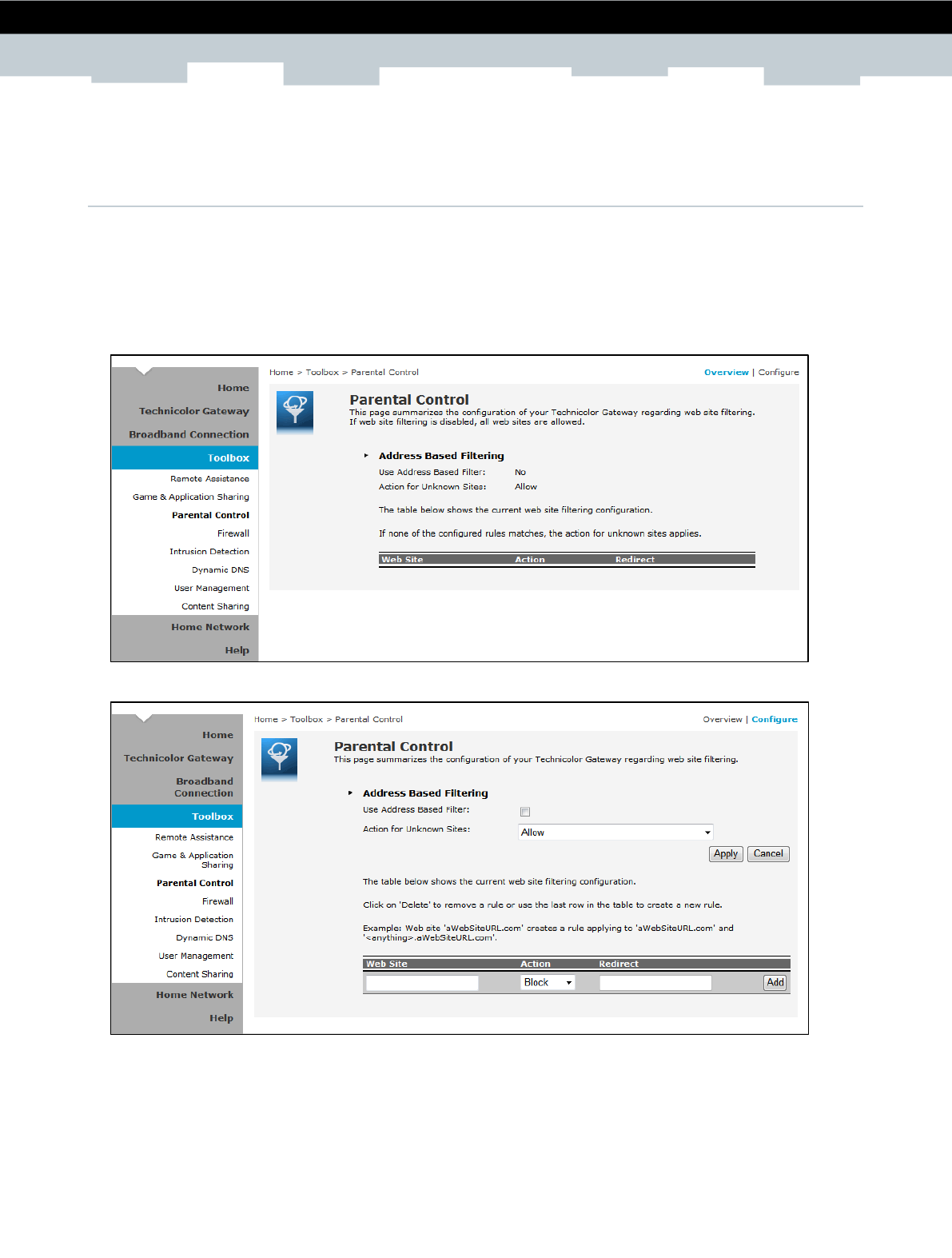
31
SETUP & USER GUIDE DWA0100
DWA0100-20170224-0000v0.0
Copyright © 2017 Technicolor. All rights reserved.
This document contains Technicolor proprietary and confidential information. Passing on and copying of this document, use,
extraction and communication of its contents, is not permitted without written authorization from Technicolor.
To delete a game or application, click the Delete button of the game or application you want to delete.
7.3 Parental Control
The Parental Control page allows you to filter web sites that a network device may access or be denied
access.
To view the Parental Control page, do one of the following:
▪ From the Home screen, click Parental Control under Toolbox.
▪ On the main menu, click Toolbox > Parental Control.
To configure parental control, click Configure on the upper-right corner of the screen.
▪ Use Address Based Filter — Check to filter web sites by address.
▪ Action for Unknown Sites — Select whether to Block or Allow unknown sites.
▪ Click Apply to save changes.
▪ Web Site — Enter the URL of the web site to block or allow.
▪ Action — Select one of the following options:
Block: To block the web site.
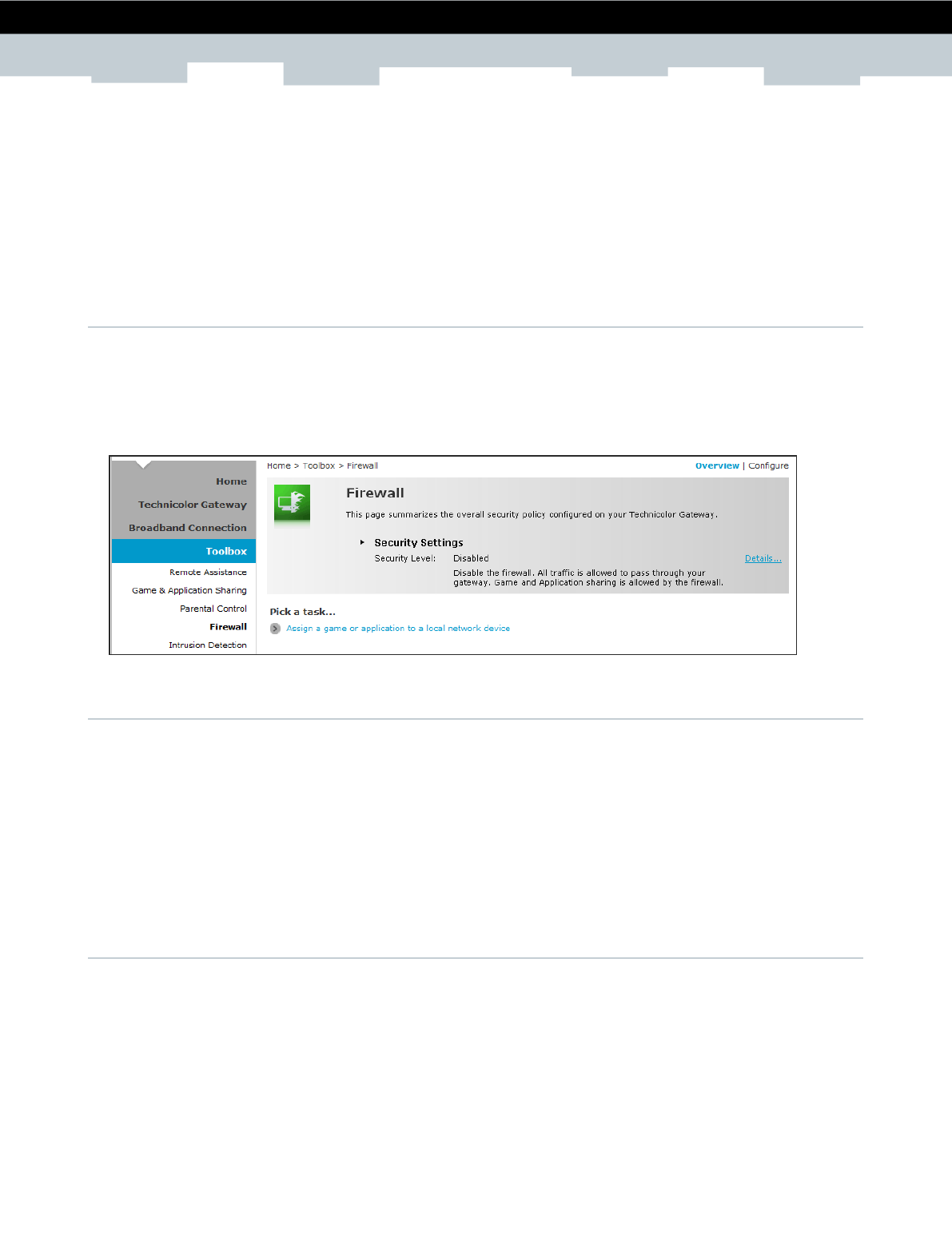
32
SETUP & USER GUIDE DWA0100
DWA0100-20170224-0000v0.0
Copyright © 2017 Technicolor. All rights reserved.
This document contains Technicolor proprietary and confidential information. Passing on and copying of this document, use,
extraction and communication of its contents, is not permitted without written authorization from Technicolor.
Allow: To allow access to the web site.
Redirect: To redirect to another web site if the web site defined on the Web Site field is being
accessed.
▪ Redirect — If Redirect is selected in Action, enter the URL address to where you want to redirect the
site.
▪ Click Add to save the changes to the table.
7.4 Firewall
The Firewall page allows you to set the firewall security of your Wireless Gateway.
To view the Firewall page, do one of the following:
▪ From the Home screen, click Firewall under Toolbox.
▪ On the main menu, click Toolbox > Firewall.
7.4.1 Change Firewall Security Level
1 On the Firewall page, click Configure on the upper-right corner of the screen.
2 Select the desired security level:
Block All — Block all traffic from and to the Internet.
Standard — Block all incoming traffic but allow outgoing traffic.
Disabled — Disable firewall security, all traffic is allowed.
3 Click Apply to save changes.
7.4.2 Create a New Security Level
1 On the Firewall page, click Configure on the upper-right corner of the screen.
2 Click the Create a new Security Level shortcut at the bottom of the screen. The New Firewall Level
screen appears.
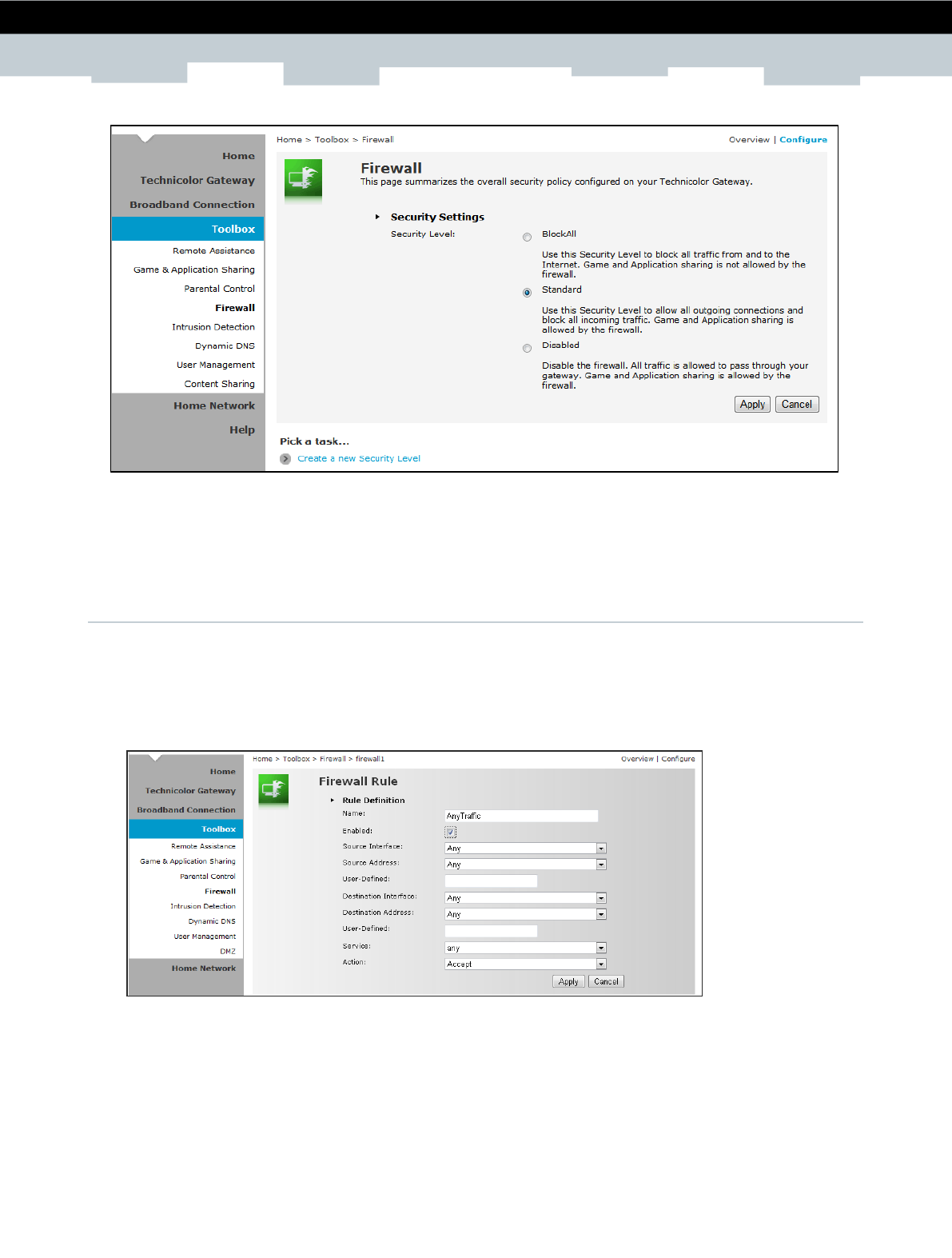
33
SETUP & USER GUIDE DWA0100
DWA0100-20170224-0000v0.0
Copyright © 2017 Technicolor. All rights reserved.
This document contains Technicolor proprietary and confidential information. Passing on and copying of this document, use,
extraction and communication of its contents, is not permitted without written authorization from Technicolor.
3 Enter the name for the new firewall security level.
4 Select a security level.
5 Click Apply to save changes.
7.4.3 Set Filter Rules
After you create a new security level, you can set firewall rules.
1 On the Firewall page, click Configure on the upper-right corner of the screen.
2 Click Edit. The Firewall Settings appears.
3 On the Firewall Settings table, click Add.
4 Enter the necessary parameters:
Name — Enter desired firewall rule name
Enabled — Check this box to enable this firewall rule.
Source Interface — Select the interface to apply the firewall rule.
Source Address — Select the firewall source address.
User-Defined — If the address is not listed in the Source Address box, enter a user-defined address
here.
Destination Interface — Select the destination interface.
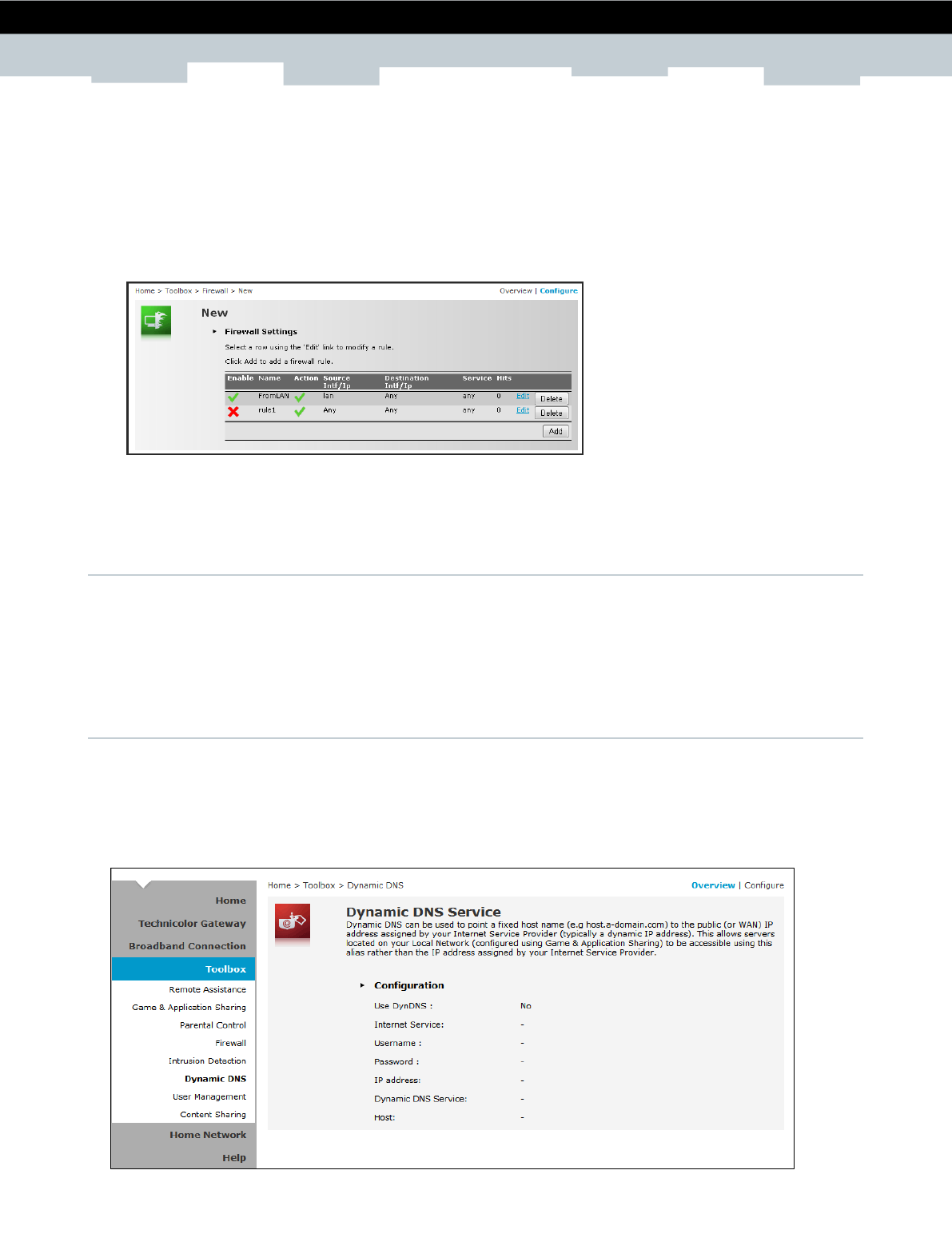
34
SETUP & USER GUIDE DWA0100
DWA0100-20170224-0000v0.0
Copyright © 2017 Technicolor. All rights reserved.
This document contains Technicolor proprietary and confidential information. Passing on and copying of this document, use,
extraction and communication of its contents, is not permitted without written authorization from Technicolor.
Destination address — Select the destination address.
User-Defined — If the address is not listed in the Destination Address box, enter a user-defined
address here.
Service — Select a service.
Action — Select the action to take: Deny or Accept.
5 Click Apply to save changes. The new firewall rule appears on the Firewall Settings table.
To edit a firewall rule, click Edit.
To delete a firewall rule, click Delete.
7.5 Intrusion Detection
Your Wireless Gateway protects your network against malicious intrusions. The Intrusion Detection page
shows you the intrusions that you are protected against. The Protected Intrusions table shows the
number of times the Wireless Gateway actively protected your network against each intrusions.
To view the Intrusion Detection page, on the main menu, click Toolbox > Intrusion Detection.
7.6 Dynamic DNS
The Dynamic DNS (DDNS) service allows you to assign a fixed DNS host name to an Internet connection
even if it is using a dynamic IP address. As soon as your Wireless Gateway internal connection gets a
new IP address, the dynamic DNS service updates the host name entry to the new IP address. The
dynamic DNS service relies on servers that link the public IP address to a subscribed DNS host name.
To view the Dynamic DNS page, on the main menu, click Toolbox > Dynamic DNS.
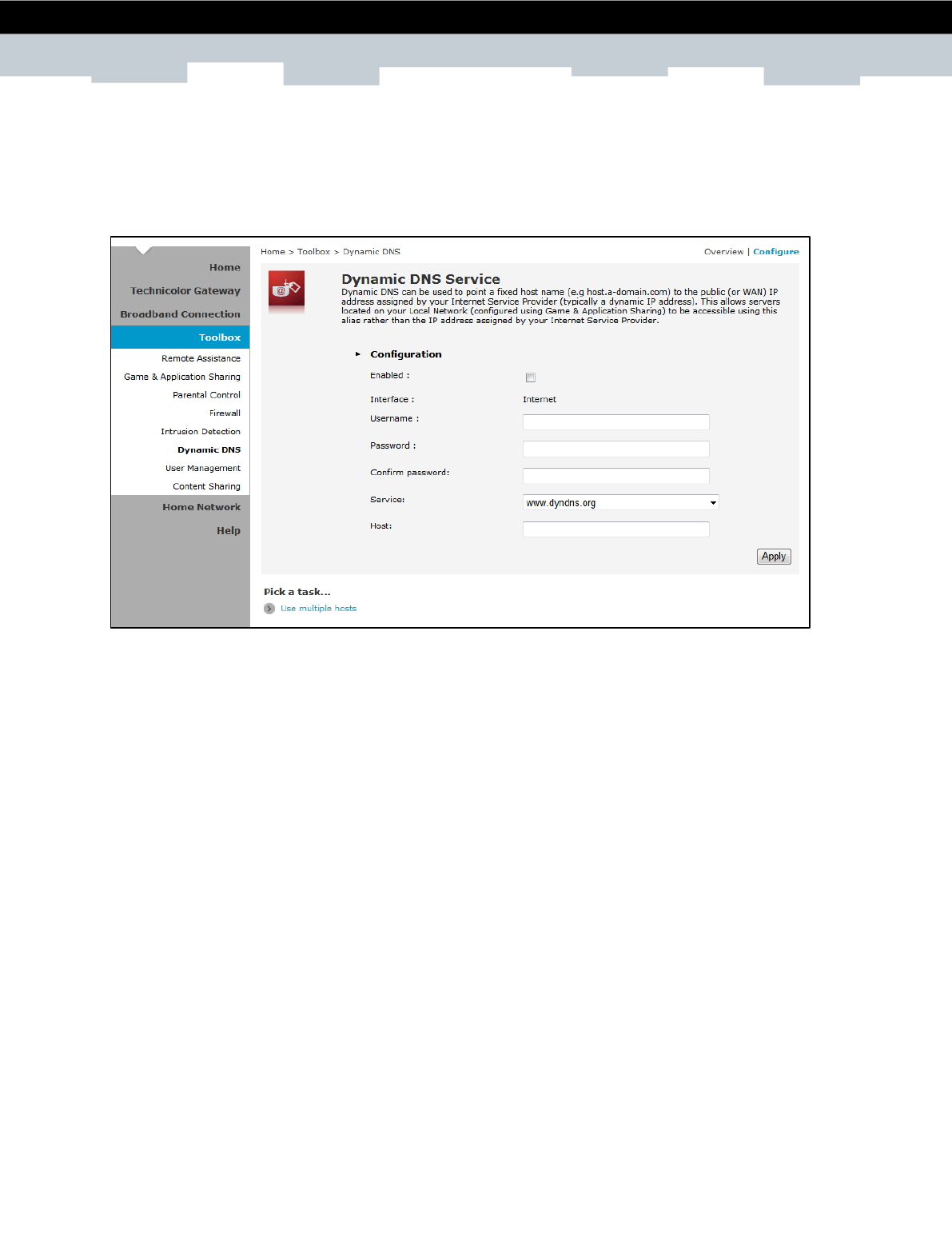
35
SETUP & USER GUIDE DWA0100
DWA0100-20170224-0000v0.0
Copyright © 2017 Technicolor. All rights reserved.
This document contains Technicolor proprietary and confidential information. Passing on and copying of this document, use,
extraction and communication of its contents, is not permitted without written authorization from Technicolor.
In order to use a dynamic DNS service, you must first register and enroll for DNS service with a Dynamic
DNS service provider. The DDNS service provider will provide the necessary parameters to complete your
Wireless Gateway Dynamic DNS setup.
To configure the Dynamic DNS service of your Wireless Gateway, click Configure on the upper-right
corner of the screen.
▪ Enabled — Check this box to enable the DDNS.
▪ Interface — The DDNS interface is the Internet.
▪ Username — Enter the username provided by the DDNS service provider.
▪ Password — Enter the password provided by the DDNS service provider.
▪ Confirm Password — Re-type the password to confirm.
▪ Service — Select the DDNS service provider where your account is registered.
▪ Host — Type the host name.
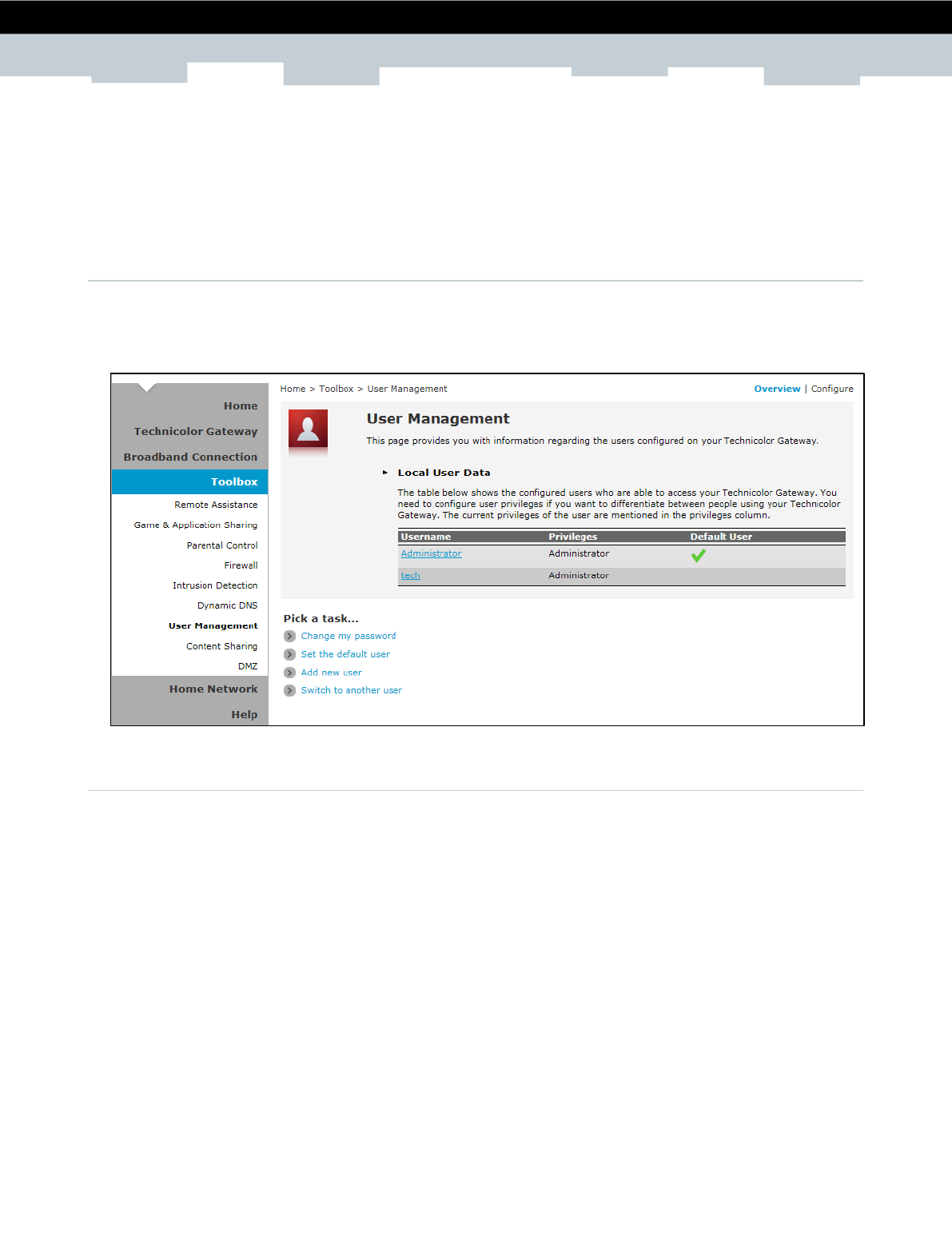
36
SETUP & USER GUIDE DWA0100
DWA0100-20170224-0000v0.0
Copyright © 2017 Technicolor. All rights reserved.
This document contains Technicolor proprietary and confidential information. Passing on and copying of this document, use,
extraction and communication of its contents, is not permitted without written authorization from Technicolor.
Click Apply to save changes.
To use multiple hosts, click the Use multiple hosts shortcut at the bottom of the screen. Then click Add to
add host name.
7.7 User Management
The User Management page allows you to configure the users who can access the Wireless Gateway
web configuration utility.
To view the User Management page, click Toolbox > User Management.
7.7.1 Add New User
1 Click the Add new user shortcut at the bottom of the screen.
2 On Name, type desired user name. This will be the login name and the password of the new user.
3 On Administrator Privileges, select the user privilege.
4 Click Apply to save changes.
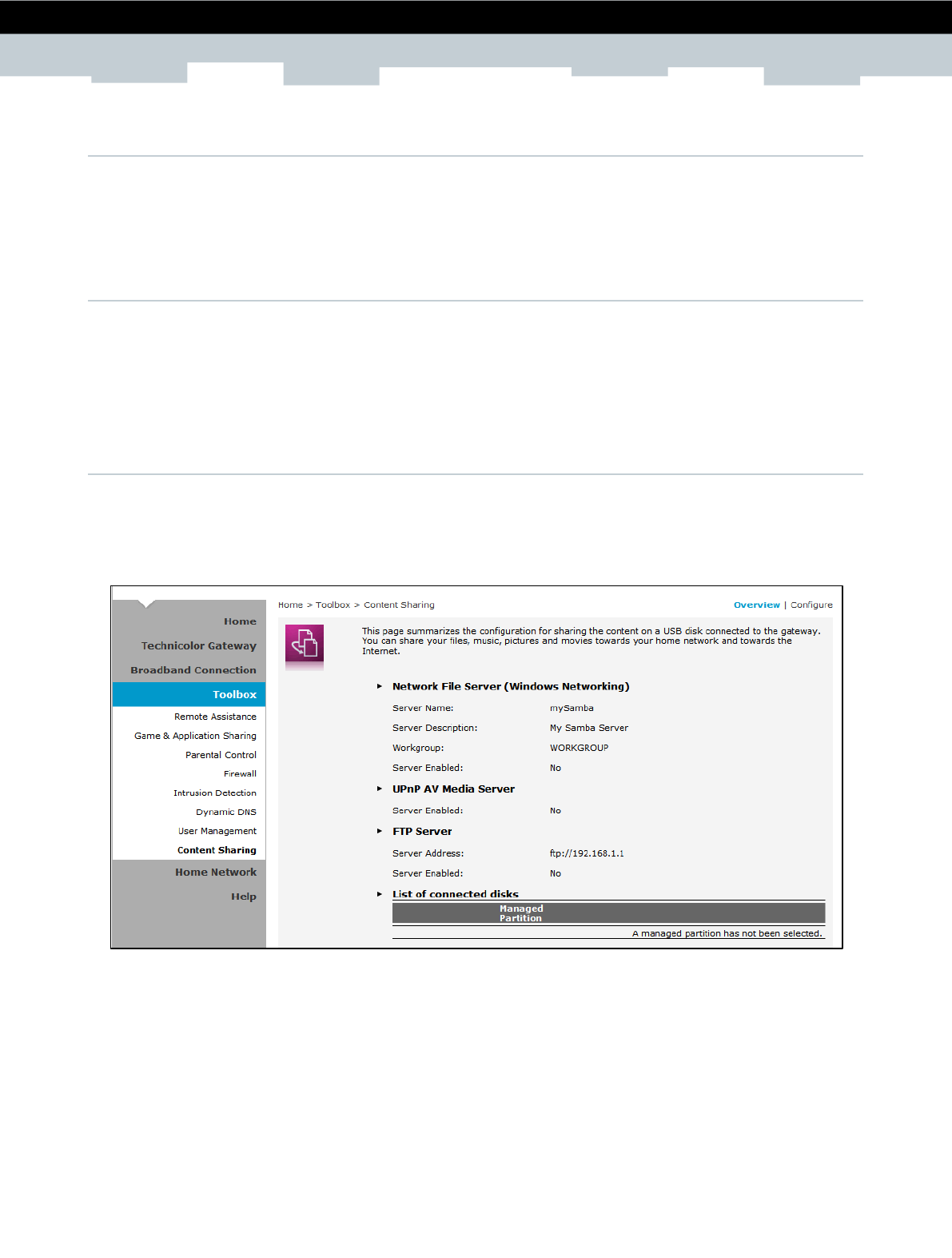
37
SETUP & USER GUIDE DWA0100
DWA0100-20170224-0000v0.0
Copyright © 2017 Technicolor. All rights reserved.
This document contains Technicolor proprietary and confidential information. Passing on and copying of this document, use,
extraction and communication of its contents, is not permitted without written authorization from Technicolor.
7.7.2 Reset Password
To reset a password, on the User Management screen, click on the user account that you want to reset
the password. Then click Reset Password.
Aside from resetting the password, no other setting can be modified unless by users of higher privileges.
7.7.3 Manage Users
To change the default user, click the Set the default user shortcut at the bottom of the screen.
To switch to another user, click the Switch to another user shortcut at the bottom of the screen. This
brings you back to the login page, then login with the desired user account.
7.8 Content Sharing
The Content Sharing page allows you to share the contents on a USB disk connected to the gateway.
You can share your files, music, pictures and movies towards your home network and towards the
Internet.
To view the Content Sharing page, on the main menu, click Toolbox > Content Sharing.
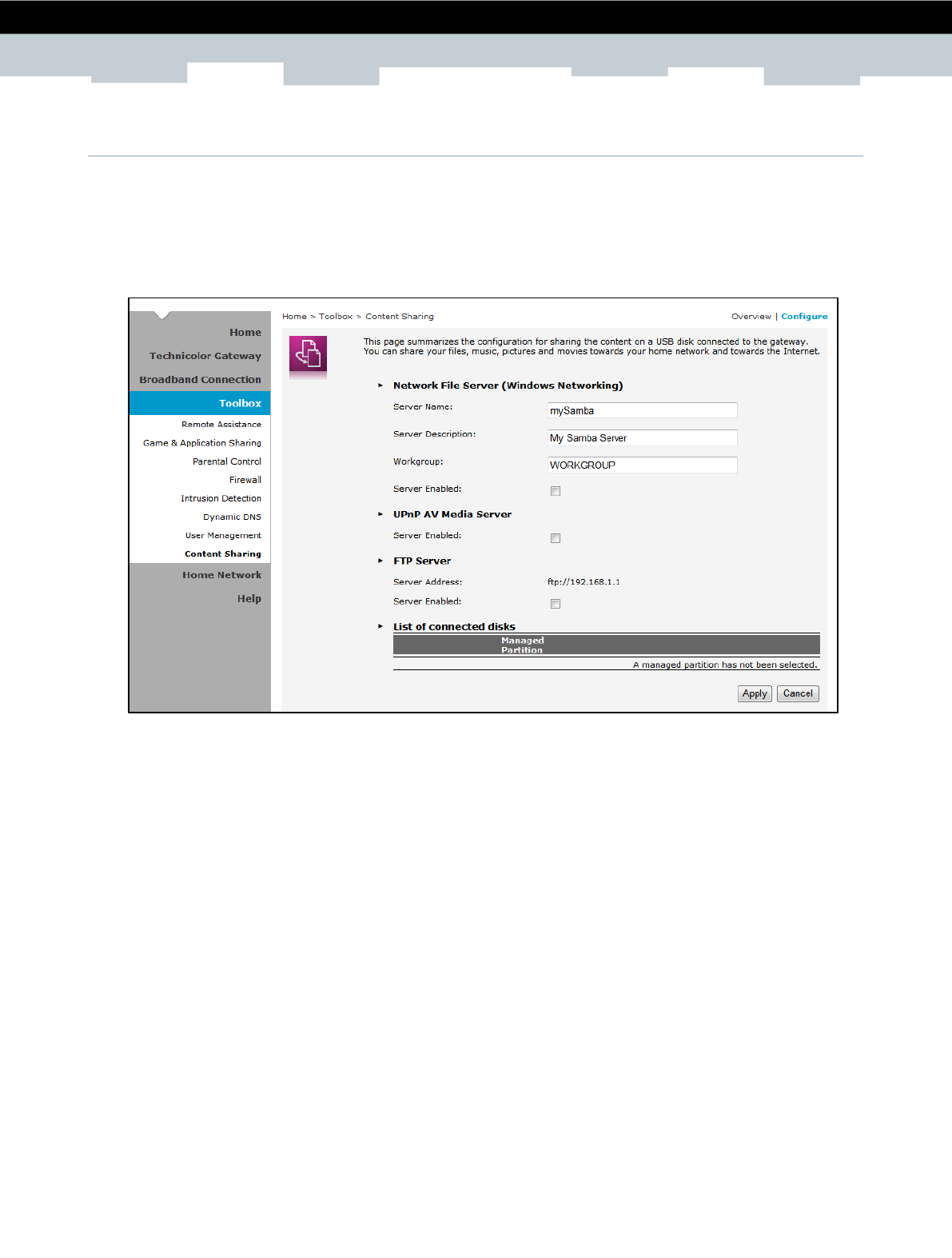
38
SETUP & USER GUIDE DWA0100
DWA0100-20170224-0000v0.0
Copyright © 2017 Technicolor. All rights reserved.
This document contains Technicolor proprietary and confidential information. Passing on and copying of this document, use,
extraction and communication of its contents, is not permitted without written authorization from Technicolor.
7.8.1 Setting up a Network File Server
To Set Up a Network file Server
Proceed as follows (for Windows Networking only):
1 Click Configure on the upper right corner of the screen.
2 Under Network File Server (Windows Networking), click Server Enabled. It is also recommended to fill
in the following fields:
Server Name
Server Description
Workgroup
3 Click Apply.
4 All users connected to the Technicolor Gateway can now connect to your USB storage device.
To Access Your Shared USB Devices on Windows
Proceed as follows:
1 Open Windows Explorer.
2 In the address bar type \\Technicolor or 192.168.1.254.
3 All storage devices that are attached to your Technicolor Gateway are listed as folders. If you attached
more than one storage device the folder name will contains an index number (for example device2).
4 If you plan to frequently use this folder, it might be useful to map this folder as a network drive. For
more information, see your operating system's help.
To Access Your Shared USB Devices on Mac
Proceed as follows:
1 On the Go menu, click Network.

39
SETUP & USER GUIDE DWA0100
DWA0100-20170224-0000v0.0
Copyright © 2017 Technicolor. All rights reserved.
This document contains Technicolor proprietary and confidential information. Passing on and copying of this document, use,
extraction and communication of its contents, is not permitted without written authorization from Technicolor.
2 Double-click Technicolor.
3 The SMB Mount window appears.
4 Select the device you want to mount and click OK.
5 Double-click the DEVICE icon on your desktop.
7.8.2 Setting up the Technicolor UPnP AV Server
To set up the Technicolor UPnP AV Server, proceed as follows:
1 Under UPnP AV Media Server, click Server Enabled.
2 Click Apply.
7.8.3 Setting up an FTP Server
To set up and FTP Server, proceed as follows:
1 Under FTP Server, click Server Enabled.
2 Under List of connected disks, click the radio button next to the partition that you want to access
using FTP.
3 The Wireless Gateway now creates Media and Shared folders on the selected partition. The Shared
folder will be used as root location for FTP sessions.
4 Click Apply.
As you may know the IP address of your Internet connection may change frequently. This implies
that the link to the FTP server will also change every time the public IP changes. With Dynamic
DNS you can assign a host name to the IP address (for example mygateway.dyndns.org). For more
information, see Dynamic DNS.
Make sure to unmount your device before unplugging it. Unplugging your device without
unmounting it properly first can result in disk corruption. See Unmounting your device for more
information.
7.8.4 Unmounting Your USB Device
To unmount your USB device, proceed as follows:
1 In the Toolbox menu click Content Sharing.
2 Click Configure on the upper right corner of the screen.
3 In the List of connected disks, you can unmount the device you want to unplug by clicking Unmount.
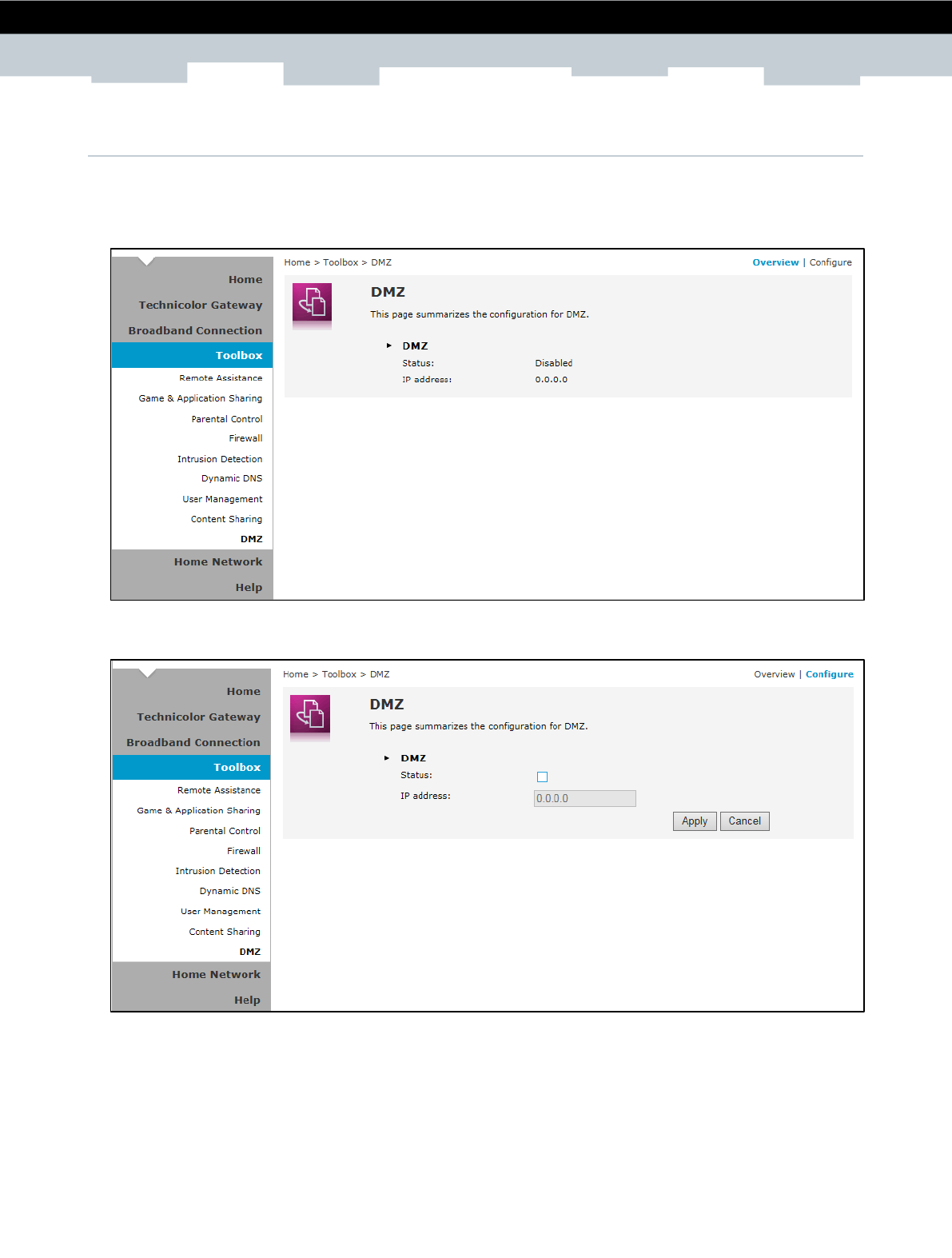
40
SETUP & USER GUIDE DWA0100
DWA0100-20170224-0000v0.0
Copyright © 2017 Technicolor. All rights reserved.
This document contains Technicolor proprietary and confidential information. Passing on and copying of this document, use,
extraction and communication of its contents, is not permitted without written authorization from Technicolor.
7.9 DMZ
The DMZ page allows you to configure the IP address of a computer on your local network to which to
forward incoming connections from the Internet that are not for the content sharing service.
To view the DMZ page, on the main menu, click Toolbox > DMZ.
To configure a default server for your Wireless Gateway, click Configure on the upper-right corner of the
screen.
▪ Status — Check this box to enable the default server.
▪ IP address — Enter the IP address of a computer on your local network to which to forward incoming
connections from the Internet that are not for the content sharing service.
Click Apply to save changes.
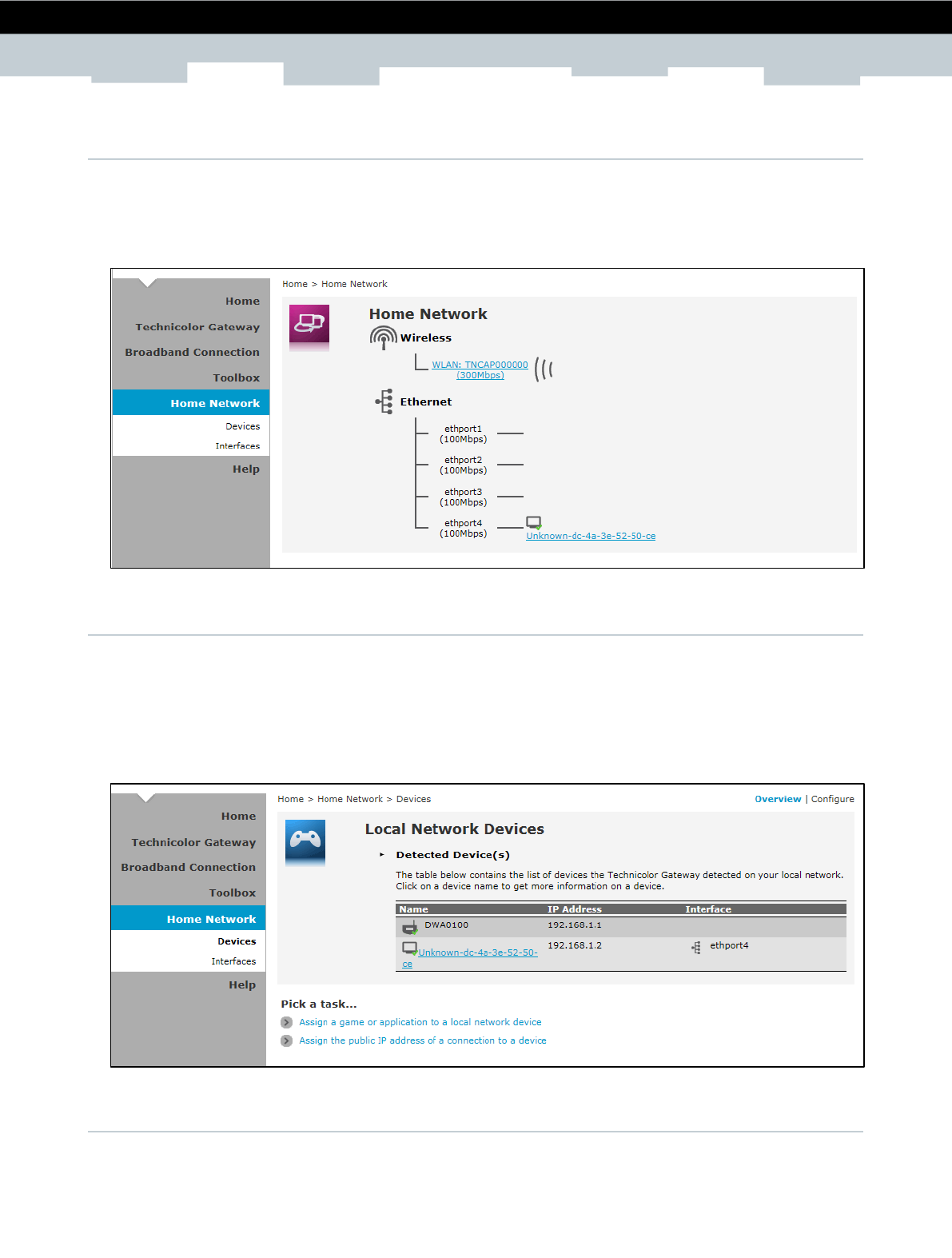
41
SETUP & USER GUIDE DWA0100
DWA0100-20170224-0000v0.0
Copyright © 2017 Technicolor. All rights reserved.
This document contains Technicolor proprietary and confidential information. Passing on and copying of this document, use,
extraction and communication of its contents, is not permitted without written authorization from Technicolor.
8 Home Network
The Home Network menu displays the network configuration of your Wireless Gateway, along with
interfaces and connected devices. This menu is divided into two sections: Devices and Interfaces.
To view the Home Network page, click Home Network on the main menu.
8.1 Devices
This page displays the devices connected on your network via the Wireless Gateway Ethernet ports. You
can do the following:
▪ View the device information, IP address and connection services
▪ Assign a public IP address to a device
To access the Devices page, click Home Network > Devices.
8.1.1 View or Modify Device Information
1 Click the device name. The device information is displayed on screen.
2 To modify the device information, click Configure on the upper right corner of the screen.
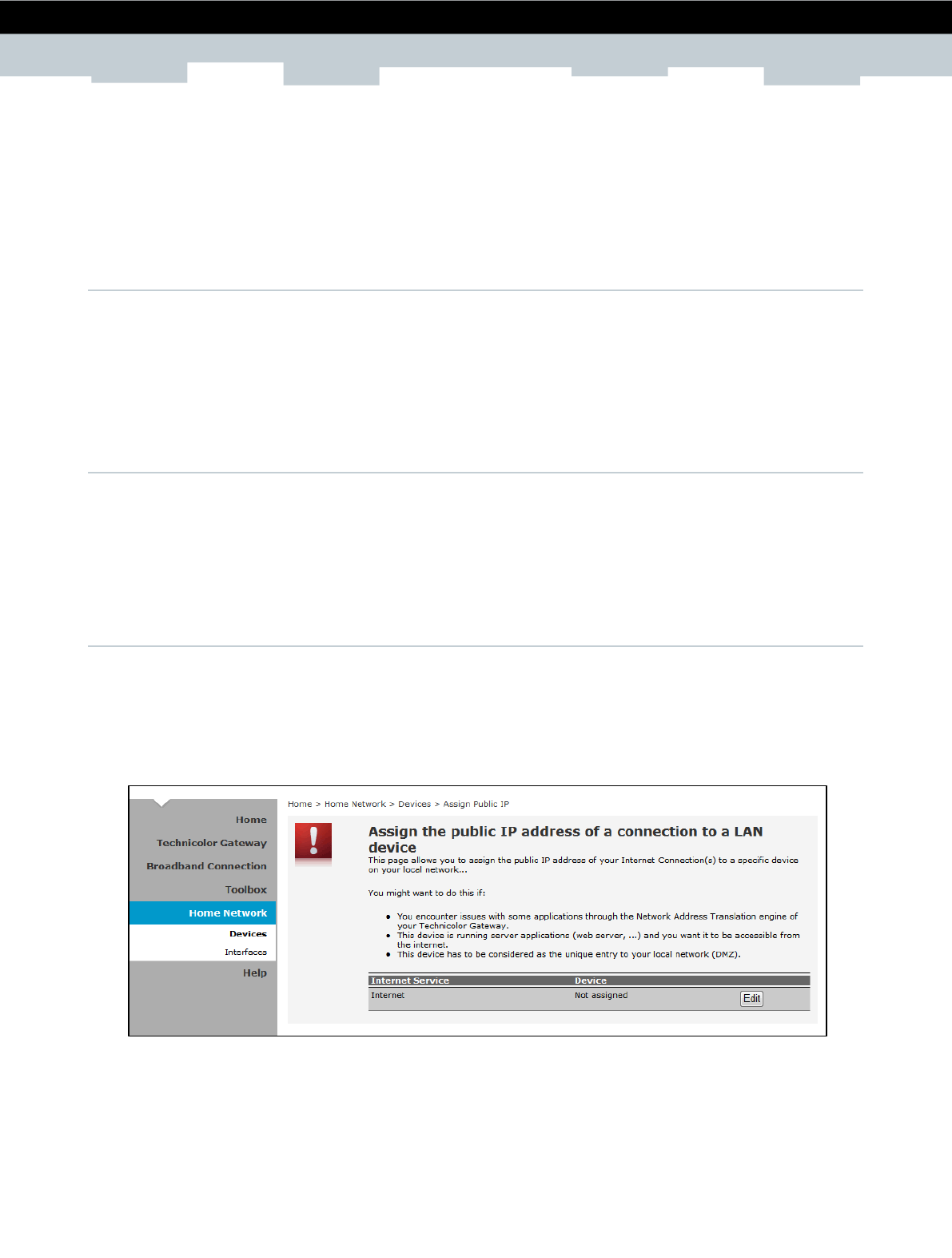
42
SETUP & USER GUIDE DWA0100
DWA0100-20170224-0000v0.0
Copyright © 2017 Technicolor. All rights reserved.
This document contains Technicolor proprietary and confidential information. Passing on and copying of this document, use,
extraction and communication of its contents, is not permitted without written authorization from Technicolor.
3 Type desired device name in New Name.
4 Select the device type in Type.
5 To assign a static IP address, check the Always use the same IP address box.
6 Click Apply to save changes.
8.1.2 Assign Game or Application to Device
1 Click the device name. The device information is displayed on screen.
2 Click Configure on the upper-right corner of the screen.
3 On the Connection Sharing section, select the game or application on the table.
4 Click Add.
8.1.3 Remove a Shared Game or Application
1 Click the device name. The device information is displayed on screen.
2 Click Configure on the upper-right corner of the screen.
3 On the Connection Sharing section, click the corresponding Unassign button of to remove the shared
game or application.
8.1.4 Assign a Public IP Address to Device
The Assign Public IP page allows you to assign the public IP address of your Internet connection to a
specific device on your local network.
1 Click Home Network > Devices.
2 Click the Assign the public IP address of a connection to a device shortcut. The Assign Public IP
screen appears.
3 Click Edit.
4 On Device, select the network device that you want to assign the public IP address.
5 Click Apply.
Or, to remove the assigned IP address from a network device, click Unassign.
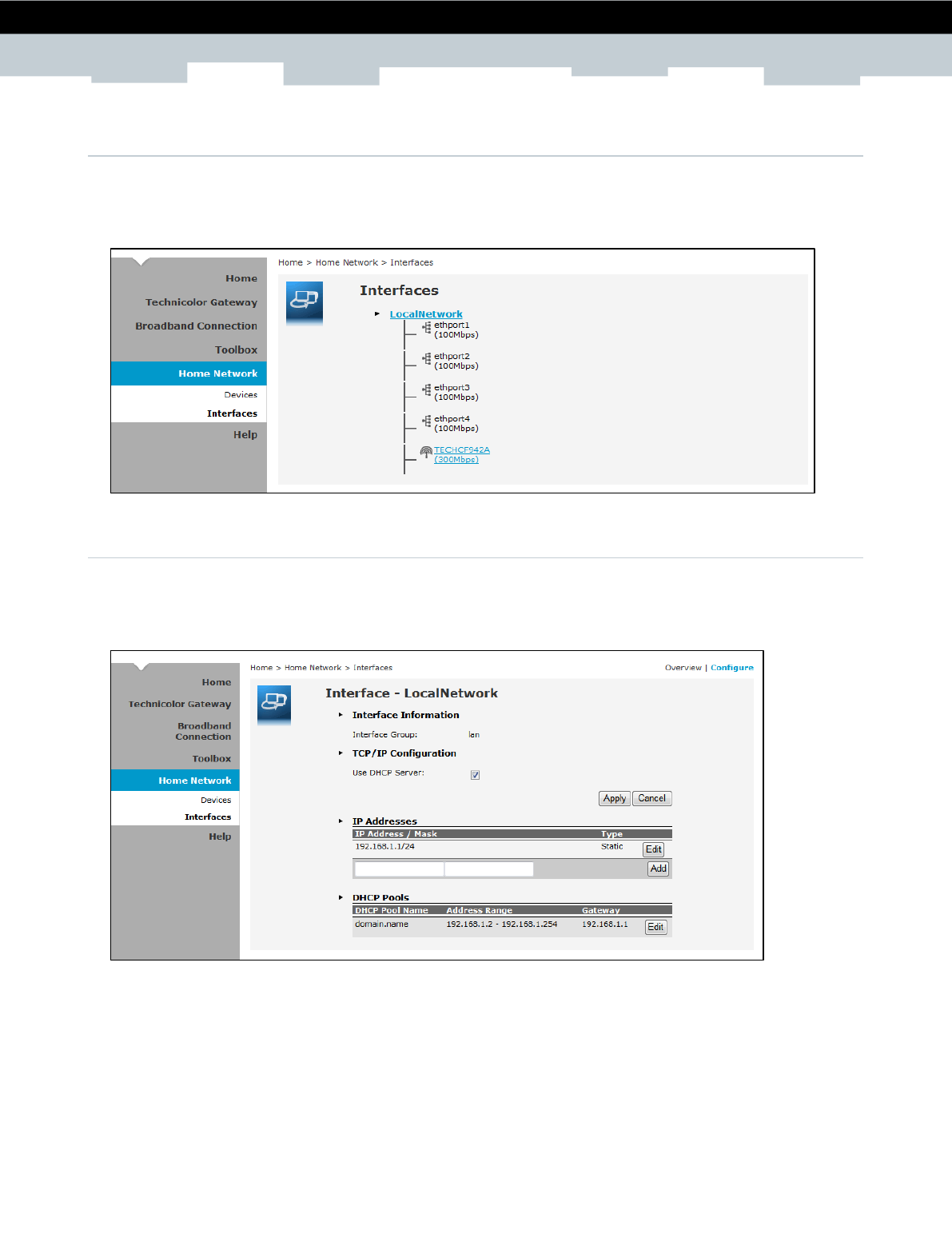
43
SETUP & USER GUIDE DWA0100
DWA0100-20170224-0000v0.0
Copyright © 2017 Technicolor. All rights reserved.
This document contains Technicolor proprietary and confidential information. Passing on and copying of this document, use,
extraction and communication of its contents, is not permitted without written authorization from Technicolor.
8.2 Interfaces
The Interfaces page allows you to configure the network device TCP/IP settings such as IP address
subnet mask, assign a DHCP server, and configure the wireless network security settings.
To view the Interfaces page, click Home Network > Interfaces.
8.2.1 Local Network Interface
Click Home Network > Interfaces > LocalNetwork to open the Local Network page.
This page displays the interface information including the TCP/IP configuration, IP Addresses, DHCP pool.
To modify the settings, click Configure on the upper-right corner of the screen.
To use a DHCP Server, check the Use DHCP Server box and then click Apply.
To Add an IP Address
1 On the IP Addresses table, type the IP address you want to add on the first box.
2 Type the subnet mask on the second box.
3 Click Add.
To Modify the IP Address
1 On the IP Addresses table, click the corresponding Edit button of the IP address you want to modify.
2 Modify the IP address (first box) and the subnet mask (second box).
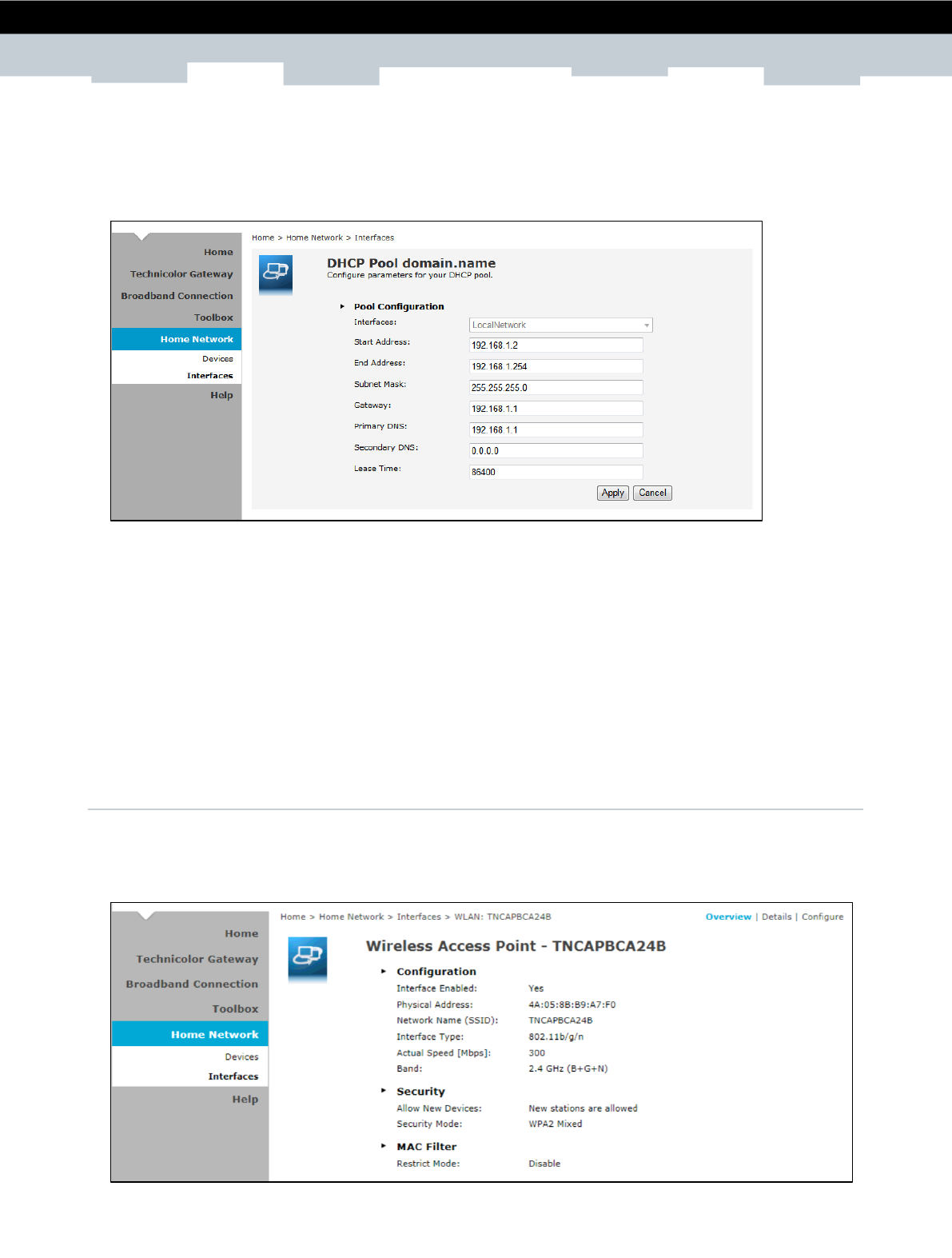
44
SETUP & USER GUIDE DWA0100
DWA0100-20170224-0000v0.0
Copyright © 2017 Technicolor. All rights reserved.
This document contains Technicolor proprietary and confidential information. Passing on and copying of this document, use,
extraction and communication of its contents, is not permitted without written authorization from Technicolor.
3 Click Apply to save changes.
To Modify the DHCP Pool
1 Click the Edit button of the pool you want to modify. The LAN_Private screen appears.
Interface — Displays the current network interface.
Start Address — Type the starting address of the DHCP pool.
End Address — Type the ending address of the DHCP pool.
Subnet Mask — Type the subnet mask.
Gateway — Type the gateway.
Primary DNS — Type the primary DNS.
Secondary DNS — Type the secondary DNS.
2 When done, click Apply.
8.2.2 Wireless Access Point
Click Home Network > Interfaces > TNCAP….. to open the Wireless Access Point page.
This page displays the information of your wireless network. To view the advanced settings, click Details
on the upper-right corner of the screen.
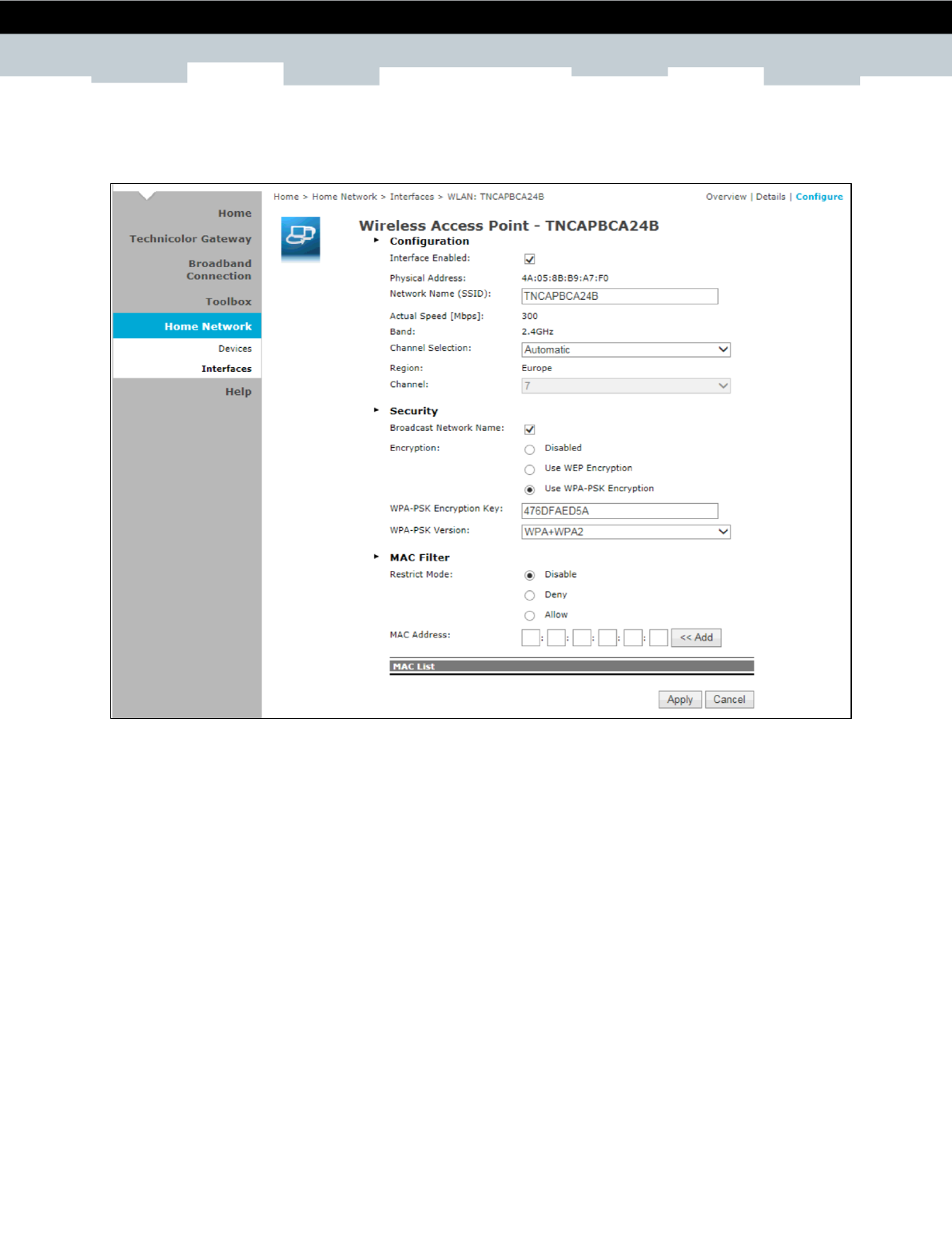
45
SETUP & USER GUIDE DWA0100
DWA0100-20170224-0000v0.0
Copyright © 2017 Technicolor. All rights reserved.
This document contains Technicolor proprietary and confidential information. Passing on and copying of this document, use,
extraction and communication of its contents, is not permitted without written authorization from Technicolor.
To Configure the Wireless Network
1 Click Configure on the upper-right corner of the screen.
2 Enter or take note of the following information:
Interface Enabled — Check to enable the wireless access point.
Physical Address — Displays the MAC address of the wireless device.
Network Name (SSID) — Enter desired wireless network name. This is the name shown to other
wireless devices to connect to your network.
Actual Speed — Displays the network speed
Band — Displays the channel band.
Channel Selection — Select the automatic or manual channel selection.
Region — Displays your current region.
Channel — If Channel Selection is set to manual, select the channel from the list.
3 If necessary, configure the security settings; see "To Set up Security Settings" on page 46.
4 Click Apply to save changes.
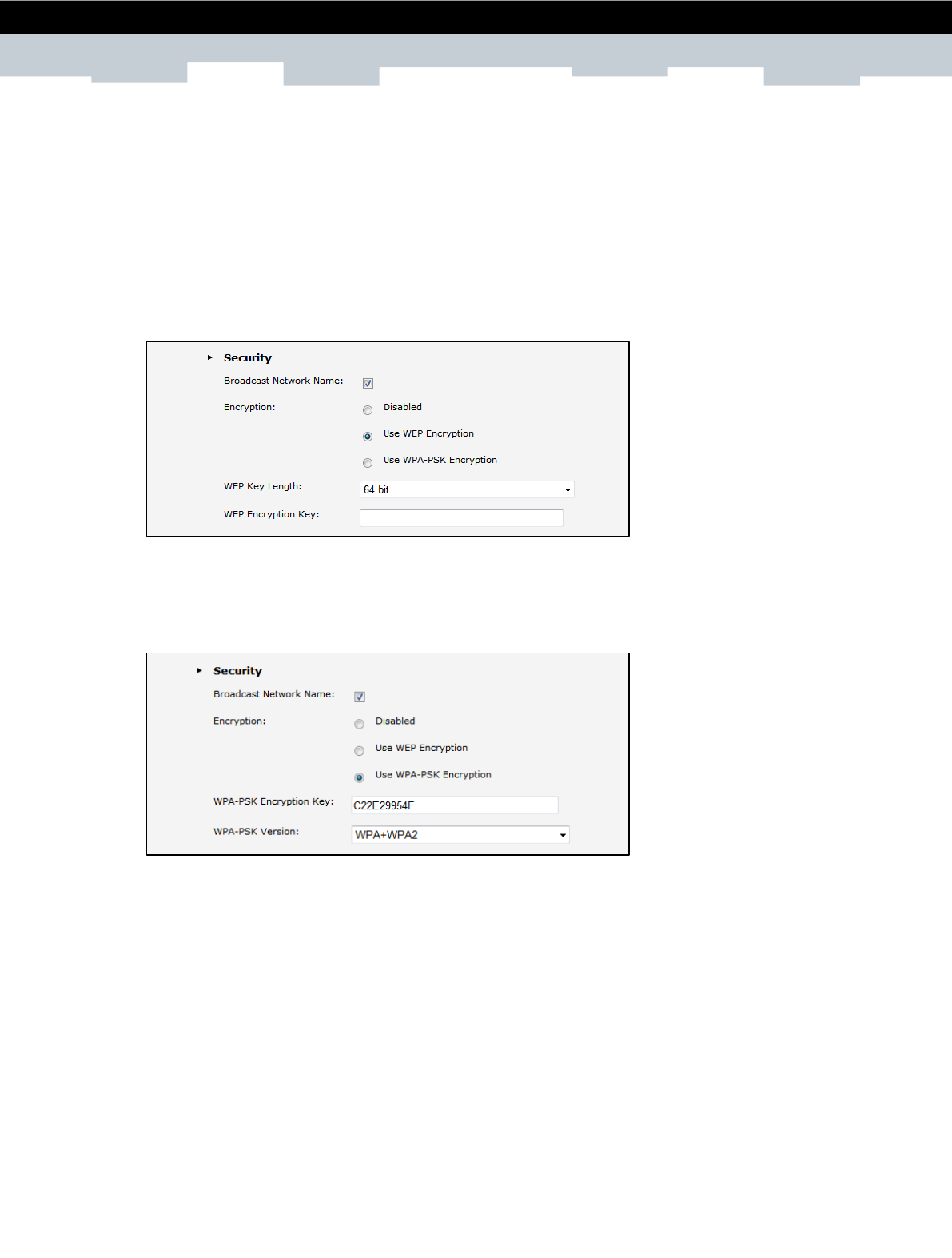
46
SETUP & USER GUIDE DWA0100
DWA0100-20170224-0000v0.0
Copyright © 2017 Technicolor. All rights reserved.
This document contains Technicolor proprietary and confidential information. Passing on and copying of this document, use,
extraction and communication of its contents, is not permitted without written authorization from Technicolor.
To Set up Security Settings
1 Click Home Network > Interfaces > WLAN to open the Wireless Access Point page.
2 Click Configure on the upper-right corner of the screen.
3 Under the Security section, check the Broadcast Network Name to enable wireless devices to see the
SSID of your wireless network.
4 On Encryption, select an encryption method:
Disabled — No encryption.
Use WEP Encryption — To use WEP encryption.
▪ WEP Key Length — Select the key length.
▪ WEP Encryption Key — Type the desired encryption key. Users need to enter this passkey to
connect to the wireless network.
Use WPA-PSK Encryption — To use a WPA-PSK encryption for more security.
▪ WPA-PSK Encryption Key — Type the desired passkey. Users need to enter this passkey to
connect to the wireless network.
▪ WPA-PSK Version — Select the WPA-PSK version to use.
5 Click Apply at the bottom of the page to save changes.
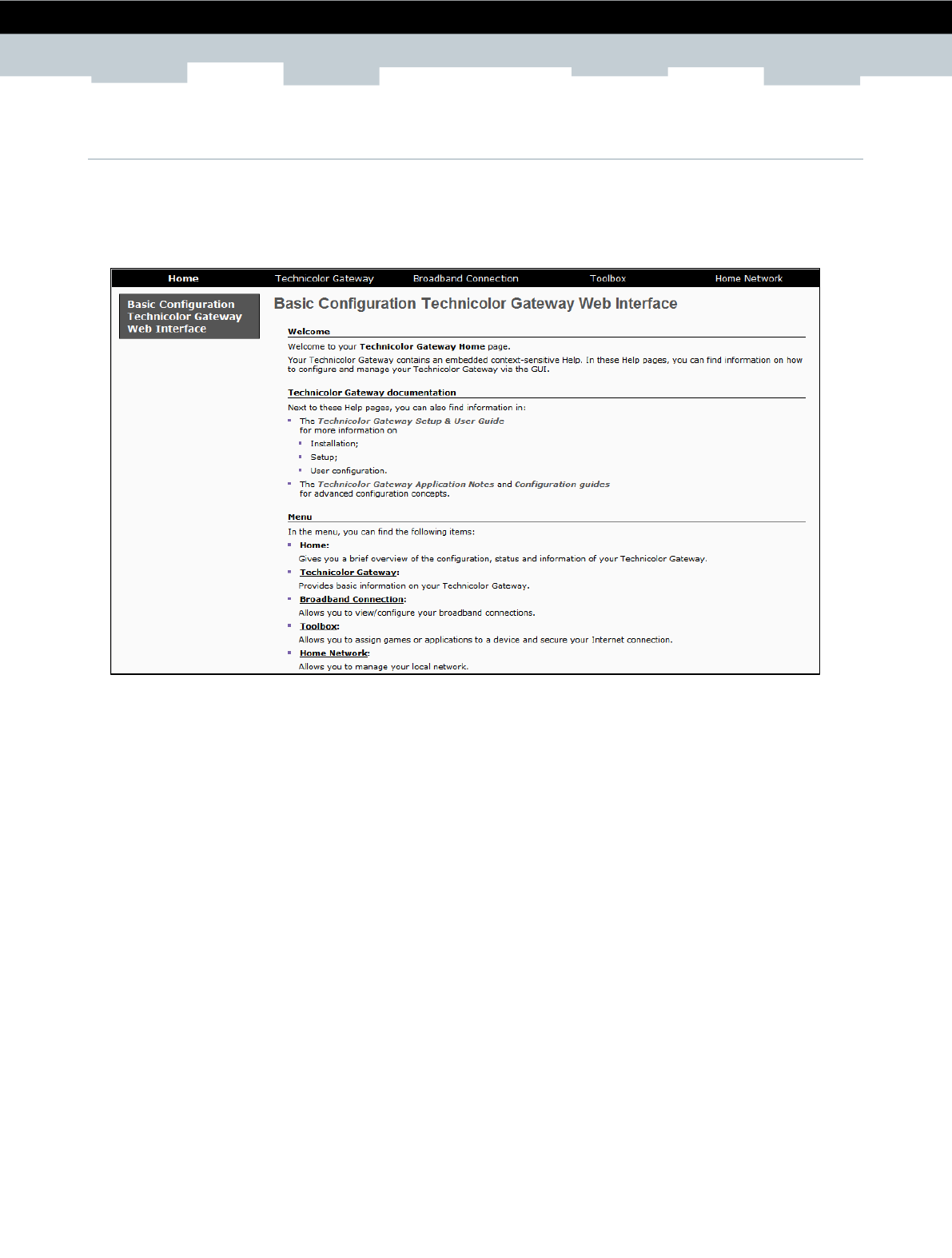
47
SETUP & USER GUIDE DWA0100
DWA0100-20170224-0000v0.0
Copyright © 2017 Technicolor. All rights reserved.
This document contains Technicolor proprietary and confidential information. Passing on and copying of this document, use,
extraction and communication of its contents, is not permitted without written authorization from Technicolor.
9 Help
Your Wireless Gateway contains an embedded context-sensitive Help. In these Help pages, you can find
information on how to configure and manage your Wireless Gateway via the GUI.
To view the Help pages, click Help on the main menu.

48
SETUP & USER GUIDE DWA0100
DWA0100-20170224-0000v0.0
Copyright © 2017 Technicolor. All rights reserved.
This document contains Technicolor proprietary and confidential information. Passing on and copying of this document, use,
extraction and communication of its contents, is not permitted without written authorization from Technicolor.
Appendix A Wireless Considerations
Connection Performance
A number of factors affect wireless connections. To ensure high-range and stable connectivity, do the
following:
1 Keep the Wireless Gateway and other wireless devices away from obstructions, such as walls or
buildings. Each obstruction can reduce the range of a wireless device.
2 Keep the Wireless Gateway and other wireless devices away from devices that produce radio
frequency (RF) noise, such as microwave ovens or radios.
3 Keep the Wireless Gateway and other wireless devices away from any device operating on the 2.4GHz
frequency, such as cordless phones or remote controls.
Security Checklist
Wireless network signals can be intercepted easily. To prevent unauthorized users from connecting to
your wireless network, follow the guidelines below.
1 Change the default wireless network name.
2 Your device has a default Service Set Identifier (SSID) which is the wireless network name. Change the
SSID with a unique name to identify your network. The SSID can be up to 32 characters in length.
3 Change the default password.
4 Your device has a default password. You have to enter this password to change your network settings.
Change the password to prevent unauthorized users from hacking into your network and changing the
settings.
5 Enable encryption.
6 Your device supports Wired Equivalent Privacy (WEP), and Wi-Fi Protected Access (WPA/WPA2)
encryption. To ensure a high level of security, enable the highest security encryption and use strong
passphrases, avoid using words that can be found in the dictionary.
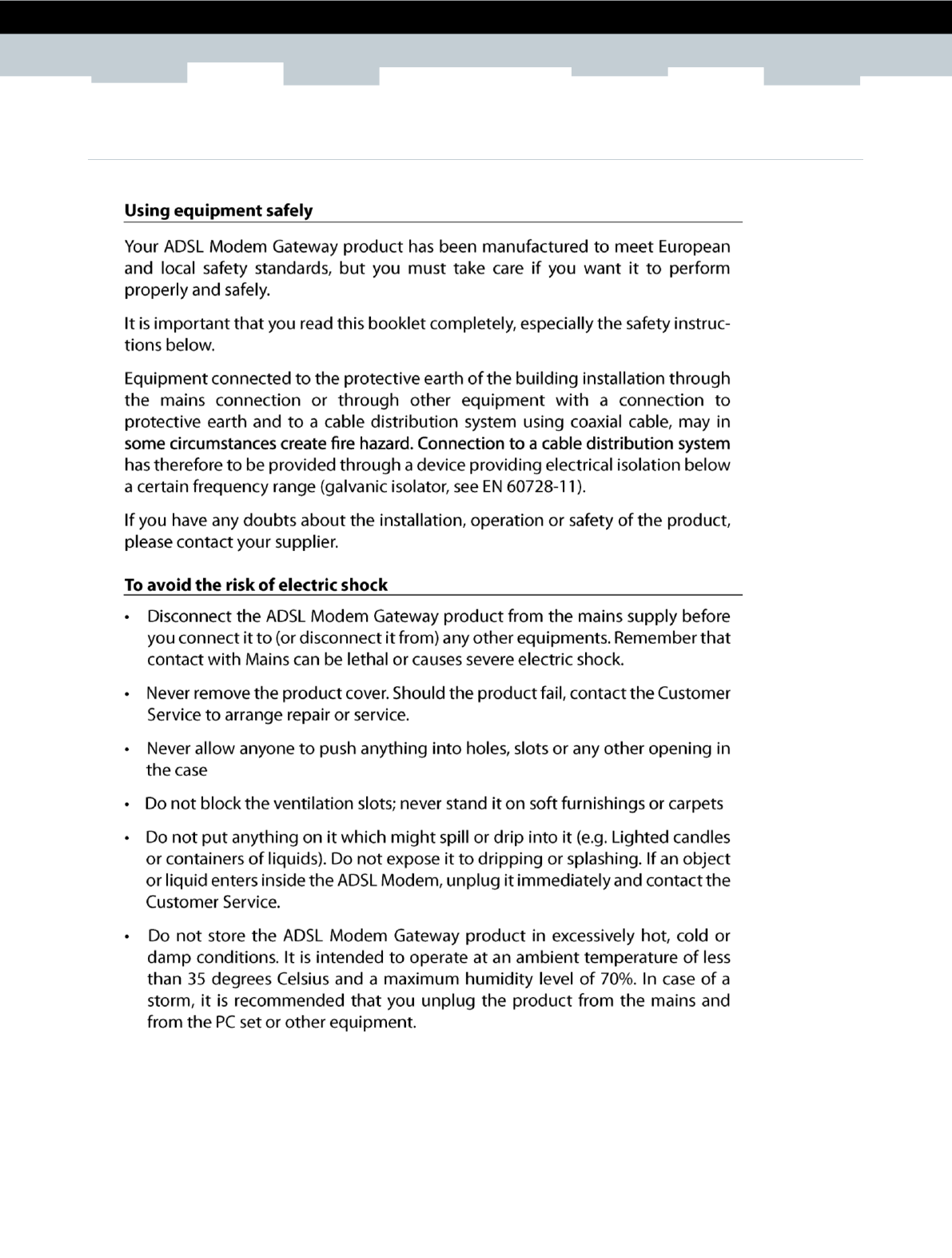
49
SETUP & USER GUIDE DWA0100
DWA0100-20170224-0000v0.0
Copyright © 2017 Technicolor. All rights reserved.
This document contains Technicolor proprietary and confidential information. Passing on and copying of this document, use,
extraction and communication of its contents, is not permitted without written authorization from Technicolor.
Appendix B Safety Instructions
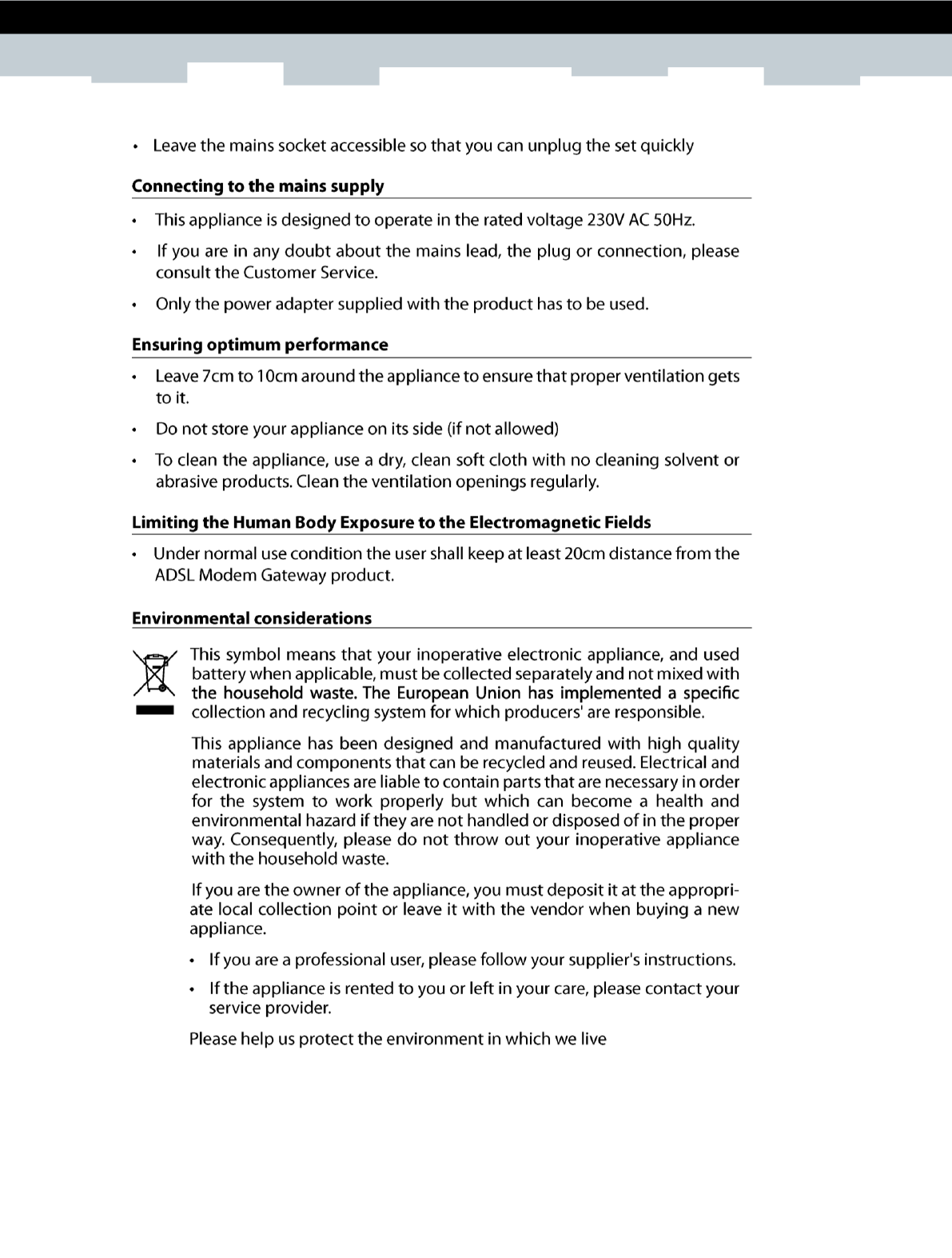
50
SETUP & USER GUIDE DWA0100
DWA0100-20170224-0000v0.0
Copyright © 2017 Technicolor. All rights reserved.
This document contains Technicolor proprietary and confidential information. Passing on and copying of this document, use,
extraction and communication of its contents, is not permitted without written authorization from Technicolor.
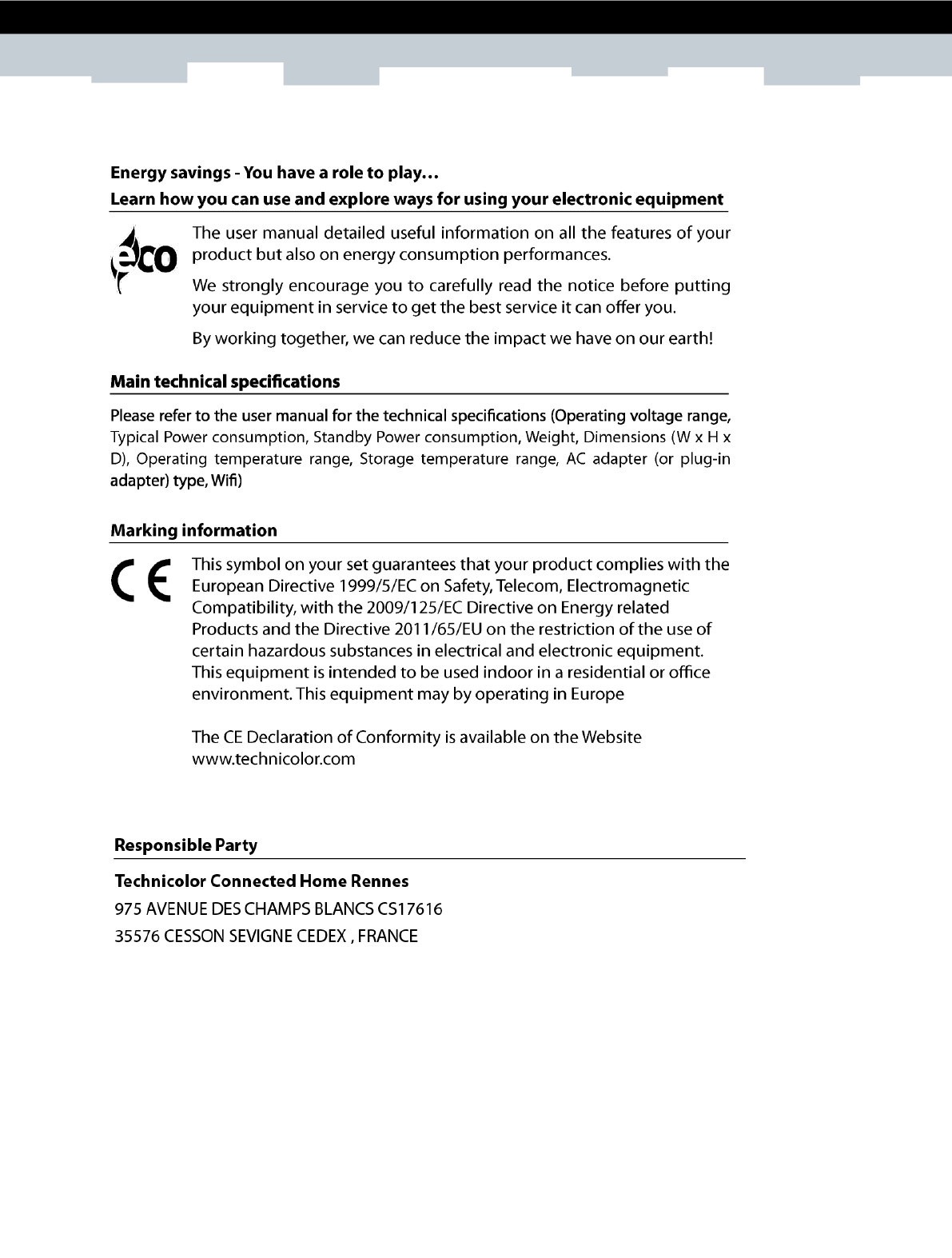
51
SETUP & USER GUIDE DWA0100
DWA0100-20170224-0000v0.0
Copyright © 2017 Technicolor. All rights reserved.
This document contains Technicolor proprietary and confidential information. Passing on and copying of this document, use,
extraction and communication of its contents, is not permitted without written authorization from Technicolor.

52
SETUP & USER GUIDE DWA0100
DWA0100-20170224-0000v0.0
Copyright © 2017 Technicolor. All rights reserved.
This document contains Technicolor proprietary and confidential information. Passing on and copying of this document, use,
extraction and communication of its contents, is not permitted without written authorization from Technicolor.
Appendix C Specifications
IC
▪ Main chip: RTL8685SF
▪ AFE: RTL8275
▪ Wi-Fi: RTL8192ER
▪ DDR2: 64 MB (embedded in CPU)
▪ Flash: 128 MB
User Interface
▪ VDSL2 (up to 30a, ADSL/ADSL2/ADSL2+ fall back): POTS
▪ 2x2 IEEE 802.11n/g/b 2.4GHz single band
▪ 4x 10/100 Base-T Ethernet LAN ports
▪ 1 x USB 2.0 Host
Buttons
▪ 1 x Power ON/OFF button
▪ 1 x WIFI/WPS BUTTON
▪ 1 x Reset to default button
LEDs
Front panel
▪ Power LED
▪ Ethernet LED
▪ Wi-Fi LED
▪ WPS LED
▪ USB LED
▪ DSL LED
▪ Internet LED
Back panel
▪ 4 x Ethernet LEDs
IO Ports
▪ 1 x RJ-11 DSL connector
▪ 4 x RJ-45 Ethernet connector
▪ 1 x USB 2.0 USB type-A, female connector
▪ 1 x DC In jack
Antenna
Standard: 2 internal printed antennas
DC input
12VDC 1A
Temperature
Operating: 0°C ~ 40° C
Storage: -10°c ~ 70°C
Humidity
Operating: 10% ~ 95%, RH, no condensation
PCB Dimensions
141 x 117 x 1.6 mm

53
SETUP & USER GUIDE DWA0100
DWA0100-20170224-0000v0.0
Copyright © 2017 Technicolor. All rights reserved.
This document contains Technicolor proprietary and confidential information. Passing on and copying of this document, use,
extraction and communication of its contents, is not permitted without written authorization from Technicolor.
Power consumption
With full loading: 10.4W
In networked Standby mode: 4.86W
*Standby mode conditions:
The functions of Fast Ethernet and WLAN are workable, but no traffic is being
transmitted.
The DSL link must be established, but no traffic is being transmitted.
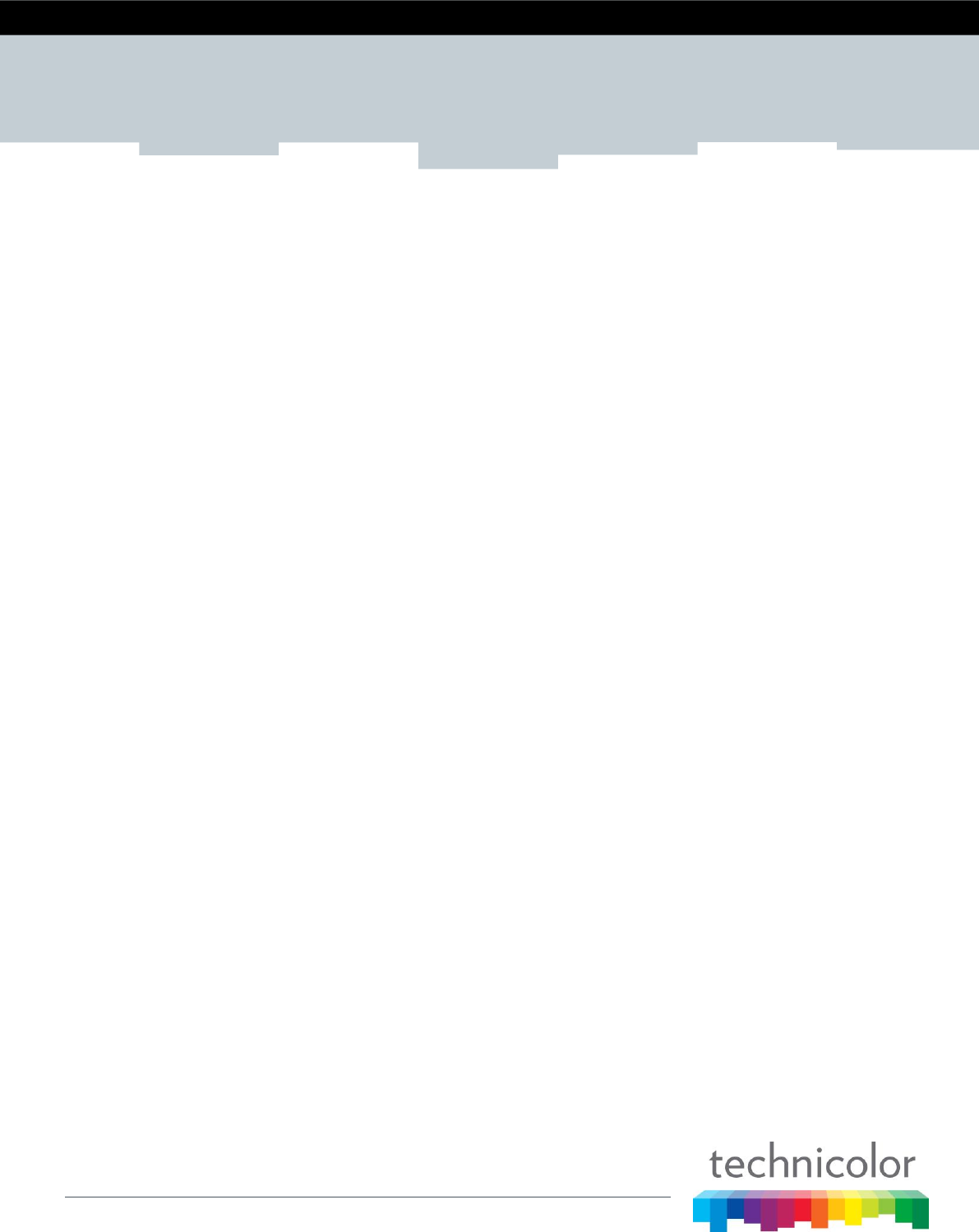
TECHNICOLOR WORLDWIDE HEADQUARTERS
1, Rue Jeanne d'Arc
92443 Issy-les-Moulineaux
France
www.technicolor.com
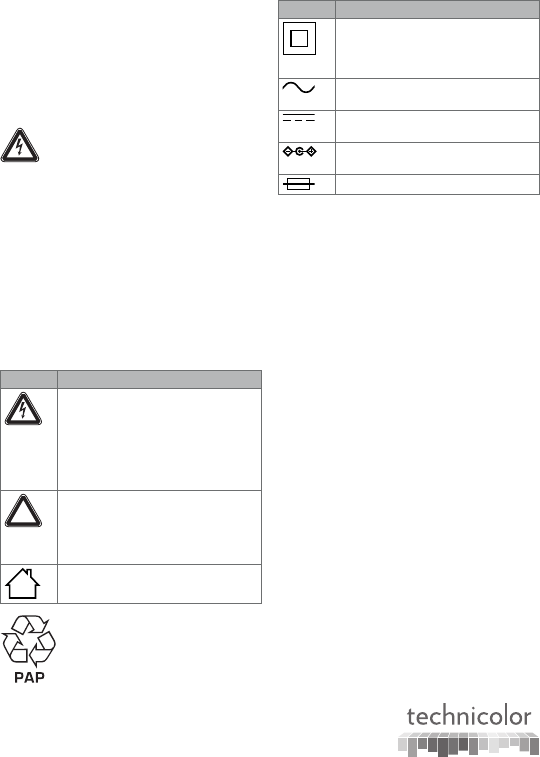
TECHNICOLOR
1-5 rue Jeanne d’Arc
92130 Issy-les-Moulineaux
France
www.technicolor.com
*DSL3745762D*
DSL3745762D
Copyright 2017 Technicolor. All rights reserved.
All tradenames referenced are service marks, trademarks, or registered trademarks of their
respective companies. Specifications subject to change without notice.
DMS3-SAF-25-159 v5.0.
SAFETY INSTRUCTIONS AND REGULATORY NOTICES
BEFORE YOU START INSTALLATION OR
USE OF THIS PRODUCT, CAREFULLY
READ ALL SAFETY INSTRUCTIONS
Applicability
These Safety Instructions and Regulatory Notices
apply to:
• Technicolor Cable Modems & Gateways
Using equipment safely
Used symbols
Following symbols may be found in this and
accompanying documentation as well as on the
product or accompanying accessories:
Directives
Product use
You must install and use this product in strict
accordance with the manufacturer's instructions
as described in the user documentation that is
included with your product.
Before you start installation or use of this product,
carefully read the contents of this document for
device specific constraints or rules that may apply
in the country where you want to use this product.
If you have any doubts about the installation,
operation or safety of this product, please contact
your supplier.
Any change or modification made to this product
that is not expressly approved by Technicolor will
result in the loss of product warranty and may
void the user's authority to operate this
equipment. Technicolor disclaims all responsibility
in the event of use that does not comply with the
present instructions.
Software and firmware use
The firmware in this equipment is protected by
copyright law. You may only use the firmware in
the equipment in which it is provided. Any
reproduction or distribution of this firmware, or
any portion of it, without express written consent
from Technicolor is prohibited.
!
When using this product, always follow
the basic safety precautions to reduce the
risk of fire, electric shock and injury to
persons, including the following:
• Always install the product as described
in the documentation that is included
with your product.
• Do not use this product to report a gas
leak in the vicinity of the leak.
• Avoid using this product during an
electrical storm. There may be a
remote risk of electric shock from
lightning.
Symbol Indication
This symbol is intended to alert you
that uninsulated voltage within this
product may have sufficient
magnitude to cause electric shock.
Therefore, it is dangerous to make any
kind of contact with any inside part of
this product.
This symbol is intended to alert you of
the presence of important operating
and maintenance (servicing)
instructions in the documentation that
is included with your product.
This symbol indicates for indoor use
only (IEC 60417-5957).
!
This symbol indicates Double
insulated Class II equipment
(IEC 60417-5172). Does not require
an earth connection.
This symbol indicates Alternating
Current (AC).
This symbol indicates Direct Current
(DC).
This symbol indicates Electrical
polarity.
This symbol indicates Fuse.
Symbol Indication

2
Software described in this document is protected
by copyright law and furnished to you under a
license agreement. You may only use or copy this
software in accordance with the terms of your
license agreement.
Open Source Software notification
The software of this product may contain certain
open source software modules which are subject
to Open Source Software license terms (see
https://opensource.org/osd for definition). Such
Open Source Software components and/or
versions may change in the future versions of the
software product.
A list of the Open Source Software used or
provided as embedded into the current software
of the product and their corresponding licenses
and version number are, to the extent required by
applicable terms, available on Technicolor's
website at the following address:
www.technicolor.com/en/hi/minisites/open-
software or at another address as Technicolor may
provide from time to time.
If and where applicable, depending on the terms
of the applicable Open Source Software licenses,
the source code of the Open Source Software is
available for free upon request.
For avoidance of doubt, Open Source Software is
only licensed by the original owner of the Open
Source Software under the terms set forth in the
designated Open Source License.
Environmental information
Batteries (if applicable)
Batteries contain hazardous substances
which pollute the environment. Do not
dispose of them with other articles.
Take care to dispose them at special
collecting points.
Recycle or dispose of batteries in
accordance with the battery
manufacturer’s instructions and local/
national disposal and recycling
regulations.
Energy efficiency
Energy savings
The user documentation that is included with
your product not only provides useful information
on all the features of your product, but also on its
energy consumption. We strongly encourage you
to carefully read this documentation before
putting your equipment in service in order to get
the best service it can offer you.
Safety instructions
Climatic conditions
This product:
• Is intended for in-house stationary use; the
maximum ambient temperature must not
exceed 40 °C (104 °F); the relative humidity
must be between 20 and 80 %.
• Must not be mounted in a location exposed to
direct or excessive solar and/or heat radiation.
• Must not be exposed to heat trap conditions
and must not be subjected to water or
condensation.
• Must be installed in a Pollution Degree 2
environment (an environment where there is no
pollution or only dry, non-conductive pollution).
If applicable, batteries (battery pack or batteries
installed) must not be exposed to excessive heat
such as sunshine, fire or the like.
Ventilation and positioning
This product is intended to be used indoors in a
residential or office environment.
• Remove all packaging material before applying
power to the product.
• Place and use the product only in positions as
described in the user documentation that is
included with your product.
• Do not block or cover any ventilation openings;
never stand it on soft furnishings or carpets.
• Never push objects through the openings in
this product.
• Leave 7 to 10 cm (3 to 4 inches) around the
product to ensure that proper ventilation gets
to it.
• Do not install the product near any heat sources
such as radiators, heat registers, stoves, or other
apparatus (including amplifiers) that produce
heat.
• Do not put anything on it which might spill or
drip into it (for example, lighted candles or
containers of liquids). Do not expose it to
dripping or splashing, rain or moisture. If a liquid
enters inside the product, or if the product has
been exposed to rain or moisture, unplug it
immediately and contact your supplier or
customer service.
Cleaning
Unplug this product from the wall socket and
disconnect from all other devices before cleaning.
Do not use liquid cleaners or aerosol cleaners.
Use a damp cloth for cleaning.
!
• Read these instructions.
• Keep these instructions.
• Heed all warnings and cautions.
• Follow all instructions.

3
Water and moisture
Do not use this product near water, for example
near a bathtub, washbowl, kitchen sink, laundry
tub, in a wet basement or near a swimming pool.
Transition of the product from a cold environment
to a warm one may cause condensation on some
of its internal parts. Allow it to dry by itself before
using the product.
Electrical powering
The powering of the product must adhere to the
power specifications indicated on the marking
labels.
In case this product is powered by a power supply
unit:
•For USA and Canada: This product is intended
to be supplied by a UL listed Direct Plug-
inPower Unit marked "Class 2" and rated as
indicated on the label on your product.
• This power supply unit must be Class II and a
Limited Power Source in accordance with the
requirements of IEC 60950-1/ EN 60950-1,
Clause 2.5 and rated as indicated on the label
on your product. It must be tested and
approved to national, or local standards.
Accessibility
The plug on the power supply cord or power
supply unit serves as disconnect device. Be sure
that the mains supply socket outlet you use is
easily accessible and located as close to the
product as possible.
The power connections to the product and the
mains supply socket outlet socket must be
accessible at all times, so that you always can
disconnect the product quickly and safely from
the mains supply.
Overloading
Do not overload mains supply socket outlets and
extension power cords as this increases the risk of
fire or electric shock.
Handling batteries
This product may contain disposable batteries.
• Insert batteries correctly. There may be a risk of
explosion if the batteries are incorrectly
inserted.
• Do not attempt to recharge disposabal or non-
reusable batteries.
• Please follow instructions provided for charging
rechargeable batteries.
• Replace batteries with the same or equivalent
type.
• Do not expose batteries to excessive heat (such
as sunlight or fire) and to temperatures above
100 °C (212 °F).
Cable Distribution
For this apparatus, the cable shield/screen shall be
grounded (earthed) as close as practical to the
point of entry of the cable into the building.
For products sold in the USA and Canada, this
reminder is provided to call the system installer's
attention to ANSI/NFPA 70, the National
Electrical Code (NEC), in particular Section
820.93, Grounding of Outer Conductive Shield
of a Coaxial Cable (or Canadian Electrical Code
Part 1).
Servicing
If service or repair work is required, take it to a
qualified service dealer.
Damage requiring service
Unplug this product from the mains supply socket
outlet and refer servicing to qualified service
personnel under the following conditions:
• When the power supply, power cord or its plug
are damaged.
• When the attached cords are damaged or
frayed.
• If liquid has been spilled into the product.
• If the product has been exposed to rain or
water.
• If the product does not operate normally.
!
Only use the power supply unit that is
supplied with this product, is supplied by
your service provider or local product
supplier, or a replacement power supply
unit provided by your service provider or
local product supplier.
The use of other types of power supplies
is prohibited.
If you are not sure of the type of power
supply needed, consult the user
documentation that is included with your
product or contact your service provider
or local product supplier.
!
CAUTION
There is danger of explosion if the
battery is mishandled or incorrectly
replaced. Replace only with the same or
equivalent type of battery. Do not
disassemble it or attempt to recharge it
outside the system.
Do not disassemble, crush, puncture,
short the external contacts, dispose of in
fire, or expose to fire, water or other
liquids.
!
To reduce the risk of electric shock or
electrocution, do not disassemble this
product.
4
• If the product has been dropped or damaged in
any way.
• There are noticeable signs of overheating.
• If the product exhibits a distinct change in
performance.
• If the product is giving off smoke or a burning
smell.
Protect the product when moving it
Always disconnect the power source when
moving the product or connecting or
disconnecting cables.
Interface classifications (upon applicability)
The external interfaces of the product are
classified as follows:
• Cable (IN/OUT): TNV circuit, not subjected
to overvoltages (TNV-1)
• Phone, FXS: TNV (Telecommunications
Network Voltage ) circuit, not subjected to
overvoltages (TNV-2)
• MoCA, HPNA, RF: TNV circuit, not subjected
to overvoltages (TNV-1)
• All other interface ports (e.g. Ethernet, USB,...),
including the low voltage power input from the
AC mains power supply: SELV (Safety Extra-
Low Voltage) circuits.
Regulatory information
North-America - Canada
Notification of Canadian Radio Frequency
interference statement
This Class B digital apparatus complies with
Canadian ICES-003.
This product meets the applicable Innovation,
Science and Economic Development Canada
technical specifications.
Canada - Radiation exposure statement
This equipment complies with IC radiation
exposure limits set forth for an uncontrolled
environment. This equipment should be installed
and operated with minimum distance 30 cm
(12 inches) between the radiator and your body.
Canada - Industry Canada (IC)
In case this product is equipped with a wireless
transceiver, this device complies with Industry
Canada’s licence-exempt RSSs. Operation is
subject to the following two conditions: (1) This
device may not cause interference; and (2) This
device must accept any interference, including
interference that may cause undesired operation
of the device.
Restricted frequency bands
In case this product is equipped with a wireless
transceiver operating in the 2.4 GHz band, it may
only use channels 1 to 11 (2412 to 2462 MHz) on
Canada territory.
In case this product is equipped with a wireless
transceiver operating in the 5 GHz band, it is for
indoor use only.
The availability of some specific channels and/or
operational frequency bands are country
dependent and are firmware programmed at the
factory to match the intended destination. The
firmware setting is not accessible by the end user.
North-America - United States of America
Important safety instructions
• The cable distribution system should be
grounded (earthed) in accordance with ANSI/
NFPA 70, the National Electrical Code (NEC),
in particular Section 820,93, Grounding of outer
Conductive Shield of a Coaxial Cable.
• Leave 5 to 8 cm (2 to 3 inches) around the
product to ensure proper ventilation to it.
• Never push objects through the openings in
this product.
Federal Communications Commission (FCC)
radio frequency interference statement
This equipment has been tested and found to
comply with the limits for a Class B digital device,
pursuant to Part 15 of the FCC Rules. These
limits are designed to provide reasonable
protection against harmful interference in a
residential installation. This equipment generates,
uses and can radiate radio frequency energy and,
if not installed and used in accordance with the
instructions, may cause harmful interference to
radio communications. However, there is no
guarantee that interference will not occur in a
particular installation. If this equipment does
cause harmful interference to radio or television
reception, which can be determined by turning
the equipment off and on, the user is encouraged
to try to correct the interference by one or more
of the following measures:
• Reorient or relocate the receiving antenna.
• Increase the separation between the equipment
and receiver.
• Connect the equipment into an outlet on a
circuit different from that to which the receiver
is connected.

5
• Consult the dealer or an experienced radio/TV
technician for help.
FCC Caution: Any changes or modifications not
expressly approved by the party responsible for
compliance could void the user's authority to
operate this equipment.
Responsible Party: Technicolor, 101W. 103rd St.,
Indianapolis, IN 46290 USA, 317-587-5466.
RF exposure statement
This equipment complies with FCC radiation
exposure limits set forth for an uncontrolled
environment. End users must follow the specific
operating instructions for satisfying RF exposure
compliance. To maintain compliance with FCC
RF exposure compliance requirements, please
follow operation instruction as documented in the
product documentation.
When the product is equipped with a wireless
interface, then it becomes a mobile or fixed
mounted modular transmitter and must have a
separation distance of at least 30 cm (12 inches)
between the antenna and the body of the user or
nearby persons. In practice, this means that the
user or nearby persons must have a distance of at
least 30 cm (12 inches) from the product and
must not lean on the product in case it is wall-
mounted.
With a separation distance of 30 cm (12 inches) or
more, the M(aximum) P(ermissible) E(xposure)
limits are well above the potential this wireless
interface is capable to produce.
This transmitter must not be co-located or
operating in conjunction with any other antenna
or transmitter.
Restricted frequency bands
In case this product is equipped with a wireless
transceiver operating in the 2.4 GHz band, it can
only use channels 1 to 11 (2412 to 2462 MHz) on
U.S.A. territory.
In case this product is equipped with a wireless
transceiver operating in the 5 GHz band, it meets
all the other requirements specified in Part 15E,
Section 15.407 of the FCC Rules.
The availability of some specific channels and/or
operational frequency bands are country
dependent and are firmware programmed at the
factory to match the intended destination. The
firmware setting is not accessible by the end user.
This device complies with Part 15 of the
FCC Rules. Operation is subject to the
following two conditions: (1) this device
may not cause harmful interference, and
(2) this device must accept any
interference received, including
interference that may cause undesired
operation.

Customer Information FCC Part 68
Customer information required for Telephone Terminal Equipment (“TTE”)
approved for connection to the Public Switched Telephone Network
(“PSTN”), pursuant to 47 CFR §68.218(b)(1)e
FCC Part 68 Compliancy for equipment TG788v v3
This equipment complies with Part 68 of the FCC rules and the requirements adopted by the ACTA. On the
bottom of this equipment is a label that contains, among other information, a product identifier in the format
US:AAAEQ##TXXXX. If requested, this number must be provided to the telephone company.
Based upon the information on the grant US: TMBDL01ATG788VV3HP, this equipment TG788v v3 uses
Certification jack Universal Service Order Code (“USOC”): RJ-11C.
A plug and jack used to connect this equipment to the premises wiring and telephone network must comply
with the applicable FCC Part 68 rules and the requirements adopted by the ACTA. A compliant telephone
cord and a modular plug is provided with this product. It is designed to be connected to a compatible
modular jack that is also compliant. See installation instructions for details.
The REN is used to determine the number of devices that may be connected to a telephone line.
Excessive RENs on a telephone line may result in the devices not ringing in response to an incoming call.
In most but not all areas, the sum of the RENs should not exceed five (5.0). To be certain of the number of
the devices that may be connected to a line, as determined by the total RENs, contact the local telephone
company. For products approved after July 23, 2001, the REN for this product is part of the product
identifier that has the format US:AAAEQ##TXXXX. The digits represented by ## are the REN without a
decimal point (e.g., 01 is a REN of 0.1). For earlier products, the REN is separately shown on the label.
If this equipment DWA0100 causes harm to the telephone network, the telephone company will notify you
in advance that the temporary discontinuance of service may be required. But if advance notice isn’t
practical, the telephone company will notify the customer as soon as possible. Also, you will be advised of
your right to file complaint with the FCC if you believe it is necessary.
The telephone company may make changes in its facilities, equipment, operations or procedures that
could affect the operation of the equipment. If this happens, the telephone company will provide advance
notice in order to make necessary modifications to maintain uninterrupted service.
If trouble is experienced with this equipment DWA0100, for repair or warranty information, please contact:
Technicolor, 101W. 103rd St., Indianapolis, IN 46290 USA, Phone: 317-587-5466.
If the equipment is causing harm to the telephone network, the telephone company may request that you
disconnect the equipment until the problem is resolved.
The equipment DWA0100 is not intended to be repaired by the customer.
Connection to party lines service is subject to state tariffs. Contact the state public utility commission,
public service commission or corporation commission for the information.
If your home has specially wired alarm equipment connected to the telephone line, ensure that the
installation of this equipment DWA0100 does not disable your alarm equipment. If you have questions
about what will disable alarm equipment, consult your telephone company or qualified installer.
Electrical Safety Advisory
As Electrical surges, typically lightning transients, are very destructive to customer terminal equipment that
is powered by AC power sources, the customer is advised to provide a surge arrestor on the AC mains
supply.
DMS3-SAF-25-468 v1.0
Copyright © 2017 Technicolor. All rights reserved.
DWA0100
MSCDL01ADWA0100 DWA0100